Sales and Working Capital Management
VerifiedAdded on 2020/01/07
|57
|20980
|337
Essay
AI Summary
A review of working capital management practices revealed that organizations have different approaches to managing their working capitals. The operating cycle, installed capacity, and used capacity were cited as means to ensure a controlled state of working capital. Some respondents reviewed norms quarterly or monthly, while others assessed working capital yearly. Shortages and surpluses of working capital occurred frequently, with fluctuations in pricing, credit periods, and client payments being major reasons. Effective management of working capital led to cost savings and enhanced profitability for some organizations.
Contribute Materials
Your contribution can guide someone’s learning journey. Share your
documents today.
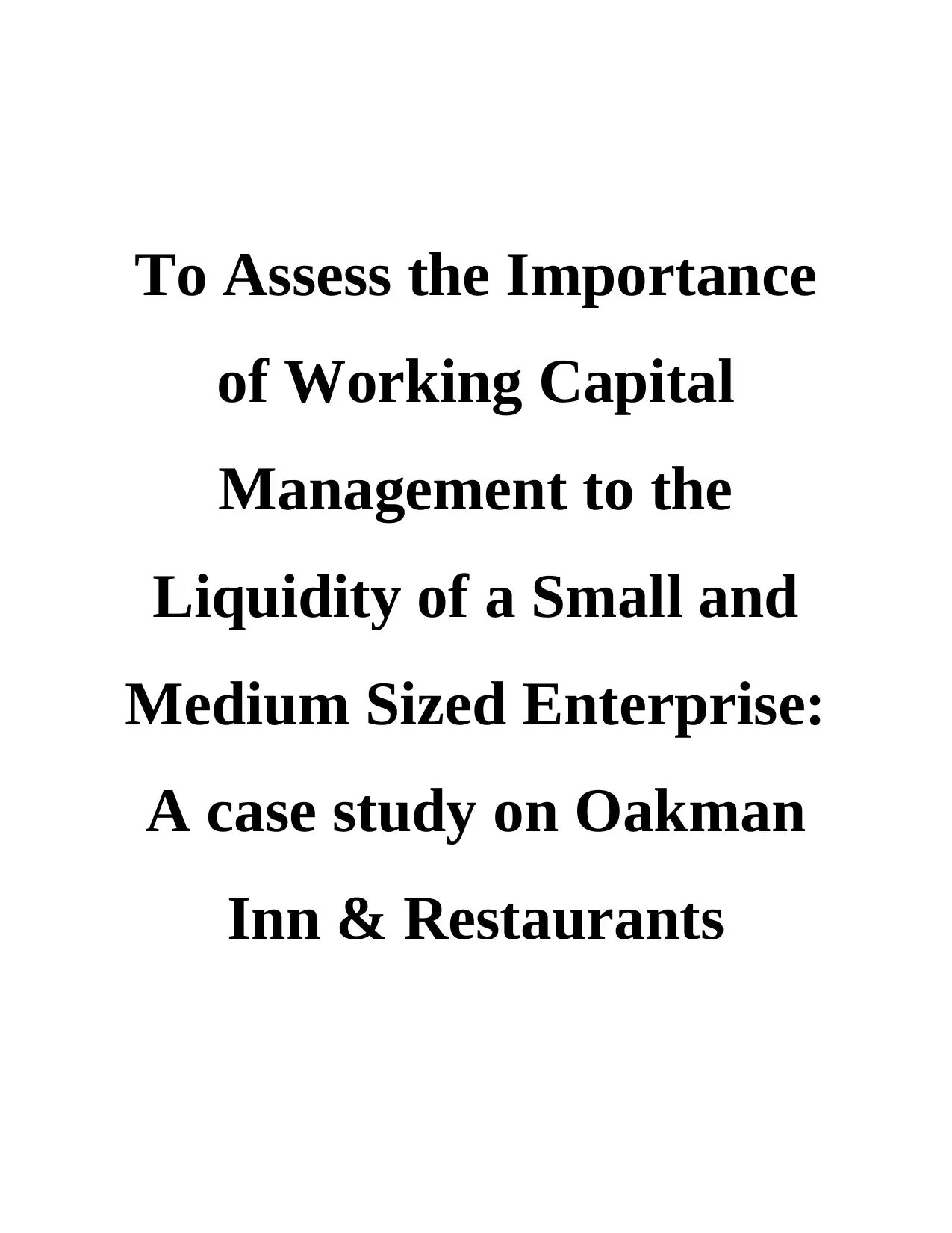
To Assess the Importance
of Working Capital
Management to the
Liquidity of a Small and
Medium Sized Enterprise:
A case study on Oakman
Inn & Restaurants
of Working Capital
Management to the
Liquidity of a Small and
Medium Sized Enterprise:
A case study on Oakman
Inn & Restaurants
Secure Best Marks with AI Grader
Need help grading? Try our AI Grader for instant feedback on your assignments.
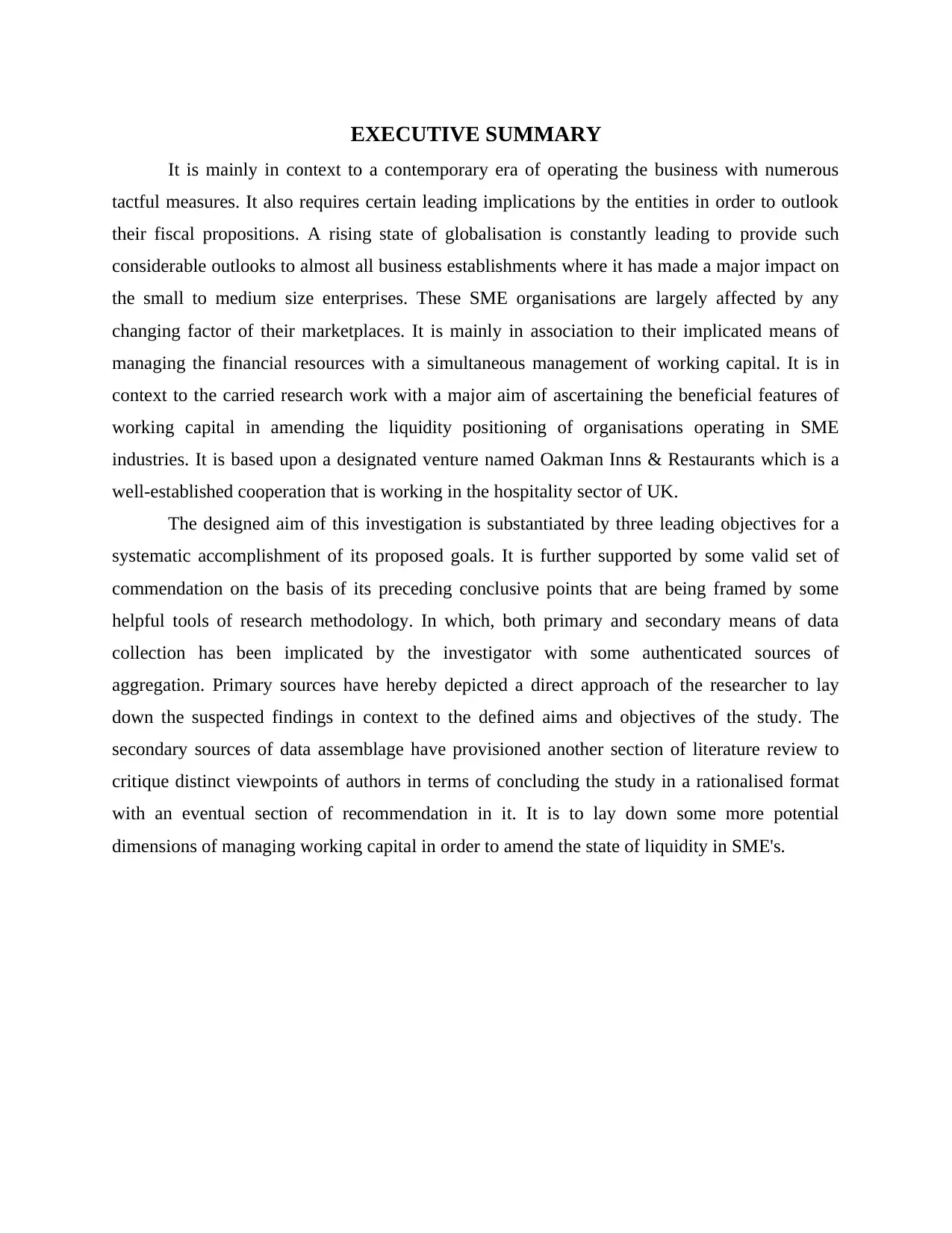
EXECUTIVE SUMMARY
It is mainly in context to a contemporary era of operating the business with numerous
tactful measures. It also requires certain leading implications by the entities in order to outlook
their fiscal propositions. A rising state of globalisation is constantly leading to provide such
considerable outlooks to almost all business establishments where it has made a major impact on
the small to medium size enterprises. These SME organisations are largely affected by any
changing factor of their marketplaces. It is mainly in association to their implicated means of
managing the financial resources with a simultaneous management of working capital. It is in
context to the carried research work with a major aim of ascertaining the beneficial features of
working capital in amending the liquidity positioning of organisations operating in SME
industries. It is based upon a designated venture named Oakman Inns & Restaurants which is a
well-established cooperation that is working in the hospitality sector of UK.
The designed aim of this investigation is substantiated by three leading objectives for a
systematic accomplishment of its proposed goals. It is further supported by some valid set of
commendation on the basis of its preceding conclusive points that are being framed by some
helpful tools of research methodology. In which, both primary and secondary means of data
collection has been implicated by the investigator with some authenticated sources of
aggregation. Primary sources have hereby depicted a direct approach of the researcher to lay
down the suspected findings in context to the defined aims and objectives of the study. The
secondary sources of data assemblage have provisioned another section of literature review to
critique distinct viewpoints of authors in terms of concluding the study in a rationalised format
with an eventual section of recommendation in it. It is to lay down some more potential
dimensions of managing working capital in order to amend the state of liquidity in SME's.
It is mainly in context to a contemporary era of operating the business with numerous
tactful measures. It also requires certain leading implications by the entities in order to outlook
their fiscal propositions. A rising state of globalisation is constantly leading to provide such
considerable outlooks to almost all business establishments where it has made a major impact on
the small to medium size enterprises. These SME organisations are largely affected by any
changing factor of their marketplaces. It is mainly in association to their implicated means of
managing the financial resources with a simultaneous management of working capital. It is in
context to the carried research work with a major aim of ascertaining the beneficial features of
working capital in amending the liquidity positioning of organisations operating in SME
industries. It is based upon a designated venture named Oakman Inns & Restaurants which is a
well-established cooperation that is working in the hospitality sector of UK.
The designed aim of this investigation is substantiated by three leading objectives for a
systematic accomplishment of its proposed goals. It is further supported by some valid set of
commendation on the basis of its preceding conclusive points that are being framed by some
helpful tools of research methodology. In which, both primary and secondary means of data
collection has been implicated by the investigator with some authenticated sources of
aggregation. Primary sources have hereby depicted a direct approach of the researcher to lay
down the suspected findings in context to the defined aims and objectives of the study. The
secondary sources of data assemblage have provisioned another section of literature review to
critique distinct viewpoints of authors in terms of concluding the study in a rationalised format
with an eventual section of recommendation in it. It is to lay down some more potential
dimensions of managing working capital in order to amend the state of liquidity in SME's.
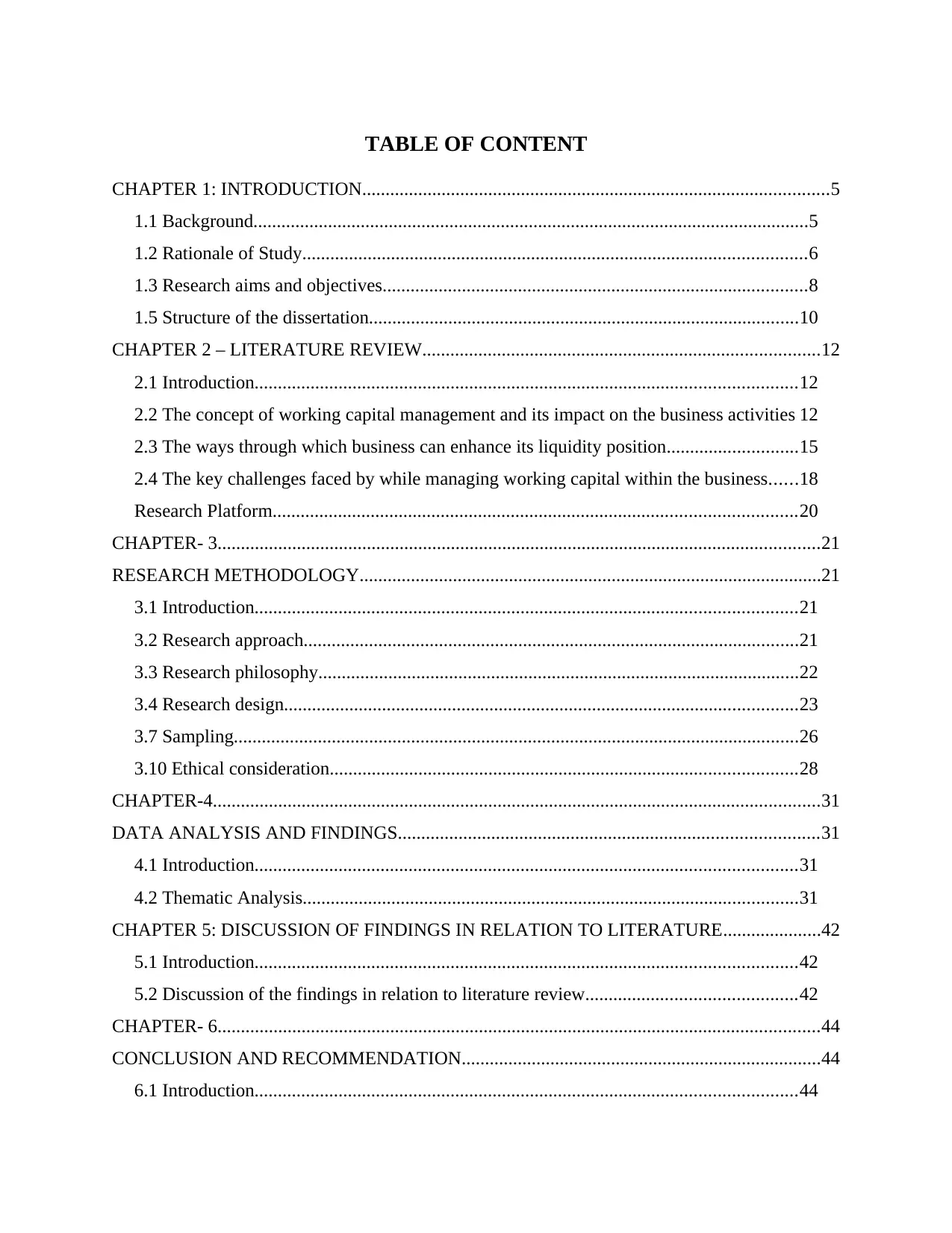
TABLE OF CONTENT
CHAPTER 1: INTRODUCTION....................................................................................................5
1.1 Background.......................................................................................................................5
1.2 Rationale of Study............................................................................................................6
1.3 Research aims and objectives...........................................................................................8
1.5 Structure of the dissertation............................................................................................10
CHAPTER 2 – LITERATURE REVIEW.....................................................................................12
2.1 Introduction....................................................................................................................12
2.2 The concept of working capital management and its impact on the business activities 12
2.3 The ways through which business can enhance its liquidity position............................15
2.4 The key challenges faced by while managing working capital within the business......18
Research Platform................................................................................................................20
CHAPTER- 3.................................................................................................................................21
RESEARCH METHODOLOGY...................................................................................................21
3.1 Introduction....................................................................................................................21
3.2 Research approach..........................................................................................................21
3.3 Research philosophy.......................................................................................................22
3.4 Research design..............................................................................................................23
3.7 Sampling.........................................................................................................................26
3.10 Ethical consideration....................................................................................................28
CHAPTER-4..................................................................................................................................31
DATA ANALYSIS AND FINDINGS..........................................................................................31
4.1 Introduction....................................................................................................................31
4.2 Thematic Analysis..........................................................................................................31
CHAPTER 5: DISCUSSION OF FINDINGS IN RELATION TO LITERATURE.....................42
5.1 Introduction....................................................................................................................42
5.2 Discussion of the findings in relation to literature review.............................................42
CHAPTER- 6.................................................................................................................................44
CONCLUSION AND RECOMMENDATION.............................................................................44
6.1 Introduction....................................................................................................................44
CHAPTER 1: INTRODUCTION....................................................................................................5
1.1 Background.......................................................................................................................5
1.2 Rationale of Study............................................................................................................6
1.3 Research aims and objectives...........................................................................................8
1.5 Structure of the dissertation............................................................................................10
CHAPTER 2 – LITERATURE REVIEW.....................................................................................12
2.1 Introduction....................................................................................................................12
2.2 The concept of working capital management and its impact on the business activities 12
2.3 The ways through which business can enhance its liquidity position............................15
2.4 The key challenges faced by while managing working capital within the business......18
Research Platform................................................................................................................20
CHAPTER- 3.................................................................................................................................21
RESEARCH METHODOLOGY...................................................................................................21
3.1 Introduction....................................................................................................................21
3.2 Research approach..........................................................................................................21
3.3 Research philosophy.......................................................................................................22
3.4 Research design..............................................................................................................23
3.7 Sampling.........................................................................................................................26
3.10 Ethical consideration....................................................................................................28
CHAPTER-4..................................................................................................................................31
DATA ANALYSIS AND FINDINGS..........................................................................................31
4.1 Introduction....................................................................................................................31
4.2 Thematic Analysis..........................................................................................................31
CHAPTER 5: DISCUSSION OF FINDINGS IN RELATION TO LITERATURE.....................42
5.1 Introduction....................................................................................................................42
5.2 Discussion of the findings in relation to literature review.............................................42
CHAPTER- 6.................................................................................................................................44
CONCLUSION AND RECOMMENDATION.............................................................................44
6.1 Introduction....................................................................................................................44
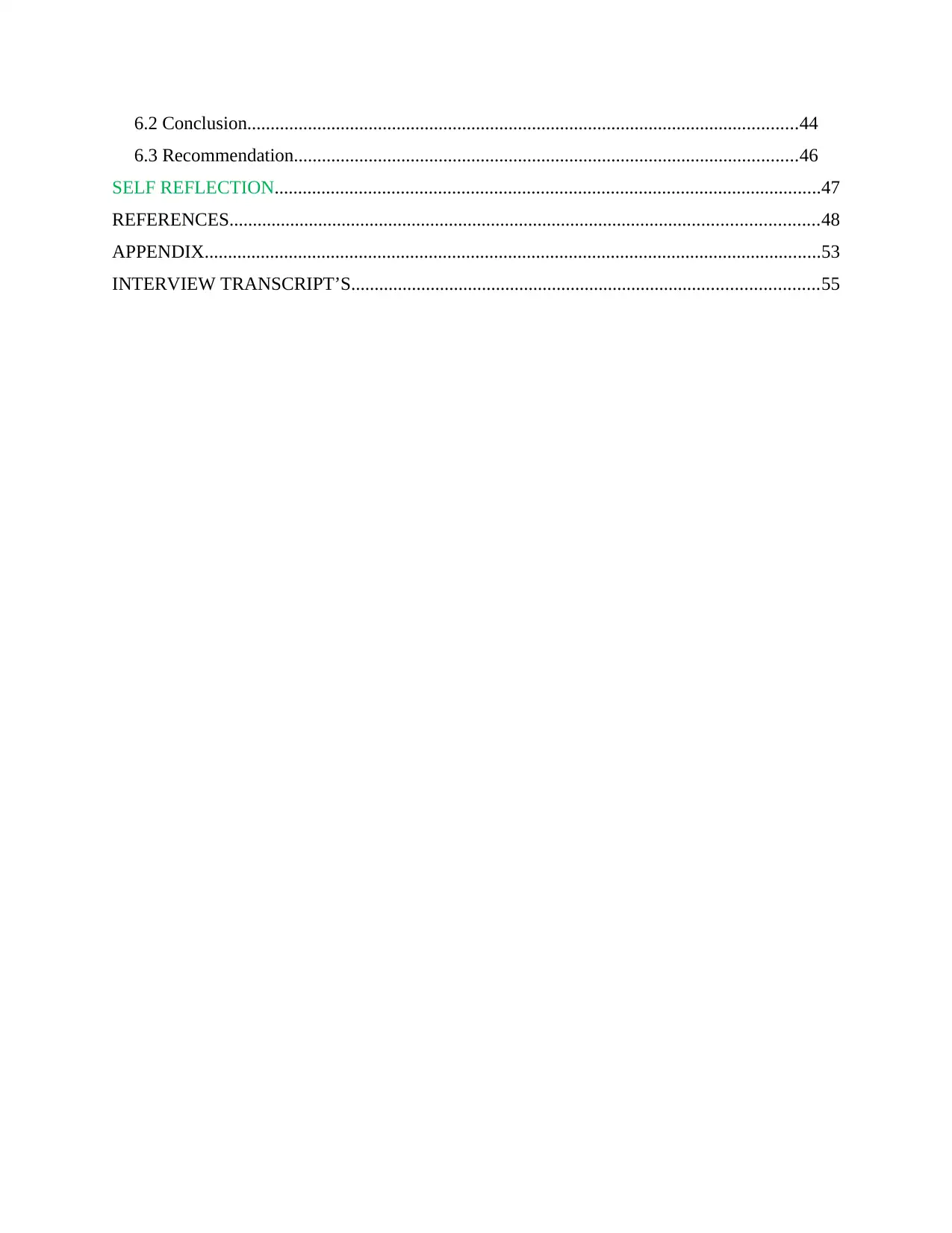
6.2 Conclusion......................................................................................................................44
6.3 Recommendation............................................................................................................46
SELF REFLECTION.....................................................................................................................47
REFERENCES..............................................................................................................................48
APPENDIX....................................................................................................................................53
INTERVIEW TRANSCRIPT’S....................................................................................................55
6.3 Recommendation............................................................................................................46
SELF REFLECTION.....................................................................................................................47
REFERENCES..............................................................................................................................48
APPENDIX....................................................................................................................................53
INTERVIEW TRANSCRIPT’S....................................................................................................55
Secure Best Marks with AI Grader
Need help grading? Try our AI Grader for instant feedback on your assignments.

CHAPTER 1: INTRODUCTION
1.1 Background
In the modern era of globalisation, a business has to be specific and clear towards their
purpose and objectives so that they can place effective set of operations and functions. Their
main aim is to be crucial in satisfying their customers and gaining appropriate forms of results. It
is highly significant that the company should be productive and profitable in the marketplace to
gain sustainability for longer time period. For this, they must have required resources which help
the organization in building ways to overcome the proposed business plan. In that context, the
aspects of business are mostly responsible to allocate and utilise the resources in a systematic
manner so that the company can gain desired set of objectives (Kieschnick, Laplante and
Moussawi, 2013). They need to ascertain in-depth information about the working capital and the
related areas that are significant for business in executing their business activities. The team has
to manage all the dealings and transactions that are based on liquidity and monetary value
system. In addition to this, they have to direct effective ways which are helpful in identifying the
best method and technique to utilise the resources.
At present stage of development, various companies are getting immense forms of
sources that support them to gain a position in their concerned sector. It is highly beneficial for
the firms in gaining effective ways that assist them to generate revenues and better organizational
goals. It has been determined that company (small or medium sized) should allocate strategic
methods for optimum utilisation of the monetary resources (Gill, Biger and Mathur, 2010). This
is vital for them to attain higher level of benefits and gain better performance. Managing working
capital is a represented as a set of activities which supports the business in developing structure
for using the resources effectively. It includes the areas like defining the level of working capital,
current assets and liabilities to be gained by the company in a particular accounting period. The
utilization of monetary funds and capital held with the business concern needs to be divided into
two section namely long-term and short-term funds. Both the stated aspects are quite different
from each other on the basis of various topics (Priester and Wang, 2010). The long-term
investments are evaluated as ‘fixed investment’ and the short-term investment are stated as
'current investment'. Long term funds are generally invested on fixed assets to gain benefits and
utilise them for longer period of time. Such investments over fixed assets are maintained in the
5
1.1 Background
In the modern era of globalisation, a business has to be specific and clear towards their
purpose and objectives so that they can place effective set of operations and functions. Their
main aim is to be crucial in satisfying their customers and gaining appropriate forms of results. It
is highly significant that the company should be productive and profitable in the marketplace to
gain sustainability for longer time period. For this, they must have required resources which help
the organization in building ways to overcome the proposed business plan. In that context, the
aspects of business are mostly responsible to allocate and utilise the resources in a systematic
manner so that the company can gain desired set of objectives (Kieschnick, Laplante and
Moussawi, 2013). They need to ascertain in-depth information about the working capital and the
related areas that are significant for business in executing their business activities. The team has
to manage all the dealings and transactions that are based on liquidity and monetary value
system. In addition to this, they have to direct effective ways which are helpful in identifying the
best method and technique to utilise the resources.
At present stage of development, various companies are getting immense forms of
sources that support them to gain a position in their concerned sector. It is highly beneficial for
the firms in gaining effective ways that assist them to generate revenues and better organizational
goals. It has been determined that company (small or medium sized) should allocate strategic
methods for optimum utilisation of the monetary resources (Gill, Biger and Mathur, 2010). This
is vital for them to attain higher level of benefits and gain better performance. Managing working
capital is a represented as a set of activities which supports the business in developing structure
for using the resources effectively. It includes the areas like defining the level of working capital,
current assets and liabilities to be gained by the company in a particular accounting period. The
utilization of monetary funds and capital held with the business concern needs to be divided into
two section namely long-term and short-term funds. Both the stated aspects are quite different
from each other on the basis of various topics (Priester and Wang, 2010). The long-term
investments are evaluated as ‘fixed investment’ and the short-term investment are stated as
'current investment'. Long term funds are generally invested on fixed assets to gain benefits and
utilise them for longer period of time. Such investments over fixed assets are maintained in the
5
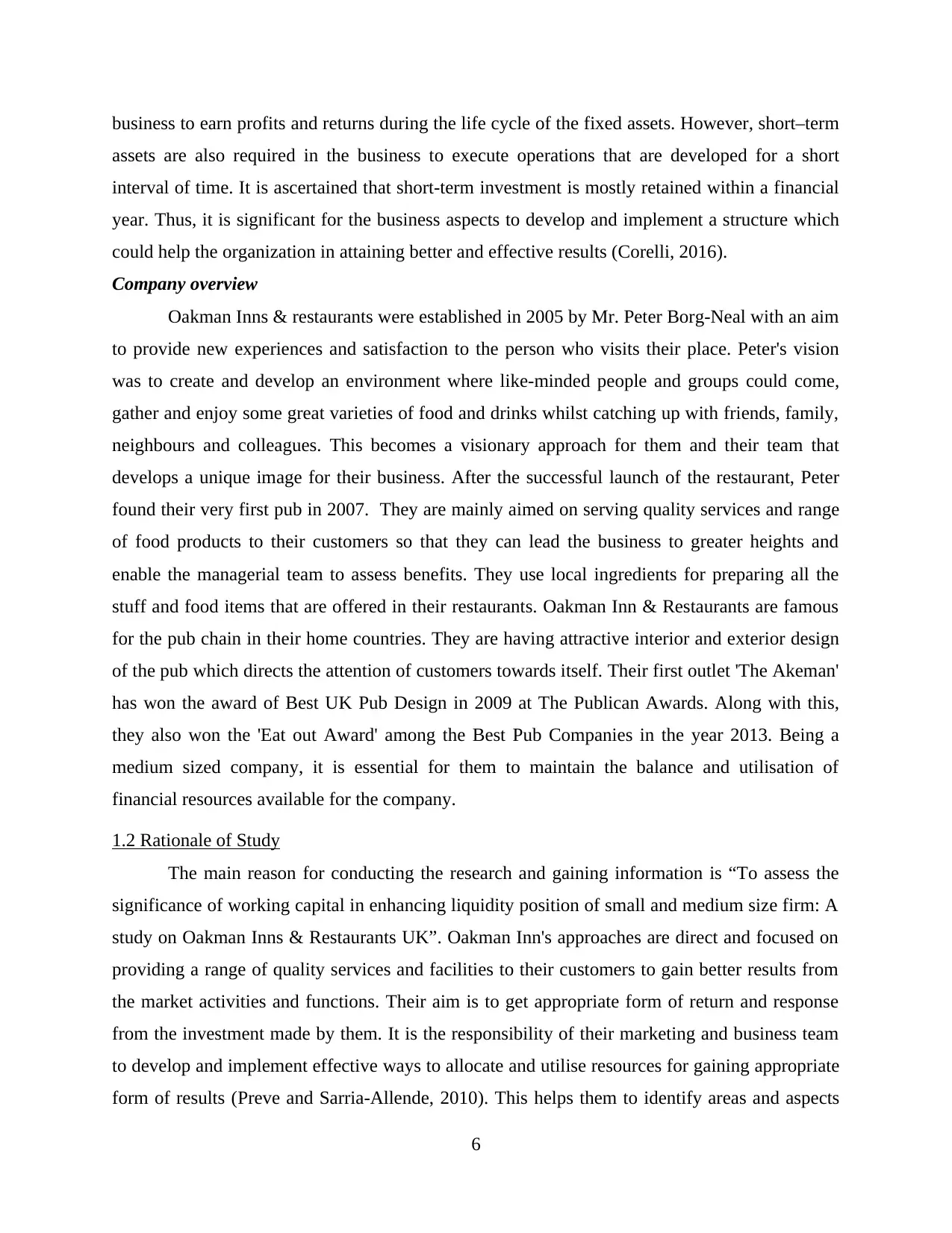
business to earn profits and returns during the life cycle of the fixed assets. However, short–term
assets are also required in the business to execute operations that are developed for a short
interval of time. It is ascertained that short-term investment is mostly retained within a financial
year. Thus, it is significant for the business aspects to develop and implement a structure which
could help the organization in attaining better and effective results (Corelli, 2016).
Company overview
Oakman Inns & restaurants were established in 2005 by Mr. Peter Borg-Neal with an aim
to provide new experiences and satisfaction to the person who visits their place. Peter's vision
was to create and develop an environment where like-minded people and groups could come,
gather and enjoy some great varieties of food and drinks whilst catching up with friends, family,
neighbours and colleagues. This becomes a visionary approach for them and their team that
develops a unique image for their business. After the successful launch of the restaurant, Peter
found their very first pub in 2007. They are mainly aimed on serving quality services and range
of food products to their customers so that they can lead the business to greater heights and
enable the managerial team to assess benefits. They use local ingredients for preparing all the
stuff and food items that are offered in their restaurants. Oakman Inn & Restaurants are famous
for the pub chain in their home countries. They are having attractive interior and exterior design
of the pub which directs the attention of customers towards itself. Their first outlet 'The Akeman'
has won the award of Best UK Pub Design in 2009 at The Publican Awards. Along with this,
they also won the 'Eat out Award' among the Best Pub Companies in the year 2013. Being a
medium sized company, it is essential for them to maintain the balance and utilisation of
financial resources available for the company.
1.2 Rationale of Study
The main reason for conducting the research and gaining information is “To assess the
significance of working capital in enhancing liquidity position of small and medium size firm: A
study on Oakman Inns & Restaurants UK”. Oakman Inn's approaches are direct and focused on
providing a range of quality services and facilities to their customers to gain better results from
the market activities and functions. Their aim is to get appropriate form of return and response
from the investment made by them. It is the responsibility of their marketing and business team
to develop and implement effective ways to allocate and utilise resources for gaining appropriate
form of results (Preve and Sarria-Allende, 2010). This helps them to identify areas and aspects
6
assets are also required in the business to execute operations that are developed for a short
interval of time. It is ascertained that short-term investment is mostly retained within a financial
year. Thus, it is significant for the business aspects to develop and implement a structure which
could help the organization in attaining better and effective results (Corelli, 2016).
Company overview
Oakman Inns & restaurants were established in 2005 by Mr. Peter Borg-Neal with an aim
to provide new experiences and satisfaction to the person who visits their place. Peter's vision
was to create and develop an environment where like-minded people and groups could come,
gather and enjoy some great varieties of food and drinks whilst catching up with friends, family,
neighbours and colleagues. This becomes a visionary approach for them and their team that
develops a unique image for their business. After the successful launch of the restaurant, Peter
found their very first pub in 2007. They are mainly aimed on serving quality services and range
of food products to their customers so that they can lead the business to greater heights and
enable the managerial team to assess benefits. They use local ingredients for preparing all the
stuff and food items that are offered in their restaurants. Oakman Inn & Restaurants are famous
for the pub chain in their home countries. They are having attractive interior and exterior design
of the pub which directs the attention of customers towards itself. Their first outlet 'The Akeman'
has won the award of Best UK Pub Design in 2009 at The Publican Awards. Along with this,
they also won the 'Eat out Award' among the Best Pub Companies in the year 2013. Being a
medium sized company, it is essential for them to maintain the balance and utilisation of
financial resources available for the company.
1.2 Rationale of Study
The main reason for conducting the research and gaining information is “To assess the
significance of working capital in enhancing liquidity position of small and medium size firm: A
study on Oakman Inns & Restaurants UK”. Oakman Inn's approaches are direct and focused on
providing a range of quality services and facilities to their customers to gain better results from
the market activities and functions. Their aim is to get appropriate form of return and response
from the investment made by them. It is the responsibility of their marketing and business team
to develop and implement effective ways to allocate and utilise resources for gaining appropriate
form of results (Preve and Sarria-Allende, 2010). This helps them to identify areas and aspects
6
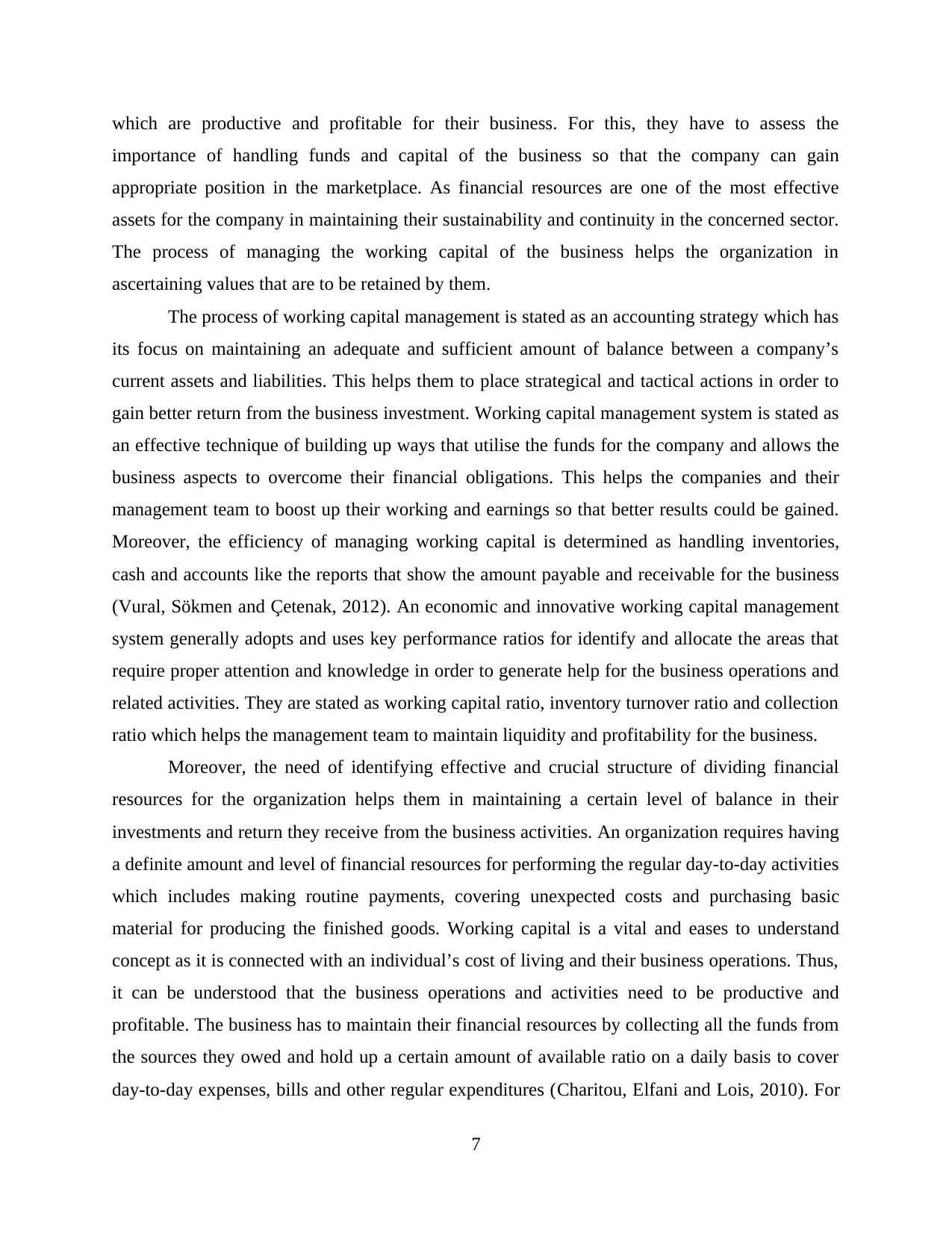
which are productive and profitable for their business. For this, they have to assess the
importance of handling funds and capital of the business so that the company can gain
appropriate position in the marketplace. As financial resources are one of the most effective
assets for the company in maintaining their sustainability and continuity in the concerned sector.
The process of managing the working capital of the business helps the organization in
ascertaining values that are to be retained by them.
The process of working capital management is stated as an accounting strategy which has
its focus on maintaining an adequate and sufficient amount of balance between a company’s
current assets and liabilities. This helps them to place strategical and tactical actions in order to
gain better return from the business investment. Working capital management system is stated as
an effective technique of building up ways that utilise the funds for the company and allows the
business aspects to overcome their financial obligations. This helps the companies and their
management team to boost up their working and earnings so that better results could be gained.
Moreover, the efficiency of managing working capital is determined as handling inventories,
cash and accounts like the reports that show the amount payable and receivable for the business
(Vural, Sökmen and Çetenak, 2012). An economic and innovative working capital management
system generally adopts and uses key performance ratios for identify and allocate the areas that
require proper attention and knowledge in order to generate help for the business operations and
related activities. They are stated as working capital ratio, inventory turnover ratio and collection
ratio which helps the management team to maintain liquidity and profitability for the business.
Moreover, the need of identifying effective and crucial structure of dividing financial
resources for the organization helps them in maintaining a certain level of balance in their
investments and return they receive from the business activities. An organization requires having
a definite amount and level of financial resources for performing the regular day-to-day activities
which includes making routine payments, covering unexpected costs and purchasing basic
material for producing the finished goods. Working capital is a vital and eases to understand
concept as it is connected with an individual’s cost of living and their business operations. Thus,
it can be understood that the business operations and activities need to be productive and
profitable. The business has to maintain their financial resources by collecting all the funds from
the sources they owed and hold up a certain amount of available ratio on a daily basis to cover
day-to-day expenses, bills and other regular expenditures (Charitou, Elfani and Lois, 2010). For
7
importance of handling funds and capital of the business so that the company can gain
appropriate position in the marketplace. As financial resources are one of the most effective
assets for the company in maintaining their sustainability and continuity in the concerned sector.
The process of managing the working capital of the business helps the organization in
ascertaining values that are to be retained by them.
The process of working capital management is stated as an accounting strategy which has
its focus on maintaining an adequate and sufficient amount of balance between a company’s
current assets and liabilities. This helps them to place strategical and tactical actions in order to
gain better return from the business investment. Working capital management system is stated as
an effective technique of building up ways that utilise the funds for the company and allows the
business aspects to overcome their financial obligations. This helps the companies and their
management team to boost up their working and earnings so that better results could be gained.
Moreover, the efficiency of managing working capital is determined as handling inventories,
cash and accounts like the reports that show the amount payable and receivable for the business
(Vural, Sökmen and Çetenak, 2012). An economic and innovative working capital management
system generally adopts and uses key performance ratios for identify and allocate the areas that
require proper attention and knowledge in order to generate help for the business operations and
related activities. They are stated as working capital ratio, inventory turnover ratio and collection
ratio which helps the management team to maintain liquidity and profitability for the business.
Moreover, the need of identifying effective and crucial structure of dividing financial
resources for the organization helps them in maintaining a certain level of balance in their
investments and return they receive from the business activities. An organization requires having
a definite amount and level of financial resources for performing the regular day-to-day activities
which includes making routine payments, covering unexpected costs and purchasing basic
material for producing the finished goods. Working capital is a vital and eases to understand
concept as it is connected with an individual’s cost of living and their business operations. Thus,
it can be understood that the business operations and activities need to be productive and
profitable. The business has to maintain their financial resources by collecting all the funds from
the sources they owed and hold up a certain amount of available ratio on a daily basis to cover
day-to-day expenses, bills and other regular expenditures (Charitou, Elfani and Lois, 2010). For
7
Paraphrase This Document
Need a fresh take? Get an instant paraphrase of this document with our AI Paraphraser

this, it is crucial for the business to adopt innovative and advance system of managing working
capital. This will help them in addressing critical factors that supports the business overcoming
the present and future issues related with the monetary values and functions. In order to reduce
the impact and influence of such procedures the company has to assess some effective ways and
measures that could generate a direction of success and achieving the targets.
1.3 Research aims and objectives
The purpose of conducting the whole research is “To assess the significance of working
capital in enhancing liquidity position of small and medium size firm: A study on Oakman Inns
& Restaurants UK”. Accordingly, the below stated points are their objectives which would help
the researcher in getting appropriate information about the relevant areas and aspects that are
crucial for summarising the research:
To understand the concept of working capital management and its impact on the business
activities.
To identify the ways through which business can enhance its liquidity position.
To assess the key challenges faced by Oakman Inns & Restaurants while managing
working capital within the business.
To recommend the effective ways for Oakman Inns & Restaurants through which their
business can enhance its liquidity position in the market.
Moreover, following are the research questions that are to be addressed by the researcher
to gain actual and real information regarding the topic:
What is the concept of working capital management and its impact on business activities?
Evaluate the ways through which business can enhance its liquidity position?
What are the key challenges faced by Oakman Inns & Restaurants while managing
working capital within business?
By addressing the questions and objectives, the researcher would be able to gain
appropriate form of result that would give immense sources of information to understand the
research topics and aims. However, it is necessary that the information attained by them needs to
be accurate and real so that it could be considered by the organizational team while
implementing action plan.
Themes
8
capital. This will help them in addressing critical factors that supports the business overcoming
the present and future issues related with the monetary values and functions. In order to reduce
the impact and influence of such procedures the company has to assess some effective ways and
measures that could generate a direction of success and achieving the targets.
1.3 Research aims and objectives
The purpose of conducting the whole research is “To assess the significance of working
capital in enhancing liquidity position of small and medium size firm: A study on Oakman Inns
& Restaurants UK”. Accordingly, the below stated points are their objectives which would help
the researcher in getting appropriate information about the relevant areas and aspects that are
crucial for summarising the research:
To understand the concept of working capital management and its impact on the business
activities.
To identify the ways through which business can enhance its liquidity position.
To assess the key challenges faced by Oakman Inns & Restaurants while managing
working capital within the business.
To recommend the effective ways for Oakman Inns & Restaurants through which their
business can enhance its liquidity position in the market.
Moreover, following are the research questions that are to be addressed by the researcher
to gain actual and real information regarding the topic:
What is the concept of working capital management and its impact on business activities?
Evaluate the ways through which business can enhance its liquidity position?
What are the key challenges faced by Oakman Inns & Restaurants while managing
working capital within business?
By addressing the questions and objectives, the researcher would be able to gain
appropriate form of result that would give immense sources of information to understand the
research topics and aims. However, it is necessary that the information attained by them needs to
be accurate and real so that it could be considered by the organizational team while
implementing action plan.
Themes
8
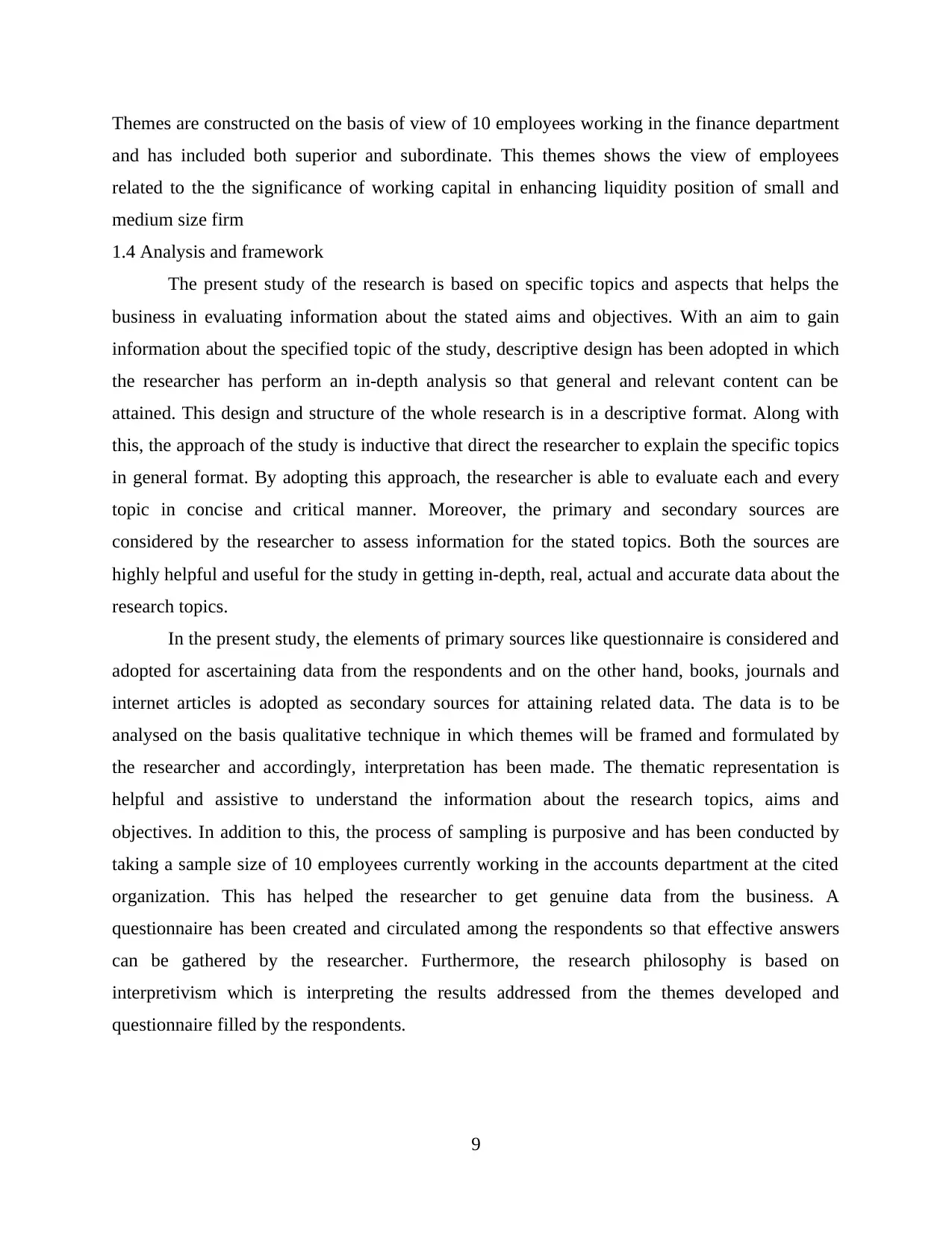
Themes are constructed on the basis of view of 10 employees working in the finance department
and has included both superior and subordinate. This themes shows the view of employees
related to the the significance of working capital in enhancing liquidity position of small and
medium size firm
1.4 Analysis and framework
The present study of the research is based on specific topics and aspects that helps the
business in evaluating information about the stated aims and objectives. With an aim to gain
information about the specified topic of the study, descriptive design has been adopted in which
the researcher has perform an in-depth analysis so that general and relevant content can be
attained. This design and structure of the whole research is in a descriptive format. Along with
this, the approach of the study is inductive that direct the researcher to explain the specific topics
in general format. By adopting this approach, the researcher is able to evaluate each and every
topic in concise and critical manner. Moreover, the primary and secondary sources are
considered by the researcher to assess information for the stated topics. Both the sources are
highly helpful and useful for the study in getting in-depth, real, actual and accurate data about the
research topics.
In the present study, the elements of primary sources like questionnaire is considered and
adopted for ascertaining data from the respondents and on the other hand, books, journals and
internet articles is adopted as secondary sources for attaining related data. The data is to be
analysed on the basis qualitative technique in which themes will be framed and formulated by
the researcher and accordingly, interpretation has been made. The thematic representation is
helpful and assistive to understand the information about the research topics, aims and
objectives. In addition to this, the process of sampling is purposive and has been conducted by
taking a sample size of 10 employees currently working in the accounts department at the cited
organization. This has helped the researcher to get genuine data from the business. A
questionnaire has been created and circulated among the respondents so that effective answers
can be gathered by the researcher. Furthermore, the research philosophy is based on
interpretivism which is interpreting the results addressed from the themes developed and
questionnaire filled by the respondents.
9
and has included both superior and subordinate. This themes shows the view of employees
related to the the significance of working capital in enhancing liquidity position of small and
medium size firm
1.4 Analysis and framework
The present study of the research is based on specific topics and aspects that helps the
business in evaluating information about the stated aims and objectives. With an aim to gain
information about the specified topic of the study, descriptive design has been adopted in which
the researcher has perform an in-depth analysis so that general and relevant content can be
attained. This design and structure of the whole research is in a descriptive format. Along with
this, the approach of the study is inductive that direct the researcher to explain the specific topics
in general format. By adopting this approach, the researcher is able to evaluate each and every
topic in concise and critical manner. Moreover, the primary and secondary sources are
considered by the researcher to assess information for the stated topics. Both the sources are
highly helpful and useful for the study in getting in-depth, real, actual and accurate data about the
research topics.
In the present study, the elements of primary sources like questionnaire is considered and
adopted for ascertaining data from the respondents and on the other hand, books, journals and
internet articles is adopted as secondary sources for attaining related data. The data is to be
analysed on the basis qualitative technique in which themes will be framed and formulated by
the researcher and accordingly, interpretation has been made. The thematic representation is
helpful and assistive to understand the information about the research topics, aims and
objectives. In addition to this, the process of sampling is purposive and has been conducted by
taking a sample size of 10 employees currently working in the accounts department at the cited
organization. This has helped the researcher to get genuine data from the business. A
questionnaire has been created and circulated among the respondents so that effective answers
can be gathered by the researcher. Furthermore, the research philosophy is based on
interpretivism which is interpreting the results addressed from the themes developed and
questionnaire filled by the respondents.
9
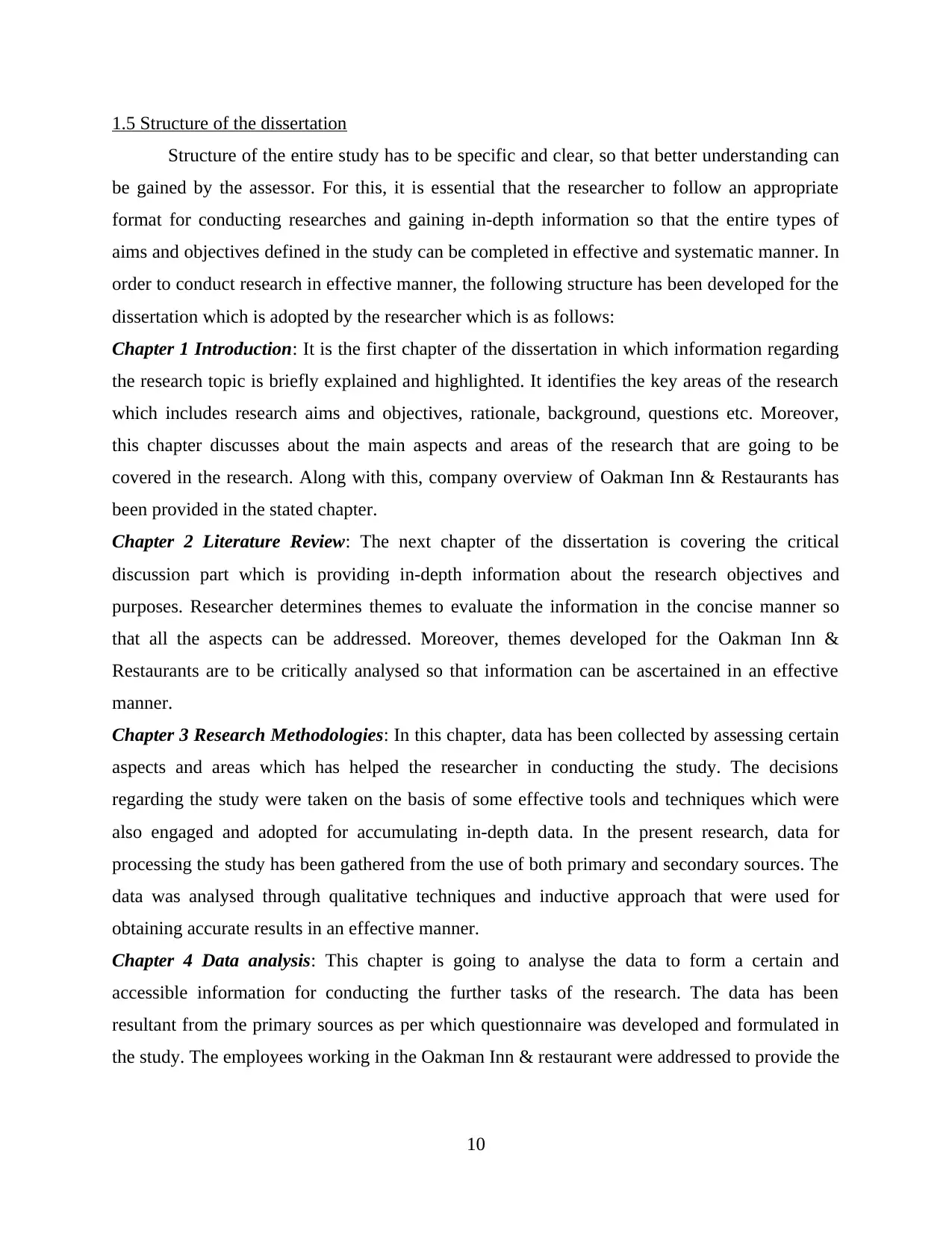
1.5 Structure of the dissertation
Structure of the entire study has to be specific and clear, so that better understanding can
be gained by the assessor. For this, it is essential that the researcher to follow an appropriate
format for conducting researches and gaining in-depth information so that the entire types of
aims and objectives defined in the study can be completed in effective and systematic manner. In
order to conduct research in effective manner, the following structure has been developed for the
dissertation which is adopted by the researcher which is as follows:
Chapter 1 Introduction: It is the first chapter of the dissertation in which information regarding
the research topic is briefly explained and highlighted. It identifies the key areas of the research
which includes research aims and objectives, rationale, background, questions etc. Moreover,
this chapter discusses about the main aspects and areas of the research that are going to be
covered in the research. Along with this, company overview of Oakman Inn & Restaurants has
been provided in the stated chapter.
Chapter 2 Literature Review: The next chapter of the dissertation is covering the critical
discussion part which is providing in-depth information about the research objectives and
purposes. Researcher determines themes to evaluate the information in the concise manner so
that all the aspects can be addressed. Moreover, themes developed for the Oakman Inn &
Restaurants are to be critically analysed so that information can be ascertained in an effective
manner.
Chapter 3 Research Methodologies: In this chapter, data has been collected by assessing certain
aspects and areas which has helped the researcher in conducting the study. The decisions
regarding the study were taken on the basis of some effective tools and techniques which were
also engaged and adopted for accumulating in-depth data. In the present research, data for
processing the study has been gathered from the use of both primary and secondary sources. The
data was analysed through qualitative techniques and inductive approach that were used for
obtaining accurate results in an effective manner.
Chapter 4 Data analysis: This chapter is going to analyse the data to form a certain and
accessible information for conducting the further tasks of the research. The data has been
resultant from the primary sources as per which questionnaire was developed and formulated in
the study. The employees working in the Oakman Inn & restaurant were addressed to provide the
10
Structure of the entire study has to be specific and clear, so that better understanding can
be gained by the assessor. For this, it is essential that the researcher to follow an appropriate
format for conducting researches and gaining in-depth information so that the entire types of
aims and objectives defined in the study can be completed in effective and systematic manner. In
order to conduct research in effective manner, the following structure has been developed for the
dissertation which is adopted by the researcher which is as follows:
Chapter 1 Introduction: It is the first chapter of the dissertation in which information regarding
the research topic is briefly explained and highlighted. It identifies the key areas of the research
which includes research aims and objectives, rationale, background, questions etc. Moreover,
this chapter discusses about the main aspects and areas of the research that are going to be
covered in the research. Along with this, company overview of Oakman Inn & Restaurants has
been provided in the stated chapter.
Chapter 2 Literature Review: The next chapter of the dissertation is covering the critical
discussion part which is providing in-depth information about the research objectives and
purposes. Researcher determines themes to evaluate the information in the concise manner so
that all the aspects can be addressed. Moreover, themes developed for the Oakman Inn &
Restaurants are to be critically analysed so that information can be ascertained in an effective
manner.
Chapter 3 Research Methodologies: In this chapter, data has been collected by assessing certain
aspects and areas which has helped the researcher in conducting the study. The decisions
regarding the study were taken on the basis of some effective tools and techniques which were
also engaged and adopted for accumulating in-depth data. In the present research, data for
processing the study has been gathered from the use of both primary and secondary sources. The
data was analysed through qualitative techniques and inductive approach that were used for
obtaining accurate results in an effective manner.
Chapter 4 Data analysis: This chapter is going to analyse the data to form a certain and
accessible information for conducting the further tasks of the research. The data has been
resultant from the primary sources as per which questionnaire was developed and formulated in
the study. The employees working in the Oakman Inn & restaurant were addressed to provide the
10
Secure Best Marks with AI Grader
Need help grading? Try our AI Grader for instant feedback on your assignments.
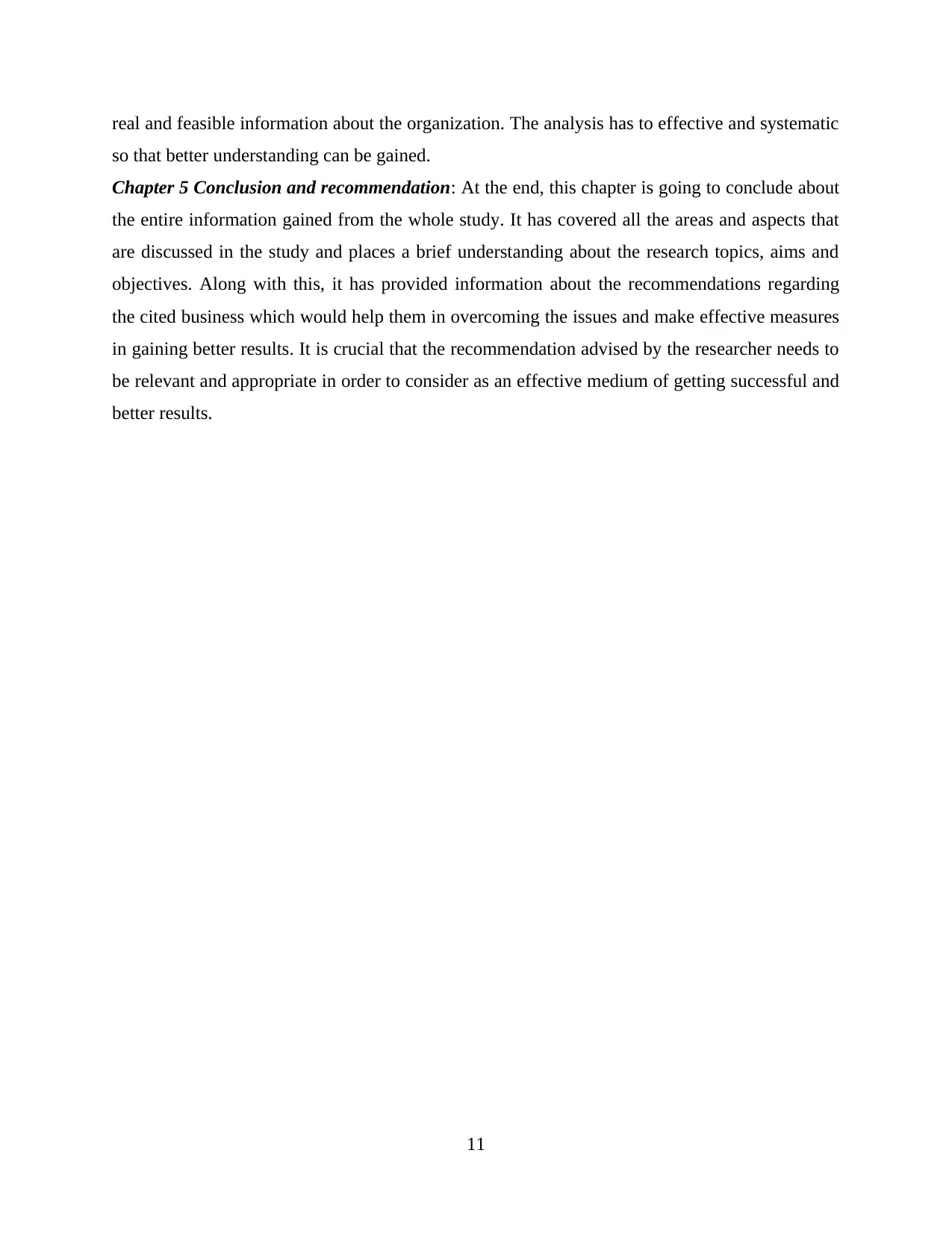
real and feasible information about the organization. The analysis has to effective and systematic
so that better understanding can be gained.
Chapter 5 Conclusion and recommendation: At the end, this chapter is going to conclude about
the entire information gained from the whole study. It has covered all the areas and aspects that
are discussed in the study and places a brief understanding about the research topics, aims and
objectives. Along with this, it has provided information about the recommendations regarding
the cited business which would help them in overcoming the issues and make effective measures
in gaining better results. It is crucial that the recommendation advised by the researcher needs to
be relevant and appropriate in order to consider as an effective medium of getting successful and
better results.
11
so that better understanding can be gained.
Chapter 5 Conclusion and recommendation: At the end, this chapter is going to conclude about
the entire information gained from the whole study. It has covered all the areas and aspects that
are discussed in the study and places a brief understanding about the research topics, aims and
objectives. Along with this, it has provided information about the recommendations regarding
the cited business which would help them in overcoming the issues and make effective measures
in gaining better results. It is crucial that the recommendation advised by the researcher needs to
be relevant and appropriate in order to consider as an effective medium of getting successful and
better results.
11
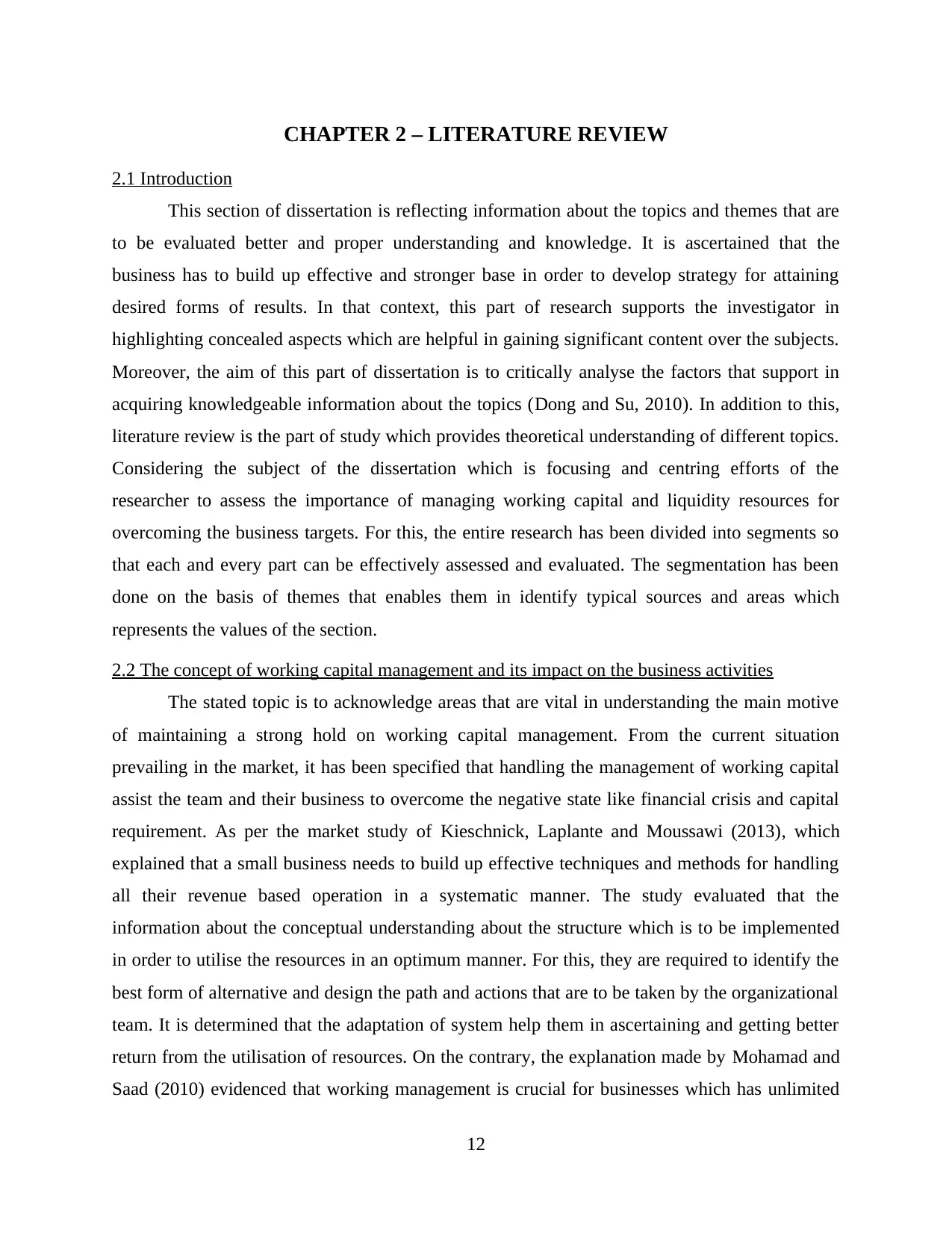
CHAPTER 2 – LITERATURE REVIEW
2.1 Introduction
This section of dissertation is reflecting information about the topics and themes that are
to be evaluated better and proper understanding and knowledge. It is ascertained that the
business has to build up effective and stronger base in order to develop strategy for attaining
desired forms of results. In that context, this part of research supports the investigator in
highlighting concealed aspects which are helpful in gaining significant content over the subjects.
Moreover, the aim of this part of dissertation is to critically analyse the factors that support in
acquiring knowledgeable information about the topics (Dong and Su, 2010). In addition to this,
literature review is the part of study which provides theoretical understanding of different topics.
Considering the subject of the dissertation which is focusing and centring efforts of the
researcher to assess the importance of managing working capital and liquidity resources for
overcoming the business targets. For this, the entire research has been divided into segments so
that each and every part can be effectively assessed and evaluated. The segmentation has been
done on the basis of themes that enables them in identify typical sources and areas which
represents the values of the section.
2.2 The concept of working capital management and its impact on the business activities
The stated topic is to acknowledge areas that are vital in understanding the main motive
of maintaining a strong hold on working capital management. From the current situation
prevailing in the market, it has been specified that handling the management of working capital
assist the team and their business to overcome the negative state like financial crisis and capital
requirement. As per the market study of Kieschnick, Laplante and Moussawi (2013), which
explained that a small business needs to build up effective techniques and methods for handling
all their revenue based operation in a systematic manner. The study evaluated that the
information about the conceptual understanding about the structure which is to be implemented
in order to utilise the resources in an optimum manner. For this, they are required to identify the
best form of alternative and design the path and actions that are to be taken by the organizational
team. It is determined that the adaptation of system help them in ascertaining and getting better
return from the utilisation of resources. On the contrary, the explanation made by Mohamad and
Saad (2010) evidenced that working management is crucial for businesses which has unlimited
12
2.1 Introduction
This section of dissertation is reflecting information about the topics and themes that are
to be evaluated better and proper understanding and knowledge. It is ascertained that the
business has to build up effective and stronger base in order to develop strategy for attaining
desired forms of results. In that context, this part of research supports the investigator in
highlighting concealed aspects which are helpful in gaining significant content over the subjects.
Moreover, the aim of this part of dissertation is to critically analyse the factors that support in
acquiring knowledgeable information about the topics (Dong and Su, 2010). In addition to this,
literature review is the part of study which provides theoretical understanding of different topics.
Considering the subject of the dissertation which is focusing and centring efforts of the
researcher to assess the importance of managing working capital and liquidity resources for
overcoming the business targets. For this, the entire research has been divided into segments so
that each and every part can be effectively assessed and evaluated. The segmentation has been
done on the basis of themes that enables them in identify typical sources and areas which
represents the values of the section.
2.2 The concept of working capital management and its impact on the business activities
The stated topic is to acknowledge areas that are vital in understanding the main motive
of maintaining a strong hold on working capital management. From the current situation
prevailing in the market, it has been specified that handling the management of working capital
assist the team and their business to overcome the negative state like financial crisis and capital
requirement. As per the market study of Kieschnick, Laplante and Moussawi (2013), which
explained that a small business needs to build up effective techniques and methods for handling
all their revenue based operation in a systematic manner. The study evaluated that the
information about the conceptual understanding about the structure which is to be implemented
in order to utilise the resources in an optimum manner. For this, they are required to identify the
best form of alternative and design the path and actions that are to be taken by the organizational
team. It is determined that the adaptation of system help them in ascertaining and getting better
return from the utilisation of resources. On the contrary, the explanation made by Mohamad and
Saad (2010) evidenced that working management is crucial for businesses which has unlimited
12
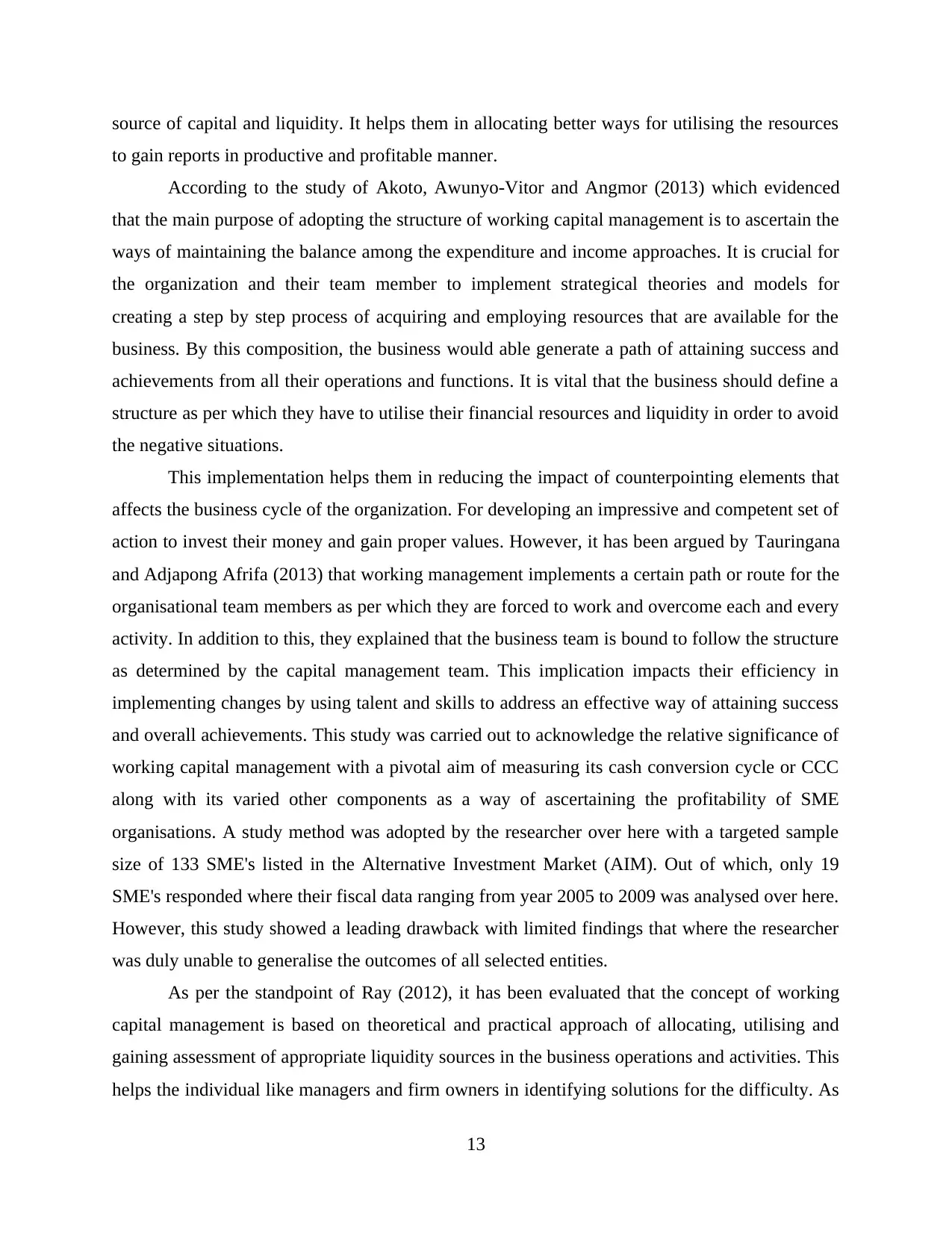
source of capital and liquidity. It helps them in allocating better ways for utilising the resources
to gain reports in productive and profitable manner.
According to the study of Akoto, Awunyo-Vitor and Angmor (2013) which evidenced
that the main purpose of adopting the structure of working capital management is to ascertain the
ways of maintaining the balance among the expenditure and income approaches. It is crucial for
the organization and their team member to implement strategical theories and models for
creating a step by step process of acquiring and employing resources that are available for the
business. By this composition, the business would able generate a path of attaining success and
achievements from all their operations and functions. It is vital that the business should define a
structure as per which they have to utilise their financial resources and liquidity in order to avoid
the negative situations.
This implementation helps them in reducing the impact of counterpointing elements that
affects the business cycle of the organization. For developing an impressive and competent set of
action to invest their money and gain proper values. However, it has been argued by Tauringana
and Adjapong Afrifa (2013) that working management implements a certain path or route for the
organisational team members as per which they are forced to work and overcome each and every
activity. In addition to this, they explained that the business team is bound to follow the structure
as determined by the capital management team. This implication impacts their efficiency in
implementing changes by using talent and skills to address an effective way of attaining success
and overall achievements. This study was carried out to acknowledge the relative significance of
working capital management with a pivotal aim of measuring its cash conversion cycle or CCC
along with its varied other components as a way of ascertaining the profitability of SME
organisations. A study method was adopted by the researcher over here with a targeted sample
size of 133 SME's listed in the Alternative Investment Market (AIM). Out of which, only 19
SME's responded where their fiscal data ranging from year 2005 to 2009 was analysed over here.
However, this study showed a leading drawback with limited findings that where the researcher
was duly unable to generalise the outcomes of all selected entities.
As per the standpoint of Ray (2012), it has been evaluated that the concept of working
capital management is based on theoretical and practical approach of allocating, utilising and
gaining assessment of appropriate liquidity sources in the business operations and activities. This
helps the individual like managers and firm owners in identifying solutions for the difficulty. As
13
to gain reports in productive and profitable manner.
According to the study of Akoto, Awunyo-Vitor and Angmor (2013) which evidenced
that the main purpose of adopting the structure of working capital management is to ascertain the
ways of maintaining the balance among the expenditure and income approaches. It is crucial for
the organization and their team member to implement strategical theories and models for
creating a step by step process of acquiring and employing resources that are available for the
business. By this composition, the business would able generate a path of attaining success and
achievements from all their operations and functions. It is vital that the business should define a
structure as per which they have to utilise their financial resources and liquidity in order to avoid
the negative situations.
This implementation helps them in reducing the impact of counterpointing elements that
affects the business cycle of the organization. For developing an impressive and competent set of
action to invest their money and gain proper values. However, it has been argued by Tauringana
and Adjapong Afrifa (2013) that working management implements a certain path or route for the
organisational team members as per which they are forced to work and overcome each and every
activity. In addition to this, they explained that the business team is bound to follow the structure
as determined by the capital management team. This implication impacts their efficiency in
implementing changes by using talent and skills to address an effective way of attaining success
and overall achievements. This study was carried out to acknowledge the relative significance of
working capital management with a pivotal aim of measuring its cash conversion cycle or CCC
along with its varied other components as a way of ascertaining the profitability of SME
organisations. A study method was adopted by the researcher over here with a targeted sample
size of 133 SME's listed in the Alternative Investment Market (AIM). Out of which, only 19
SME's responded where their fiscal data ranging from year 2005 to 2009 was analysed over here.
However, this study showed a leading drawback with limited findings that where the researcher
was duly unable to generalise the outcomes of all selected entities.
As per the standpoint of Ray (2012), it has been evaluated that the concept of working
capital management is based on theoretical and practical approach of allocating, utilising and
gaining assessment of appropriate liquidity sources in the business operations and activities. This
helps the individual like managers and firm owners in identifying solutions for the difficulty. As
13
Paraphrase This Document
Need a fresh take? Get an instant paraphrase of this document with our AI Paraphraser
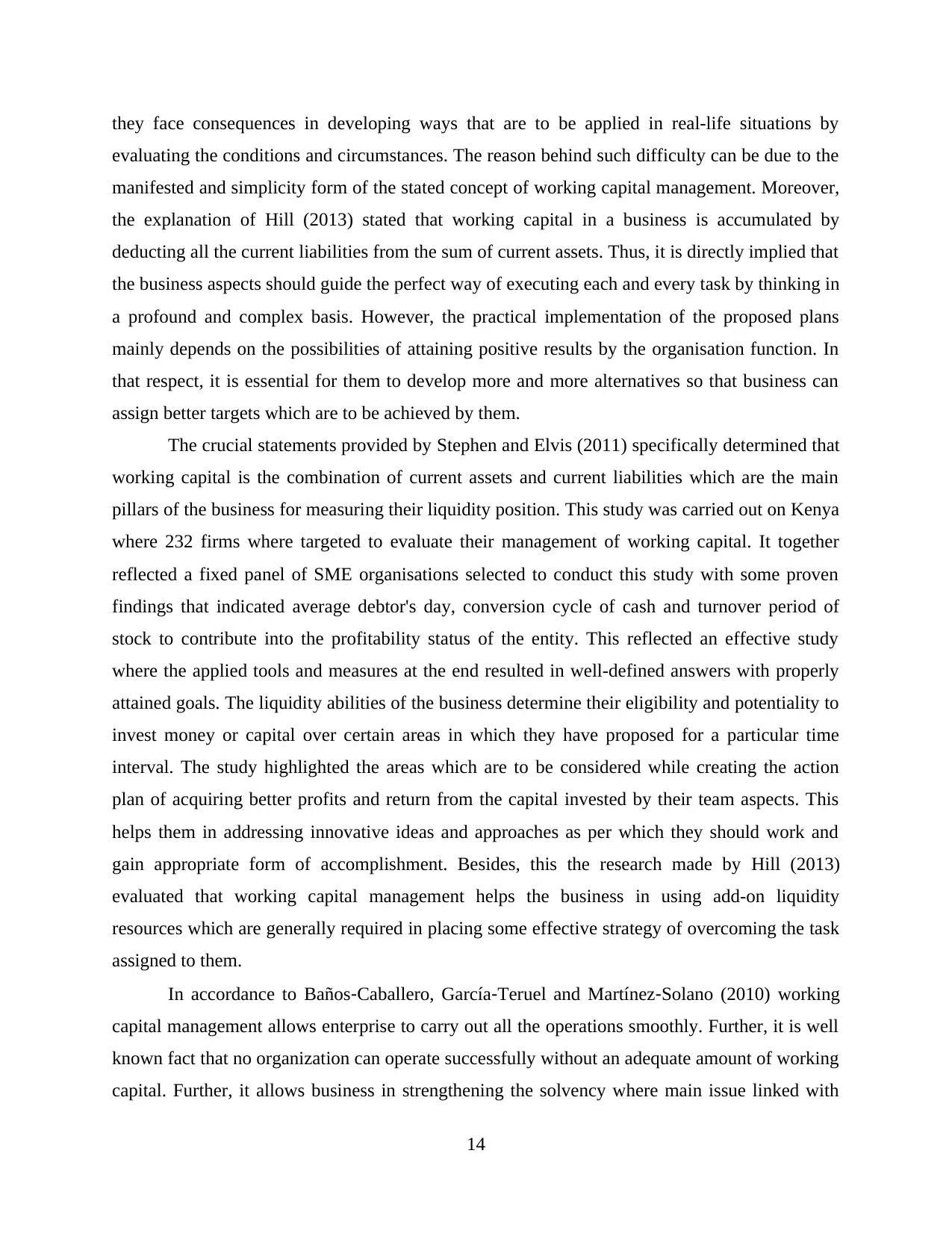
they face consequences in developing ways that are to be applied in real-life situations by
evaluating the conditions and circumstances. The reason behind such difficulty can be due to the
manifested and simplicity form of the stated concept of working capital management. Moreover,
the explanation of Hill (2013) stated that working capital in a business is accumulated by
deducting all the current liabilities from the sum of current assets. Thus, it is directly implied that
the business aspects should guide the perfect way of executing each and every task by thinking in
a profound and complex basis. However, the practical implementation of the proposed plans
mainly depends on the possibilities of attaining positive results by the organisation function. In
that respect, it is essential for them to develop more and more alternatives so that business can
assign better targets which are to be achieved by them.
The crucial statements provided by Stephen and Elvis (2011) specifically determined that
working capital is the combination of current assets and current liabilities which are the main
pillars of the business for measuring their liquidity position. This study was carried out on Kenya
where 232 firms where targeted to evaluate their management of working capital. It together
reflected a fixed panel of SME organisations selected to conduct this study with some proven
findings that indicated average debtor's day, conversion cycle of cash and turnover period of
stock to contribute into the profitability status of the entity. This reflected an effective study
where the applied tools and measures at the end resulted in well-defined answers with properly
attained goals. The liquidity abilities of the business determine their eligibility and potentiality to
invest money or capital over certain areas in which they have proposed for a particular time
interval. The study highlighted the areas which are to be considered while creating the action
plan of acquiring better profits and return from the capital invested by their team aspects. This
helps them in addressing innovative ideas and approaches as per which they should work and
gain appropriate form of accomplishment. Besides, this the research made by Hill (2013)
evaluated that working capital management helps the business in using add-on liquidity
resources which are generally required in placing some effective strategy of overcoming the task
assigned to them.
In accordance to Baños‐Caballero, García‐Teruel and Martínez‐Solano (2010) working
capital management allows enterprise to carry out all the operations smoothly. Further, it is well
known fact that no organization can operate successfully without an adequate amount of working
capital. Further, it allows business in strengthening the solvency where main issue linked with
14
evaluating the conditions and circumstances. The reason behind such difficulty can be due to the
manifested and simplicity form of the stated concept of working capital management. Moreover,
the explanation of Hill (2013) stated that working capital in a business is accumulated by
deducting all the current liabilities from the sum of current assets. Thus, it is directly implied that
the business aspects should guide the perfect way of executing each and every task by thinking in
a profound and complex basis. However, the practical implementation of the proposed plans
mainly depends on the possibilities of attaining positive results by the organisation function. In
that respect, it is essential for them to develop more and more alternatives so that business can
assign better targets which are to be achieved by them.
The crucial statements provided by Stephen and Elvis (2011) specifically determined that
working capital is the combination of current assets and current liabilities which are the main
pillars of the business for measuring their liquidity position. This study was carried out on Kenya
where 232 firms where targeted to evaluate their management of working capital. It together
reflected a fixed panel of SME organisations selected to conduct this study with some proven
findings that indicated average debtor's day, conversion cycle of cash and turnover period of
stock to contribute into the profitability status of the entity. This reflected an effective study
where the applied tools and measures at the end resulted in well-defined answers with properly
attained goals. The liquidity abilities of the business determine their eligibility and potentiality to
invest money or capital over certain areas in which they have proposed for a particular time
interval. The study highlighted the areas which are to be considered while creating the action
plan of acquiring better profits and return from the capital invested by their team aspects. This
helps them in addressing innovative ideas and approaches as per which they should work and
gain appropriate form of accomplishment. Besides, this the research made by Hill (2013)
evaluated that working capital management helps the business in using add-on liquidity
resources which are generally required in placing some effective strategy of overcoming the task
assigned to them.
In accordance to Baños‐Caballero, García‐Teruel and Martínez‐Solano (2010) working
capital management allows enterprise to carry out all the operations smoothly. Further, it is well
known fact that no organization can operate successfully without an adequate amount of working
capital. Further, it allows business in strengthening the solvency where main issue linked with
14
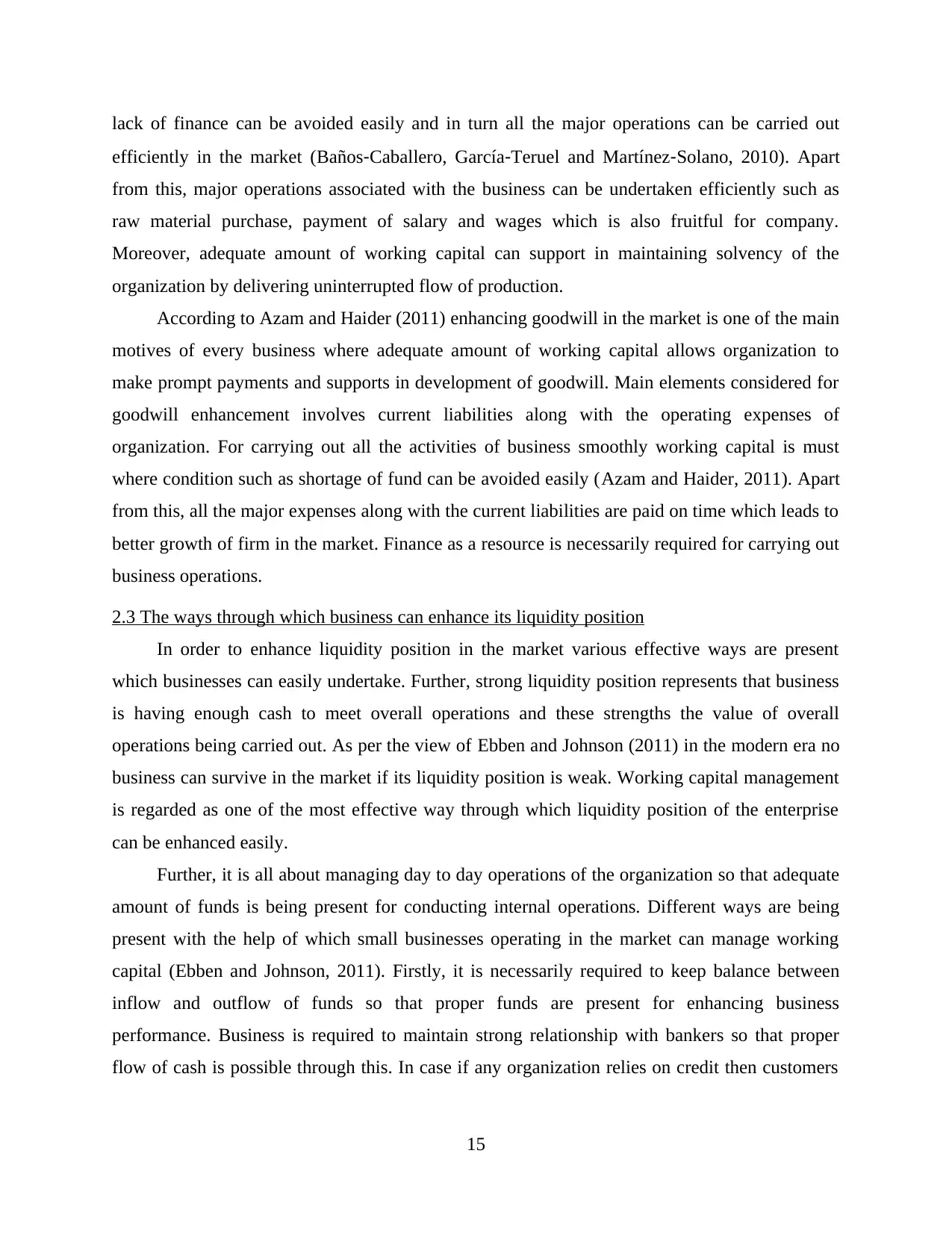
lack of finance can be avoided easily and in turn all the major operations can be carried out
efficiently in the market (Baños‐Caballero, García‐Teruel and Martínez‐Solano, 2010). Apart
from this, major operations associated with the business can be undertaken efficiently such as
raw material purchase, payment of salary and wages which is also fruitful for company.
Moreover, adequate amount of working capital can support in maintaining solvency of the
organization by delivering uninterrupted flow of production.
According to Azam and Haider (2011) enhancing goodwill in the market is one of the main
motives of every business where adequate amount of working capital allows organization to
make prompt payments and supports in development of goodwill. Main elements considered for
goodwill enhancement involves current liabilities along with the operating expenses of
organization. For carrying out all the activities of business smoothly working capital is must
where condition such as shortage of fund can be avoided easily (Azam and Haider, 2011). Apart
from this, all the major expenses along with the current liabilities are paid on time which leads to
better growth of firm in the market. Finance as a resource is necessarily required for carrying out
business operations.
2.3 The ways through which business can enhance its liquidity position
In order to enhance liquidity position in the market various effective ways are present
which businesses can easily undertake. Further, strong liquidity position represents that business
is having enough cash to meet overall operations and these strengths the value of overall
operations being carried out. As per the view of Ebben and Johnson (2011) in the modern era no
business can survive in the market if its liquidity position is weak. Working capital management
is regarded as one of the most effective way through which liquidity position of the enterprise
can be enhanced easily.
Further, it is all about managing day to day operations of the organization so that adequate
amount of funds is being present for conducting internal operations. Different ways are being
present with the help of which small businesses operating in the market can manage working
capital (Ebben and Johnson, 2011). Firstly, it is necessarily required to keep balance between
inflow and outflow of funds so that proper funds are present for enhancing business
performance. Business is required to maintain strong relationship with bankers so that proper
flow of cash is possible through this. In case if any organization relies on credit then customers
15
efficiently in the market (Baños‐Caballero, García‐Teruel and Martínez‐Solano, 2010). Apart
from this, major operations associated with the business can be undertaken efficiently such as
raw material purchase, payment of salary and wages which is also fruitful for company.
Moreover, adequate amount of working capital can support in maintaining solvency of the
organization by delivering uninterrupted flow of production.
According to Azam and Haider (2011) enhancing goodwill in the market is one of the main
motives of every business where adequate amount of working capital allows organization to
make prompt payments and supports in development of goodwill. Main elements considered for
goodwill enhancement involves current liabilities along with the operating expenses of
organization. For carrying out all the activities of business smoothly working capital is must
where condition such as shortage of fund can be avoided easily (Azam and Haider, 2011). Apart
from this, all the major expenses along with the current liabilities are paid on time which leads to
better growth of firm in the market. Finance as a resource is necessarily required for carrying out
business operations.
2.3 The ways through which business can enhance its liquidity position
In order to enhance liquidity position in the market various effective ways are present
which businesses can easily undertake. Further, strong liquidity position represents that business
is having enough cash to meet overall operations and these strengths the value of overall
operations being carried out. As per the view of Ebben and Johnson (2011) in the modern era no
business can survive in the market if its liquidity position is weak. Working capital management
is regarded as one of the most effective way through which liquidity position of the enterprise
can be enhanced easily.
Further, it is all about managing day to day operations of the organization so that adequate
amount of funds is being present for conducting internal operations. Different ways are being
present with the help of which small businesses operating in the market can manage working
capital (Ebben and Johnson, 2011). Firstly, it is necessarily required to keep balance between
inflow and outflow of funds so that proper funds are present for enhancing business
performance. Business is required to maintain strong relationship with bankers so that proper
flow of cash is possible through this. In case if any organization relies on credit then customers
15
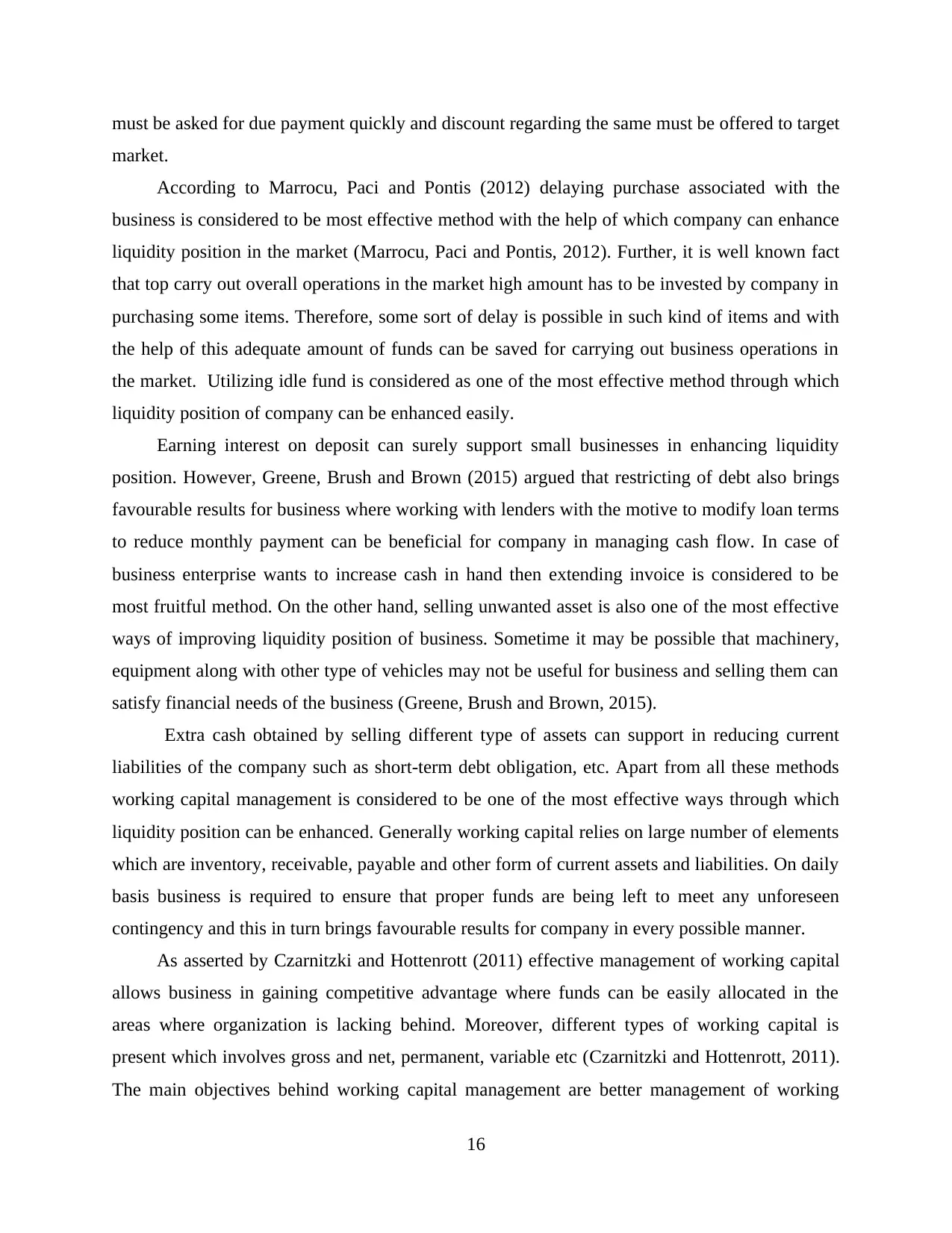
must be asked for due payment quickly and discount regarding the same must be offered to target
market.
According to Marrocu, Paci and Pontis (2012) delaying purchase associated with the
business is considered to be most effective method with the help of which company can enhance
liquidity position in the market (Marrocu, Paci and Pontis, 2012). Further, it is well known fact
that top carry out overall operations in the market high amount has to be invested by company in
purchasing some items. Therefore, some sort of delay is possible in such kind of items and with
the help of this adequate amount of funds can be saved for carrying out business operations in
the market. Utilizing idle fund is considered as one of the most effective method through which
liquidity position of company can be enhanced easily.
Earning interest on deposit can surely support small businesses in enhancing liquidity
position. However, Greene, Brush and Brown (2015) argued that restricting of debt also brings
favourable results for business where working with lenders with the motive to modify loan terms
to reduce monthly payment can be beneficial for company in managing cash flow. In case of
business enterprise wants to increase cash in hand then extending invoice is considered to be
most fruitful method. On the other hand, selling unwanted asset is also one of the most effective
ways of improving liquidity position of business. Sometime it may be possible that machinery,
equipment along with other type of vehicles may not be useful for business and selling them can
satisfy financial needs of the business (Greene, Brush and Brown, 2015).
Extra cash obtained by selling different type of assets can support in reducing current
liabilities of the company such as short-term debt obligation, etc. Apart from all these methods
working capital management is considered to be one of the most effective ways through which
liquidity position can be enhanced. Generally working capital relies on large number of elements
which are inventory, receivable, payable and other form of current assets and liabilities. On daily
basis business is required to ensure that proper funds are being left to meet any unforeseen
contingency and this in turn brings favourable results for company in every possible manner.
As asserted by Czarnitzki and Hottenrott (2011) effective management of working capital
allows business in gaining competitive advantage where funds can be easily allocated in the
areas where organization is lacking behind. Moreover, different types of working capital is
present which involves gross and net, permanent, variable etc (Czarnitzki and Hottenrott, 2011).
The main objectives behind working capital management are better management of working
16
market.
According to Marrocu, Paci and Pontis (2012) delaying purchase associated with the
business is considered to be most effective method with the help of which company can enhance
liquidity position in the market (Marrocu, Paci and Pontis, 2012). Further, it is well known fact
that top carry out overall operations in the market high amount has to be invested by company in
purchasing some items. Therefore, some sort of delay is possible in such kind of items and with
the help of this adequate amount of funds can be saved for carrying out business operations in
the market. Utilizing idle fund is considered as one of the most effective method through which
liquidity position of company can be enhanced easily.
Earning interest on deposit can surely support small businesses in enhancing liquidity
position. However, Greene, Brush and Brown (2015) argued that restricting of debt also brings
favourable results for business where working with lenders with the motive to modify loan terms
to reduce monthly payment can be beneficial for company in managing cash flow. In case of
business enterprise wants to increase cash in hand then extending invoice is considered to be
most fruitful method. On the other hand, selling unwanted asset is also one of the most effective
ways of improving liquidity position of business. Sometime it may be possible that machinery,
equipment along with other type of vehicles may not be useful for business and selling them can
satisfy financial needs of the business (Greene, Brush and Brown, 2015).
Extra cash obtained by selling different type of assets can support in reducing current
liabilities of the company such as short-term debt obligation, etc. Apart from all these methods
working capital management is considered to be one of the most effective ways through which
liquidity position can be enhanced. Generally working capital relies on large number of elements
which are inventory, receivable, payable and other form of current assets and liabilities. On daily
basis business is required to ensure that proper funds are being left to meet any unforeseen
contingency and this in turn brings favourable results for company in every possible manner.
As asserted by Czarnitzki and Hottenrott (2011) effective management of working capital
allows business in gaining competitive advantage where funds can be easily allocated in the
areas where organization is lacking behind. Moreover, different types of working capital is
present which involves gross and net, permanent, variable etc (Czarnitzki and Hottenrott, 2011).
The main objectives behind working capital management are better management of working
16
Secure Best Marks with AI Grader
Need help grading? Try our AI Grader for instant feedback on your assignments.
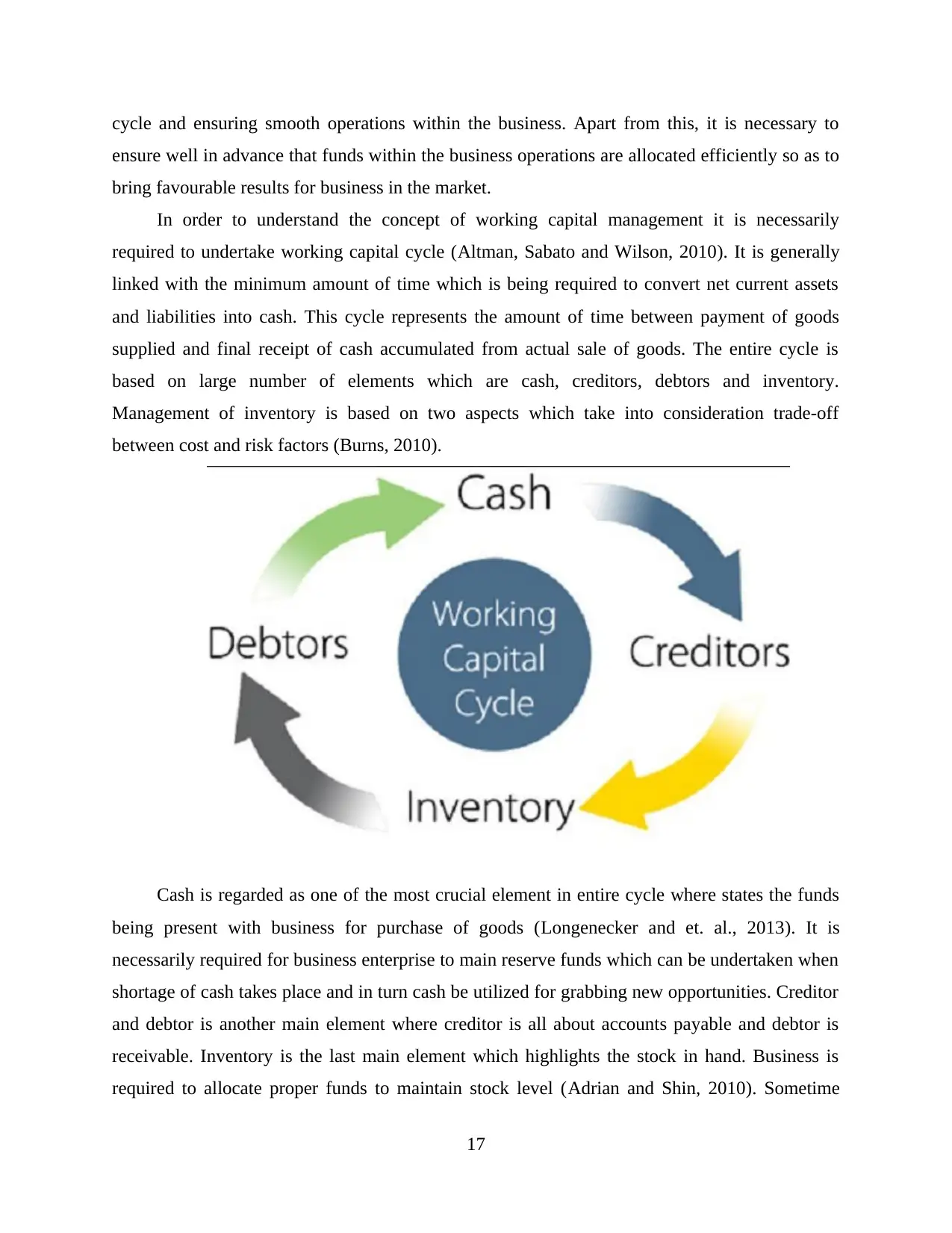
cycle and ensuring smooth operations within the business. Apart from this, it is necessary to
ensure well in advance that funds within the business operations are allocated efficiently so as to
bring favourable results for business in the market.
In order to understand the concept of working capital management it is necessarily
required to undertake working capital cycle (Altman, Sabato and Wilson, 2010). It is generally
linked with the minimum amount of time which is being required to convert net current assets
and liabilities into cash. This cycle represents the amount of time between payment of goods
supplied and final receipt of cash accumulated from actual sale of goods. The entire cycle is
based on large number of elements which are cash, creditors, debtors and inventory.
Management of inventory is based on two aspects which take into consideration trade-off
between cost and risk factors (Burns, 2010).
Cash is regarded as one of the most crucial element in entire cycle where states the funds
being present with business for purchase of goods (Longenecker and et. al., 2013). It is
necessarily required for business enterprise to main reserve funds which can be undertaken when
shortage of cash takes place and in turn cash be utilized for grabbing new opportunities. Creditor
and debtor is another main element where creditor is all about accounts payable and debtor is
receivable. Inventory is the last main element which highlights the stock in hand. Business is
required to allocate proper funds to maintain stock level (Adrian and Shin, 2010). Sometime
17
ensure well in advance that funds within the business operations are allocated efficiently so as to
bring favourable results for business in the market.
In order to understand the concept of working capital management it is necessarily
required to undertake working capital cycle (Altman, Sabato and Wilson, 2010). It is generally
linked with the minimum amount of time which is being required to convert net current assets
and liabilities into cash. This cycle represents the amount of time between payment of goods
supplied and final receipt of cash accumulated from actual sale of goods. The entire cycle is
based on large number of elements which are cash, creditors, debtors and inventory.
Management of inventory is based on two aspects which take into consideration trade-off
between cost and risk factors (Burns, 2010).
Cash is regarded as one of the most crucial element in entire cycle where states the funds
being present with business for purchase of goods (Longenecker and et. al., 2013). It is
necessarily required for business enterprise to main reserve funds which can be undertaken when
shortage of cash takes place and in turn cash be utilized for grabbing new opportunities. Creditor
and debtor is another main element where creditor is all about accounts payable and debtor is
receivable. Inventory is the last main element which highlights the stock in hand. Business is
required to allocate proper funds to maintain stock level (Adrian and Shin, 2010). Sometime
17
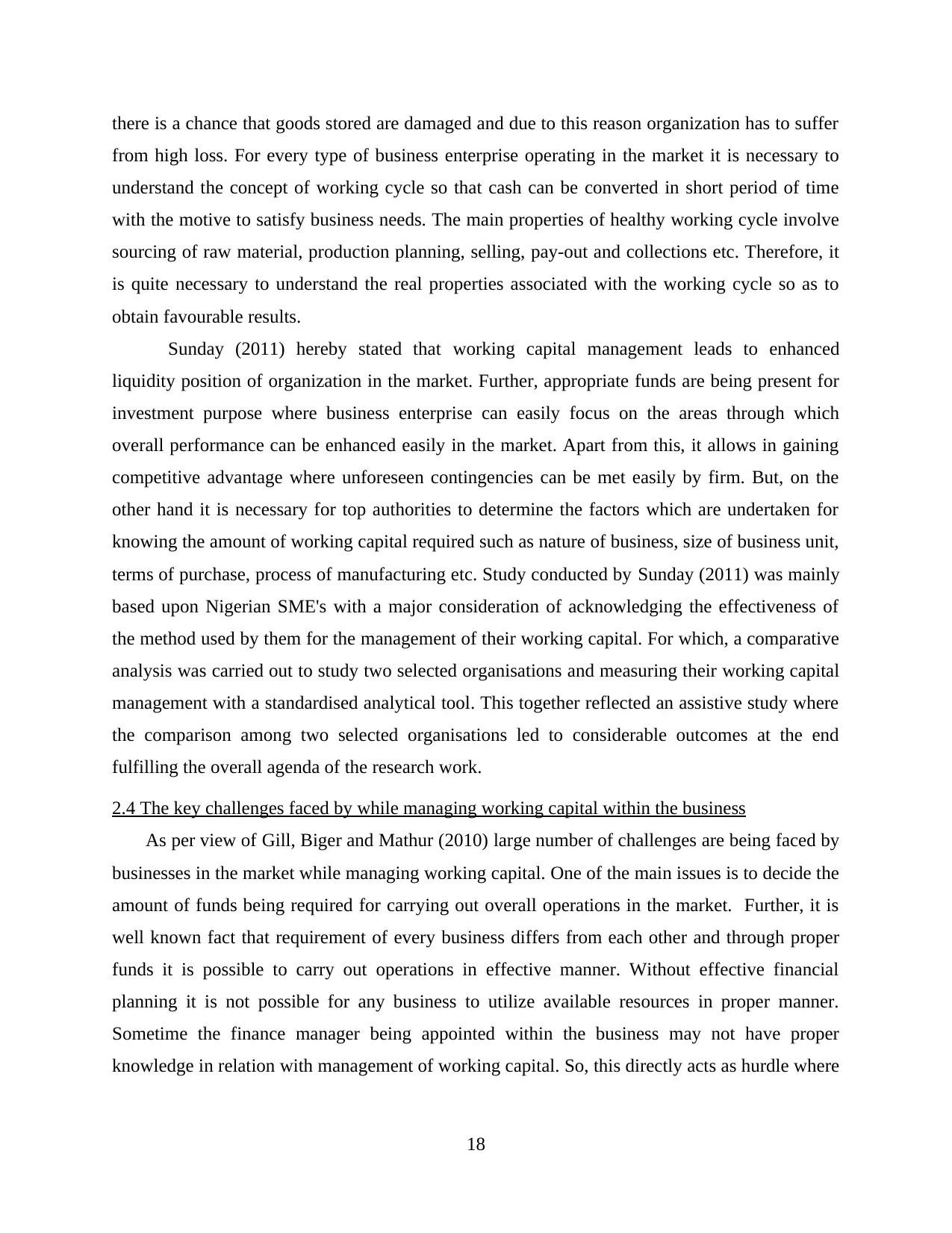
there is a chance that goods stored are damaged and due to this reason organization has to suffer
from high loss. For every type of business enterprise operating in the market it is necessary to
understand the concept of working cycle so that cash can be converted in short period of time
with the motive to satisfy business needs. The main properties of healthy working cycle involve
sourcing of raw material, production planning, selling, pay-out and collections etc. Therefore, it
is quite necessary to understand the real properties associated with the working cycle so as to
obtain favourable results.
Sunday (2011) hereby stated that working capital management leads to enhanced
liquidity position of organization in the market. Further, appropriate funds are being present for
investment purpose where business enterprise can easily focus on the areas through which
overall performance can be enhanced easily in the market. Apart from this, it allows in gaining
competitive advantage where unforeseen contingencies can be met easily by firm. But, on the
other hand it is necessary for top authorities to determine the factors which are undertaken for
knowing the amount of working capital required such as nature of business, size of business unit,
terms of purchase, process of manufacturing etc. Study conducted by Sunday (2011) was mainly
based upon Nigerian SME's with a major consideration of acknowledging the effectiveness of
the method used by them for the management of their working capital. For which, a comparative
analysis was carried out to study two selected organisations and measuring their working capital
management with a standardised analytical tool. This together reflected an assistive study where
the comparison among two selected organisations led to considerable outcomes at the end
fulfilling the overall agenda of the research work.
2.4 The key challenges faced by while managing working capital within the business
As per view of Gill, Biger and Mathur (2010) large number of challenges are being faced by
businesses in the market while managing working capital. One of the main issues is to decide the
amount of funds being required for carrying out overall operations in the market. Further, it is
well known fact that requirement of every business differs from each other and through proper
funds it is possible to carry out operations in effective manner. Without effective financial
planning it is not possible for any business to utilize available resources in proper manner.
Sometime the finance manager being appointed within the business may not have proper
knowledge in relation with management of working capital. So, this directly acts as hurdle where
18
from high loss. For every type of business enterprise operating in the market it is necessary to
understand the concept of working cycle so that cash can be converted in short period of time
with the motive to satisfy business needs. The main properties of healthy working cycle involve
sourcing of raw material, production planning, selling, pay-out and collections etc. Therefore, it
is quite necessary to understand the real properties associated with the working cycle so as to
obtain favourable results.
Sunday (2011) hereby stated that working capital management leads to enhanced
liquidity position of organization in the market. Further, appropriate funds are being present for
investment purpose where business enterprise can easily focus on the areas through which
overall performance can be enhanced easily in the market. Apart from this, it allows in gaining
competitive advantage where unforeseen contingencies can be met easily by firm. But, on the
other hand it is necessary for top authorities to determine the factors which are undertaken for
knowing the amount of working capital required such as nature of business, size of business unit,
terms of purchase, process of manufacturing etc. Study conducted by Sunday (2011) was mainly
based upon Nigerian SME's with a major consideration of acknowledging the effectiveness of
the method used by them for the management of their working capital. For which, a comparative
analysis was carried out to study two selected organisations and measuring their working capital
management with a standardised analytical tool. This together reflected an assistive study where
the comparison among two selected organisations led to considerable outcomes at the end
fulfilling the overall agenda of the research work.
2.4 The key challenges faced by while managing working capital within the business
As per view of Gill, Biger and Mathur (2010) large number of challenges are being faced by
businesses in the market while managing working capital. One of the main issues is to decide the
amount of funds being required for carrying out overall operations in the market. Further, it is
well known fact that requirement of every business differs from each other and through proper
funds it is possible to carry out operations in effective manner. Without effective financial
planning it is not possible for any business to utilize available resources in proper manner.
Sometime the finance manager being appointed within the business may not have proper
knowledge in relation with management of working capital. So, this directly acts as hurdle where
18
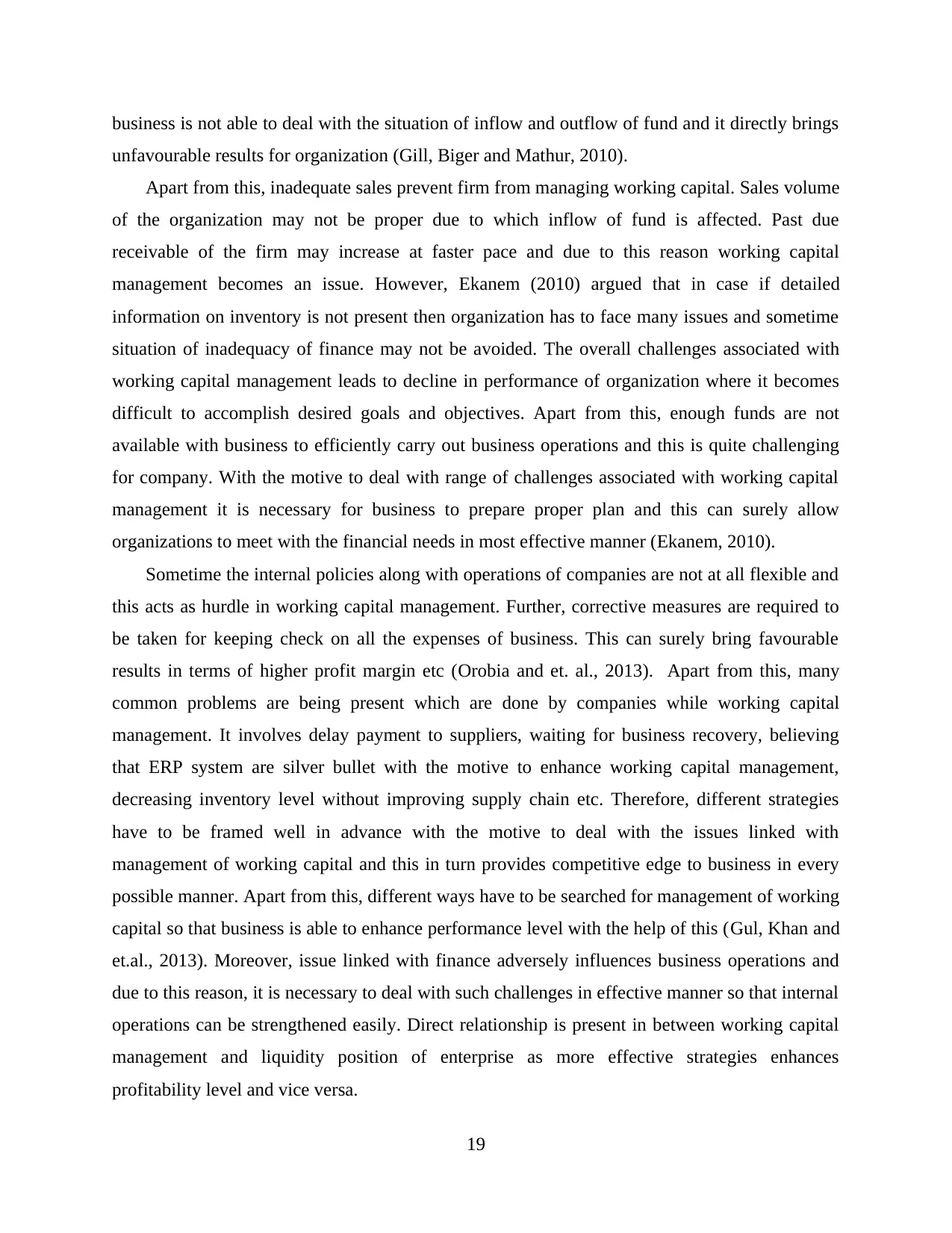
business is not able to deal with the situation of inflow and outflow of fund and it directly brings
unfavourable results for organization (Gill, Biger and Mathur, 2010).
Apart from this, inadequate sales prevent firm from managing working capital. Sales volume
of the organization may not be proper due to which inflow of fund is affected. Past due
receivable of the firm may increase at faster pace and due to this reason working capital
management becomes an issue. However, Ekanem (2010) argued that in case if detailed
information on inventory is not present then organization has to face many issues and sometime
situation of inadequacy of finance may not be avoided. The overall challenges associated with
working capital management leads to decline in performance of organization where it becomes
difficult to accomplish desired goals and objectives. Apart from this, enough funds are not
available with business to efficiently carry out business operations and this is quite challenging
for company. With the motive to deal with range of challenges associated with working capital
management it is necessary for business to prepare proper plan and this can surely allow
organizations to meet with the financial needs in most effective manner (Ekanem, 2010).
Sometime the internal policies along with operations of companies are not at all flexible and
this acts as hurdle in working capital management. Further, corrective measures are required to
be taken for keeping check on all the expenses of business. This can surely bring favourable
results in terms of higher profit margin etc (Orobia and et. al., 2013). Apart from this, many
common problems are being present which are done by companies while working capital
management. It involves delay payment to suppliers, waiting for business recovery, believing
that ERP system are silver bullet with the motive to enhance working capital management,
decreasing inventory level without improving supply chain etc. Therefore, different strategies
have to be framed well in advance with the motive to deal with the issues linked with
management of working capital and this in turn provides competitive edge to business in every
possible manner. Apart from this, different ways have to be searched for management of working
capital so that business is able to enhance performance level with the help of this (Gul, Khan and
et.al., 2013). Moreover, issue linked with finance adversely influences business operations and
due to this reason, it is necessary to deal with such challenges in effective manner so that internal
operations can be strengthened easily. Direct relationship is present in between working capital
management and liquidity position of enterprise as more effective strategies enhances
profitability level and vice versa.
19
unfavourable results for organization (Gill, Biger and Mathur, 2010).
Apart from this, inadequate sales prevent firm from managing working capital. Sales volume
of the organization may not be proper due to which inflow of fund is affected. Past due
receivable of the firm may increase at faster pace and due to this reason working capital
management becomes an issue. However, Ekanem (2010) argued that in case if detailed
information on inventory is not present then organization has to face many issues and sometime
situation of inadequacy of finance may not be avoided. The overall challenges associated with
working capital management leads to decline in performance of organization where it becomes
difficult to accomplish desired goals and objectives. Apart from this, enough funds are not
available with business to efficiently carry out business operations and this is quite challenging
for company. With the motive to deal with range of challenges associated with working capital
management it is necessary for business to prepare proper plan and this can surely allow
organizations to meet with the financial needs in most effective manner (Ekanem, 2010).
Sometime the internal policies along with operations of companies are not at all flexible and
this acts as hurdle in working capital management. Further, corrective measures are required to
be taken for keeping check on all the expenses of business. This can surely bring favourable
results in terms of higher profit margin etc (Orobia and et. al., 2013). Apart from this, many
common problems are being present which are done by companies while working capital
management. It involves delay payment to suppliers, waiting for business recovery, believing
that ERP system are silver bullet with the motive to enhance working capital management,
decreasing inventory level without improving supply chain etc. Therefore, different strategies
have to be framed well in advance with the motive to deal with the issues linked with
management of working capital and this in turn provides competitive edge to business in every
possible manner. Apart from this, different ways have to be searched for management of working
capital so that business is able to enhance performance level with the help of this (Gul, Khan and
et.al., 2013). Moreover, issue linked with finance adversely influences business operations and
due to this reason, it is necessary to deal with such challenges in effective manner so that internal
operations can be strengthened easily. Direct relationship is present in between working capital
management and liquidity position of enterprise as more effective strategies enhances
profitability level and vice versa.
19
Paraphrase This Document
Need a fresh take? Get an instant paraphrase of this document with our AI Paraphraser
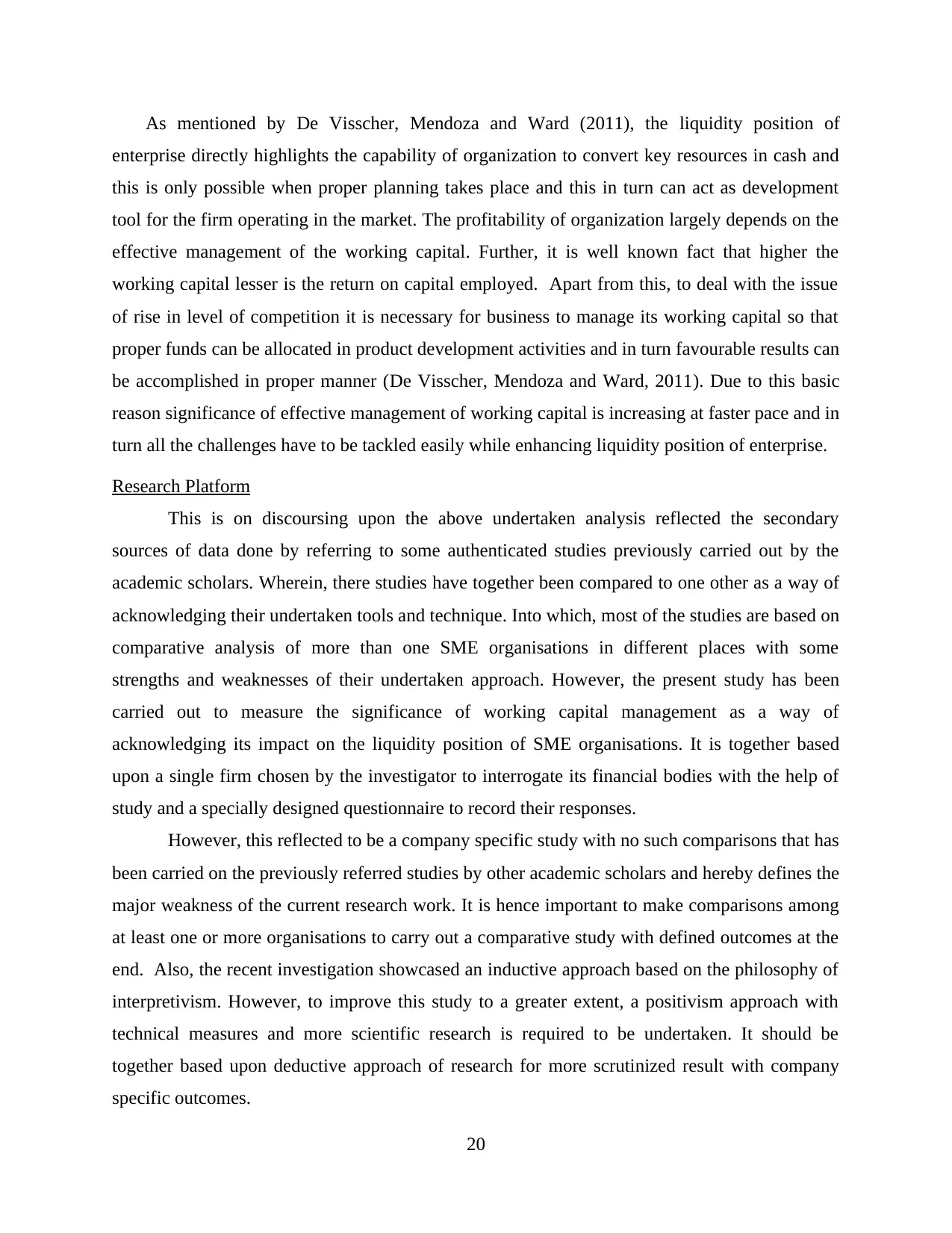
As mentioned by De Visscher, Mendoza and Ward (2011), the liquidity position of
enterprise directly highlights the capability of organization to convert key resources in cash and
this is only possible when proper planning takes place and this in turn can act as development
tool for the firm operating in the market. The profitability of organization largely depends on the
effective management of the working capital. Further, it is well known fact that higher the
working capital lesser is the return on capital employed. Apart from this, to deal with the issue
of rise in level of competition it is necessary for business to manage its working capital so that
proper funds can be allocated in product development activities and in turn favourable results can
be accomplished in proper manner (De Visscher, Mendoza and Ward, 2011). Due to this basic
reason significance of effective management of working capital is increasing at faster pace and in
turn all the challenges have to be tackled easily while enhancing liquidity position of enterprise.
Research Platform
This is on discoursing upon the above undertaken analysis reflected the secondary
sources of data done by referring to some authenticated studies previously carried out by the
academic scholars. Wherein, there studies have together been compared to one other as a way of
acknowledging their undertaken tools and technique. Into which, most of the studies are based on
comparative analysis of more than one SME organisations in different places with some
strengths and weaknesses of their undertaken approach. However, the present study has been
carried out to measure the significance of working capital management as a way of
acknowledging its impact on the liquidity position of SME organisations. It is together based
upon a single firm chosen by the investigator to interrogate its financial bodies with the help of
study and a specially designed questionnaire to record their responses.
However, this reflected to be a company specific study with no such comparisons that has
been carried on the previously referred studies by other academic scholars and hereby defines the
major weakness of the current research work. It is hence important to make comparisons among
at least one or more organisations to carry out a comparative study with defined outcomes at the
end. Also, the recent investigation showcased an inductive approach based on the philosophy of
interpretivism. However, to improve this study to a greater extent, a positivism approach with
technical measures and more scientific research is required to be undertaken. It should be
together based upon deductive approach of research for more scrutinized result with company
specific outcomes.
20
enterprise directly highlights the capability of organization to convert key resources in cash and
this is only possible when proper planning takes place and this in turn can act as development
tool for the firm operating in the market. The profitability of organization largely depends on the
effective management of the working capital. Further, it is well known fact that higher the
working capital lesser is the return on capital employed. Apart from this, to deal with the issue
of rise in level of competition it is necessary for business to manage its working capital so that
proper funds can be allocated in product development activities and in turn favourable results can
be accomplished in proper manner (De Visscher, Mendoza and Ward, 2011). Due to this basic
reason significance of effective management of working capital is increasing at faster pace and in
turn all the challenges have to be tackled easily while enhancing liquidity position of enterprise.
Research Platform
This is on discoursing upon the above undertaken analysis reflected the secondary
sources of data done by referring to some authenticated studies previously carried out by the
academic scholars. Wherein, there studies have together been compared to one other as a way of
acknowledging their undertaken tools and technique. Into which, most of the studies are based on
comparative analysis of more than one SME organisations in different places with some
strengths and weaknesses of their undertaken approach. However, the present study has been
carried out to measure the significance of working capital management as a way of
acknowledging its impact on the liquidity position of SME organisations. It is together based
upon a single firm chosen by the investigator to interrogate its financial bodies with the help of
study and a specially designed questionnaire to record their responses.
However, this reflected to be a company specific study with no such comparisons that has
been carried on the previously referred studies by other academic scholars and hereby defines the
major weakness of the current research work. It is hence important to make comparisons among
at least one or more organisations to carry out a comparative study with defined outcomes at the
end. Also, the recent investigation showcased an inductive approach based on the philosophy of
interpretivism. However, to improve this study to a greater extent, a positivism approach with
technical measures and more scientific research is required to be undertaken. It should be
together based upon deductive approach of research for more scrutinized result with company
specific outcomes.
20

CHAPTER- 3
RESEARCH METHODOLOGY
3.1 Introduction
It is the third most important chapter of this thesis that has provided a generous idea
about the utilization of relevant tools and techniques that has been employed to conduct the
research in an effective manner. It is impossible to accomplish the framed aims and objectives of
the study without outlining this chapter into it (Badke, 2012). It is however due to a basic reason
of this unit where it reflected to be a crucial part in the entire research work. It is further
segregated in 10 more sections to step wise define the applied tactics to carry out the
investigation. As per the entitlement of this unit, one can directly ascertain its pivotal nature in
which, this will lead to implicate the adopted measures of the investigator to conduct the study.
This chapter therefore cover certain key areas like data collection, analysis, approach,
philosophy, limitations, ethical issues, reliability and validity, etc. Furthermore, it is in order to
accomplish the configured goal of this dissertation. It is with a leading cogitation of assessing
some significant measures for the enhancement of working capital that will in turn result in
increasing the liquidity state of small and medium size entities (Bryman and Bell, 2015). For
which, the researcher has hereby taken the firm named Oakman Inns & Restaurants of UK into a
valid consideration. It is to fundamentally depict the techniques that have been undertaken over
here to carry out the research work. In addition to this, it has also supported the investigator to
gain the anticipated findings that are essential for the completion of present research work.
3.2 Research approach
It is referred to depict the credibility prospect of the researcher with the help of which,
the carried investigation can be conducted in an effective manner. It is basically by undertaking
such efficient techniques that will in turn frame some considerable decisions that are associated
with the current study and will help in a precise accomplishment of its estimated findings. This
particular section of research approach assists in decreasing any expected risk of omission in the
research work (Saleem, 2008). It also provisions in the implementation of methodology that has
been selected to carry out the research work. There exists two general type of research
approaches that are known as inductive and deductive. In inductive approach, the investigator
tends to gather the data which is beneficial for the research by observing distinct pattern of the
21
RESEARCH METHODOLOGY
3.1 Introduction
It is the third most important chapter of this thesis that has provided a generous idea
about the utilization of relevant tools and techniques that has been employed to conduct the
research in an effective manner. It is impossible to accomplish the framed aims and objectives of
the study without outlining this chapter into it (Badke, 2012). It is however due to a basic reason
of this unit where it reflected to be a crucial part in the entire research work. It is further
segregated in 10 more sections to step wise define the applied tactics to carry out the
investigation. As per the entitlement of this unit, one can directly ascertain its pivotal nature in
which, this will lead to implicate the adopted measures of the investigator to conduct the study.
This chapter therefore cover certain key areas like data collection, analysis, approach,
philosophy, limitations, ethical issues, reliability and validity, etc. Furthermore, it is in order to
accomplish the configured goal of this dissertation. It is with a leading cogitation of assessing
some significant measures for the enhancement of working capital that will in turn result in
increasing the liquidity state of small and medium size entities (Bryman and Bell, 2015). For
which, the researcher has hereby taken the firm named Oakman Inns & Restaurants of UK into a
valid consideration. It is to fundamentally depict the techniques that have been undertaken over
here to carry out the research work. In addition to this, it has also supported the investigator to
gain the anticipated findings that are essential for the completion of present research work.
3.2 Research approach
It is referred to depict the credibility prospect of the researcher with the help of which,
the carried investigation can be conducted in an effective manner. It is basically by undertaking
such efficient techniques that will in turn frame some considerable decisions that are associated
with the current study and will help in a precise accomplishment of its estimated findings. This
particular section of research approach assists in decreasing any expected risk of omission in the
research work (Saleem, 2008). It also provisions in the implementation of methodology that has
been selected to carry out the research work. There exists two general type of research
approaches that are known as inductive and deductive. In inductive approach, the investigator
tends to gather the data which is beneficial for the research by observing distinct pattern of the
21
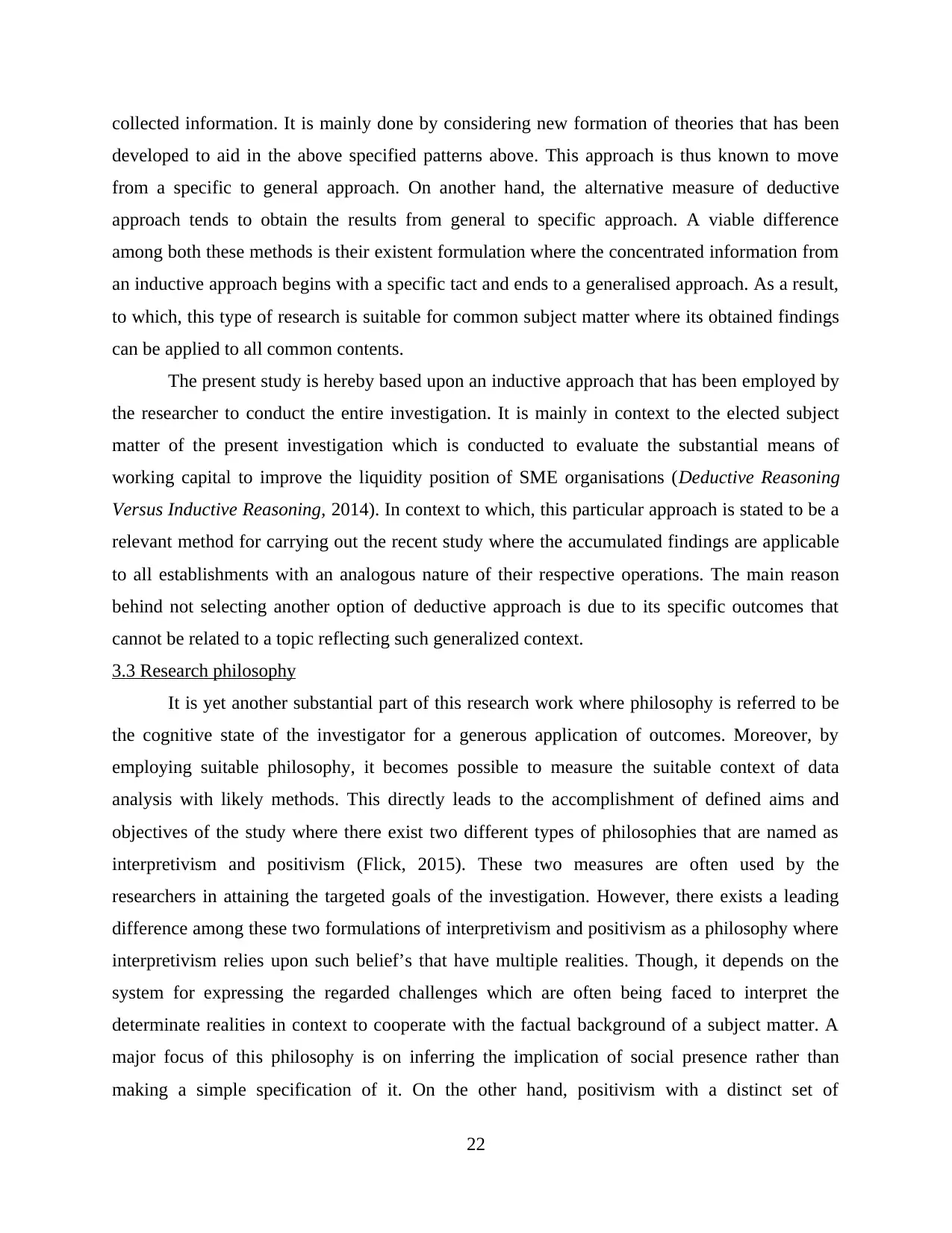
collected information. It is mainly done by considering new formation of theories that has been
developed to aid in the above specified patterns above. This approach is thus known to move
from a specific to general approach. On another hand, the alternative measure of deductive
approach tends to obtain the results from general to specific approach. A viable difference
among both these methods is their existent formulation where the concentrated information from
an inductive approach begins with a specific tact and ends to a generalised approach. As a result,
to which, this type of research is suitable for common subject matter where its obtained findings
can be applied to all common contents.
The present study is hereby based upon an inductive approach that has been employed by
the researcher to conduct the entire investigation. It is mainly in context to the elected subject
matter of the present investigation which is conducted to evaluate the substantial means of
working capital to improve the liquidity position of SME organisations (Deductive Reasoning
Versus Inductive Reasoning, 2014). In context to which, this particular approach is stated to be a
relevant method for carrying out the recent study where the accumulated findings are applicable
to all establishments with an analogous nature of their respective operations. The main reason
behind not selecting another option of deductive approach is due to its specific outcomes that
cannot be related to a topic reflecting such generalized context.
3.3 Research philosophy
It is yet another substantial part of this research work where philosophy is referred to be
the cognitive state of the investigator for a generous application of outcomes. Moreover, by
employing suitable philosophy, it becomes possible to measure the suitable context of data
analysis with likely methods. This directly leads to the accomplishment of defined aims and
objectives of the study where there exist two different types of philosophies that are named as
interpretivism and positivism (Flick, 2015). These two measures are often used by the
researchers in attaining the targeted goals of the investigation. However, there exists a leading
difference among these two formulations of interpretivism and positivism as a philosophy where
interpretivism relies upon such belief’s that have multiple realities. Though, it depends on the
system for expressing the regarded challenges which are often being faced to interpret the
determinate realities in context to cooperate with the factual background of a subject matter. A
major focus of this philosophy is on inferring the implication of social presence rather than
making a simple specification of it. On the other hand, positivism with a distinct set of
22
developed to aid in the above specified patterns above. This approach is thus known to move
from a specific to general approach. On another hand, the alternative measure of deductive
approach tends to obtain the results from general to specific approach. A viable difference
among both these methods is their existent formulation where the concentrated information from
an inductive approach begins with a specific tact and ends to a generalised approach. As a result,
to which, this type of research is suitable for common subject matter where its obtained findings
can be applied to all common contents.
The present study is hereby based upon an inductive approach that has been employed by
the researcher to conduct the entire investigation. It is mainly in context to the elected subject
matter of the present investigation which is conducted to evaluate the substantial means of
working capital to improve the liquidity position of SME organisations (Deductive Reasoning
Versus Inductive Reasoning, 2014). In context to which, this particular approach is stated to be a
relevant method for carrying out the recent study where the accumulated findings are applicable
to all establishments with an analogous nature of their respective operations. The main reason
behind not selecting another option of deductive approach is due to its specific outcomes that
cannot be related to a topic reflecting such generalized context.
3.3 Research philosophy
It is yet another substantial part of this research work where philosophy is referred to be
the cognitive state of the investigator for a generous application of outcomes. Moreover, by
employing suitable philosophy, it becomes possible to measure the suitable context of data
analysis with likely methods. This directly leads to the accomplishment of defined aims and
objectives of the study where there exist two different types of philosophies that are named as
interpretivism and positivism (Flick, 2015). These two measures are often used by the
researchers in attaining the targeted goals of the investigation. However, there exists a leading
difference among these two formulations of interpretivism and positivism as a philosophy where
interpretivism relies upon such belief’s that have multiple realities. Though, it depends on the
system for expressing the regarded challenges which are often being faced to interpret the
determinate realities in context to cooperate with the factual background of a subject matter. A
major focus of this philosophy is on inferring the implication of social presence rather than
making a simple specification of it. On the other hand, positivism with a distinct set of
22
Secure Best Marks with AI Grader
Need help grading? Try our AI Grader for instant feedback on your assignments.

philosophy is wholly dependent on a superior belief of interpreting the world as an extraneous
object that has a single objectivity for conferring the research phenomenon.
It is therefore in context of the recent investigation that has applied the tactic of
interpretivism philosophy. It has been undertaken to link with the humanistic depiction by further
assessing the role of working capital to enhance the liquidity state of SME business
establishments (Singh, 2010). It is where the entire study is hereby based upon a chosen
organisation named Oakman Inns & Restaurants that is a well-established hospitality enterprise
of UK. A main reason behind not selecting another option of positivism as a philosophy is due to
its unexposed facts that are associated with the things related to the research content depicting a
quantitative nature.
3.4 Research design
It is another most important consideration of the recent investigation work where the
researcher will hereby tend to choose a particular design of the study. The chosen design will
then refer to guide the investigator in carrying an impelling study in a directional manner. It
reflects to be a blueprint of the research that supports in determining the actual nature of the
investigation. It is basically in order to acquire the defined objectives of the study by succeeding
toward its designed aims (Mackey and Gass, 2015). It is together depicted to be mandatory step
of the investigator in where each and every investigation necessitates the researcher to make a
primary selection of its design. This proposal consequently guides the overall study that also
enhances the reliable and valid dimensions of the study. In context to which, there exists three
discrete types of research design that involves descriptive, casual or explanatory and exploratory
studies. All three depictions have showcased a dissimilar nature of their proposals where a
descriptive nature of study is relied on mere description of outcomes that has been derived from
the examined subject matter.
This is for instance to delineate this kind of proposal in context to the present entitled
content of the research work. In relation to which, the investigator in the current study will here
describe the definite nature of working capital in order to identify its vital contributions in
improving the liquidity state of the SME business ventures (Gast and Ledford, 2014). It is where
the recent investigation has also chosen a UK based company that is operating in their hospitality
industry. With reference to which, the investigator will here make some liable description of the
subject matter in context to the selected organisation over here by making an in-depth analysis of
23
object that has a single objectivity for conferring the research phenomenon.
It is therefore in context of the recent investigation that has applied the tactic of
interpretivism philosophy. It has been undertaken to link with the humanistic depiction by further
assessing the role of working capital to enhance the liquidity state of SME business
establishments (Singh, 2010). It is where the entire study is hereby based upon a chosen
organisation named Oakman Inns & Restaurants that is a well-established hospitality enterprise
of UK. A main reason behind not selecting another option of positivism as a philosophy is due to
its unexposed facts that are associated with the things related to the research content depicting a
quantitative nature.
3.4 Research design
It is another most important consideration of the recent investigation work where the
researcher will hereby tend to choose a particular design of the study. The chosen design will
then refer to guide the investigator in carrying an impelling study in a directional manner. It
reflects to be a blueprint of the research that supports in determining the actual nature of the
investigation. It is basically in order to acquire the defined objectives of the study by succeeding
toward its designed aims (Mackey and Gass, 2015). It is together depicted to be mandatory step
of the investigator in where each and every investigation necessitates the researcher to make a
primary selection of its design. This proposal consequently guides the overall study that also
enhances the reliable and valid dimensions of the study. In context to which, there exists three
discrete types of research design that involves descriptive, casual or explanatory and exploratory
studies. All three depictions have showcased a dissimilar nature of their proposals where a
descriptive nature of study is relied on mere description of outcomes that has been derived from
the examined subject matter.
This is for instance to delineate this kind of proposal in context to the present entitled
content of the research work. In relation to which, the investigator in the current study will here
describe the definite nature of working capital in order to identify its vital contributions in
improving the liquidity state of the SME business ventures (Gast and Ledford, 2014). It is where
the recent investigation has also chosen a UK based company that is operating in their hospitality
industry. With reference to which, the investigator will here make some liable description of the
subject matter in context to the selected organisation over here by making an in-depth analysis of
23

the research content. In addition to this, explanatory is yet another proposed design of the
investigation that is partially similar to the former design of descriptive study. However, a mere
point of difference hereby lies in their complexity where an explanatory study is a casual format
that does not reflect a penetrative and keen research work like the descriptive one. Lastly, there
exists an exploratory design of the investigation that focuses on developing newer ideas and
thoughts, etc.
The investigator in the current research work has opted for a descriptive design with a to
provide effectual description to portray the contributed factors of working capital that in turn
increases the liquidity condition of businesses operating in SME sector (Garner and Scott, 2013).
However, a leading reason behind not selecting other two alternatives named explanatory and
exploratory is their unsuitable application where the recent subject matter does not tend to
explore newer set of thoughts and ideas. Along with which, there is no such requirement of
elaborating the selected content of the research.
3.5 Research type
The research type is yet another subsequent section of the investigation where the
researcher is hereby required to opt for an impeccable type of the configured study. This in turn
reflects the applied techniques of the investigation where they are fundamentally employed to
carry out the research work in an effective manner (Alvesson and Sköldberg, 2009). It is also
depicted to be an essential section in each and every study where the investigator should hereby
measure a particular technique well in advance. This is fundamentally in order to conduct a
directional study that moves into an accurate direction for an ultimate achievement of its defined
aims and objectives. With an analogous context to it, there exists two leading type of research
types that are conceptually known as quantitative and qualitative sort of investigation.
These research types that will be employed by the researcher not only tend to define the
technical percept of the study but also reflects the nature and design of the study. The qualitative
nature of the study elucidates a theoretical framework of the research where the aggregated set of
data does not represent any numerical nature of information (Kothari, 2011). In contrast to
which, another option of quantitative research type clearly defines numerical set of data with
statistical tools for evaluating the collected set of information. This unit thus works as a guiding
approach that direct the subsequent portions of this chapter where it has manifested a prime
24
investigation that is partially similar to the former design of descriptive study. However, a mere
point of difference hereby lies in their complexity where an explanatory study is a casual format
that does not reflect a penetrative and keen research work like the descriptive one. Lastly, there
exists an exploratory design of the investigation that focuses on developing newer ideas and
thoughts, etc.
The investigator in the current research work has opted for a descriptive design with a to
provide effectual description to portray the contributed factors of working capital that in turn
increases the liquidity condition of businesses operating in SME sector (Garner and Scott, 2013).
However, a leading reason behind not selecting other two alternatives named explanatory and
exploratory is their unsuitable application where the recent subject matter does not tend to
explore newer set of thoughts and ideas. Along with which, there is no such requirement of
elaborating the selected content of the research.
3.5 Research type
The research type is yet another subsequent section of the investigation where the
researcher is hereby required to opt for an impeccable type of the configured study. This in turn
reflects the applied techniques of the investigation where they are fundamentally employed to
carry out the research work in an effective manner (Alvesson and Sköldberg, 2009). It is also
depicted to be an essential section in each and every study where the investigator should hereby
measure a particular technique well in advance. This is fundamentally in order to conduct a
directional study that moves into an accurate direction for an ultimate achievement of its defined
aims and objectives. With an analogous context to it, there exists two leading type of research
types that are conceptually known as quantitative and qualitative sort of investigation.
These research types that will be employed by the researcher not only tend to define the
technical percept of the study but also reflects the nature and design of the study. The qualitative
nature of the study elucidates a theoretical framework of the research where the aggregated set of
data does not represent any numerical nature of information (Kothari, 2011). In contrast to
which, another option of quantitative research type clearly defines numerical set of data with
statistical tools for evaluating the collected set of information. This unit thus works as a guiding
approach that direct the subsequent portions of this chapter where it has manifested a prime
24
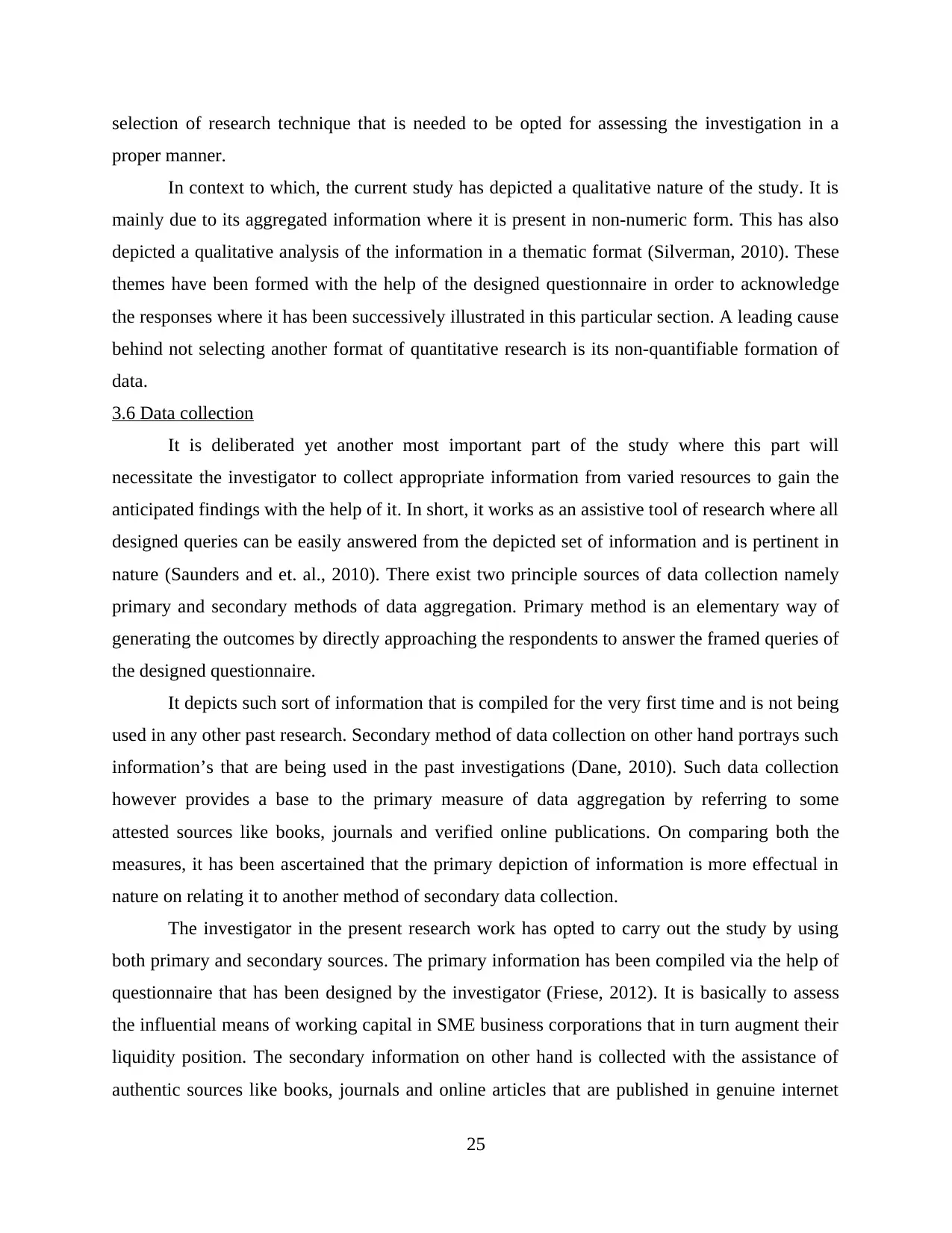
selection of research technique that is needed to be opted for assessing the investigation in a
proper manner.
In context to which, the current study has depicted a qualitative nature of the study. It is
mainly due to its aggregated information where it is present in non-numeric form. This has also
depicted a qualitative analysis of the information in a thematic format (Silverman, 2010). These
themes have been formed with the help of the designed questionnaire in order to acknowledge
the responses where it has been successively illustrated in this particular section. A leading cause
behind not selecting another format of quantitative research is its non-quantifiable formation of
data.
3.6 Data collection
It is deliberated yet another most important part of the study where this part will
necessitate the investigator to collect appropriate information from varied resources to gain the
anticipated findings with the help of it. In short, it works as an assistive tool of research where all
designed queries can be easily answered from the depicted set of information and is pertinent in
nature (Saunders and et. al., 2010). There exist two principle sources of data collection namely
primary and secondary methods of data aggregation. Primary method is an elementary way of
generating the outcomes by directly approaching the respondents to answer the framed queries of
the designed questionnaire.
It depicts such sort of information that is compiled for the very first time and is not being
used in any other past research. Secondary method of data collection on other hand portrays such
information’s that are being used in the past investigations (Dane, 2010). Such data collection
however provides a base to the primary measure of data aggregation by referring to some
attested sources like books, journals and verified online publications. On comparing both the
measures, it has been ascertained that the primary depiction of information is more effectual in
nature on relating it to another method of secondary data collection.
The investigator in the present research work has opted to carry out the study by using
both primary and secondary sources. The primary information has been compiled via the help of
questionnaire that has been designed by the investigator (Friese, 2012). It is basically to assess
the influential means of working capital in SME business corporations that in turn augment their
liquidity position. The secondary information on other hand is collected with the assistance of
authentic sources like books, journals and online articles that are published in genuine internet
25
proper manner.
In context to which, the current study has depicted a qualitative nature of the study. It is
mainly due to its aggregated information where it is present in non-numeric form. This has also
depicted a qualitative analysis of the information in a thematic format (Silverman, 2010). These
themes have been formed with the help of the designed questionnaire in order to acknowledge
the responses where it has been successively illustrated in this particular section. A leading cause
behind not selecting another format of quantitative research is its non-quantifiable formation of
data.
3.6 Data collection
It is deliberated yet another most important part of the study where this part will
necessitate the investigator to collect appropriate information from varied resources to gain the
anticipated findings with the help of it. In short, it works as an assistive tool of research where all
designed queries can be easily answered from the depicted set of information and is pertinent in
nature (Saunders and et. al., 2010). There exist two principle sources of data collection namely
primary and secondary methods of data aggregation. Primary method is an elementary way of
generating the outcomes by directly approaching the respondents to answer the framed queries of
the designed questionnaire.
It depicts such sort of information that is compiled for the very first time and is not being
used in any other past research. Secondary method of data collection on other hand portrays such
information’s that are being used in the past investigations (Dane, 2010). Such data collection
however provides a base to the primary measure of data aggregation by referring to some
attested sources like books, journals and verified online publications. On comparing both the
measures, it has been ascertained that the primary depiction of information is more effectual in
nature on relating it to another method of secondary data collection.
The investigator in the present research work has opted to carry out the study by using
both primary and secondary sources. The primary information has been compiled via the help of
questionnaire that has been designed by the investigator (Friese, 2012). It is basically to assess
the influential means of working capital in SME business corporations that in turn augment their
liquidity position. The secondary information on other hand is collected with the assistance of
authentic sources like books, journals and online articles that are published in genuine internet
25
Paraphrase This Document
Need a fresh take? Get an instant paraphrase of this document with our AI Paraphraser
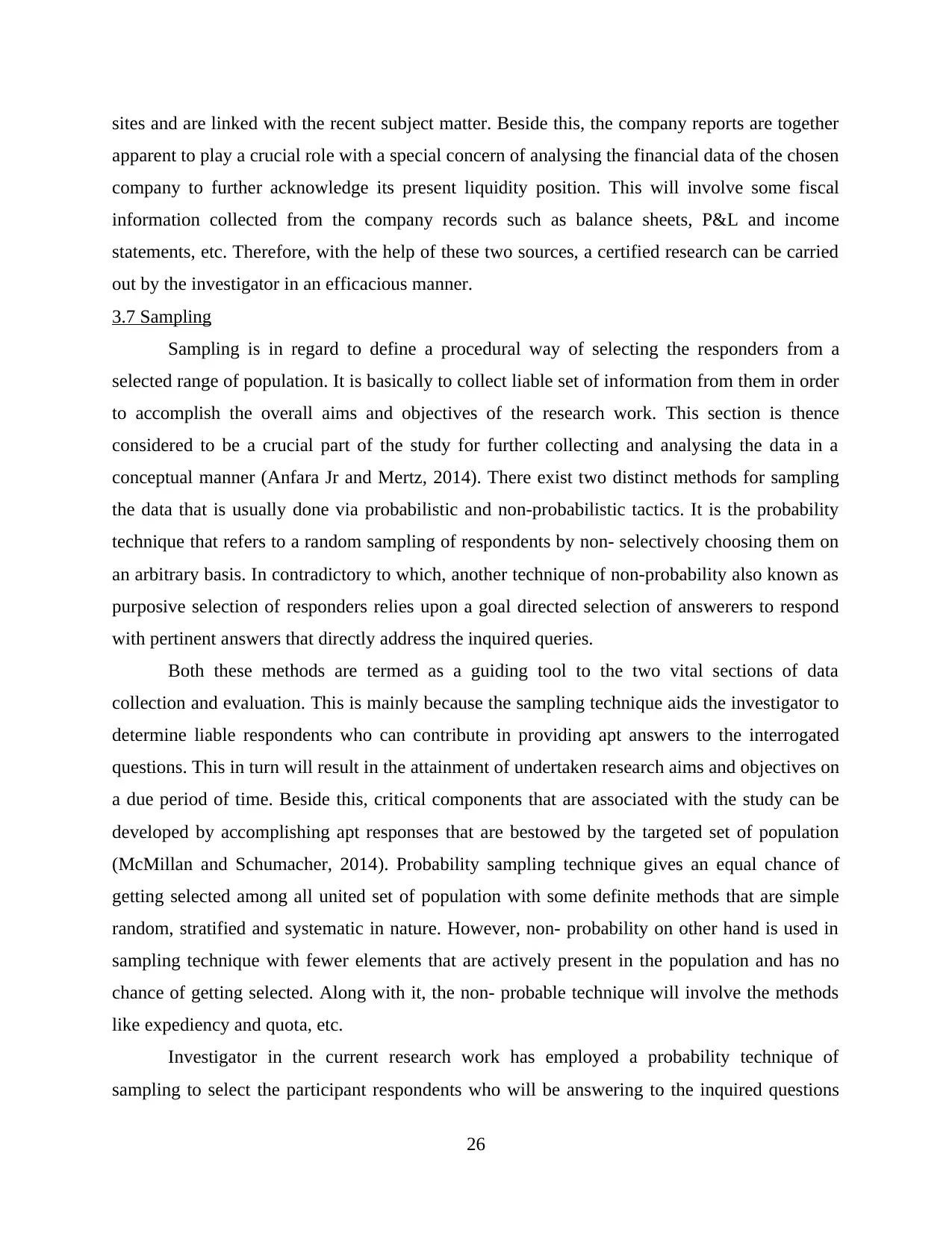
sites and are linked with the recent subject matter. Beside this, the company reports are together
apparent to play a crucial role with a special concern of analysing the financial data of the chosen
company to further acknowledge its present liquidity position. This will involve some fiscal
information collected from the company records such as balance sheets, P&L and income
statements, etc. Therefore, with the help of these two sources, a certified research can be carried
out by the investigator in an efficacious manner.
3.7 Sampling
Sampling is in regard to define a procedural way of selecting the responders from a
selected range of population. It is basically to collect liable set of information from them in order
to accomplish the overall aims and objectives of the research work. This section is thence
considered to be a crucial part of the study for further collecting and analysing the data in a
conceptual manner (Anfara Jr and Mertz, 2014). There exist two distinct methods for sampling
the data that is usually done via probabilistic and non-probabilistic tactics. It is the probability
technique that refers to a random sampling of respondents by non- selectively choosing them on
an arbitrary basis. In contradictory to which, another technique of non-probability also known as
purposive selection of responders relies upon a goal directed selection of answerers to respond
with pertinent answers that directly address the inquired queries.
Both these methods are termed as a guiding tool to the two vital sections of data
collection and evaluation. This is mainly because the sampling technique aids the investigator to
determine liable respondents who can contribute in providing apt answers to the interrogated
questions. This in turn will result in the attainment of undertaken research aims and objectives on
a due period of time. Beside this, critical components that are associated with the study can be
developed by accomplishing apt responses that are bestowed by the targeted set of population
(McMillan and Schumacher, 2014). Probability sampling technique gives an equal chance of
getting selected among all united set of population with some definite methods that are simple
random, stratified and systematic in nature. However, non- probability on other hand is used in
sampling technique with fewer elements that are actively present in the population and has no
chance of getting selected. Along with it, the non- probable technique will involve the methods
like expediency and quota, etc.
Investigator in the current research work has employed a probability technique of
sampling to select the participant respondents who will be answering to the inquired questions
26
apparent to play a crucial role with a special concern of analysing the financial data of the chosen
company to further acknowledge its present liquidity position. This will involve some fiscal
information collected from the company records such as balance sheets, P&L and income
statements, etc. Therefore, with the help of these two sources, a certified research can be carried
out by the investigator in an efficacious manner.
3.7 Sampling
Sampling is in regard to define a procedural way of selecting the responders from a
selected range of population. It is basically to collect liable set of information from them in order
to accomplish the overall aims and objectives of the research work. This section is thence
considered to be a crucial part of the study for further collecting and analysing the data in a
conceptual manner (Anfara Jr and Mertz, 2014). There exist two distinct methods for sampling
the data that is usually done via probabilistic and non-probabilistic tactics. It is the probability
technique that refers to a random sampling of respondents by non- selectively choosing them on
an arbitrary basis. In contradictory to which, another technique of non-probability also known as
purposive selection of responders relies upon a goal directed selection of answerers to respond
with pertinent answers that directly address the inquired queries.
Both these methods are termed as a guiding tool to the two vital sections of data
collection and evaluation. This is mainly because the sampling technique aids the investigator to
determine liable respondents who can contribute in providing apt answers to the interrogated
questions. This in turn will result in the attainment of undertaken research aims and objectives on
a due period of time. Beside this, critical components that are associated with the study can be
developed by accomplishing apt responses that are bestowed by the targeted set of population
(McMillan and Schumacher, 2014). Probability sampling technique gives an equal chance of
getting selected among all united set of population with some definite methods that are simple
random, stratified and systematic in nature. However, non- probability on other hand is used in
sampling technique with fewer elements that are actively present in the population and has no
chance of getting selected. Along with it, the non- probable technique will involve the methods
like expediency and quota, etc.
Investigator in the current research work has employed a probability technique of
sampling to select the participant respondents who will be answering to the inquired questions
26

designed in the framed set of questionnaires. It is where the responders in it have been selected
purposively from the targeted set of population. The researcher in this particular study has
chosen the employees of Oakman Inn & Restaurant who are working in its financial department
(Van den Akker and et.al., 2006). In context to which, there existed a consolidated ratio of total
10 employees working in the finance department and has included both superior and subordinate
bodies. A major reason behind not selecting another method is its divergent nature where the
entire study is based upon a selected organisational body and thus cannot be supported by
random sampling technique.
3.8 Data analysis
It is yet another most important part of the study that analyses the primary sources of
data. It is basically to accomplish the defined aims and objectives of the investigation by further
exploring the gathered set of information with the help of appropriate techniques that will aid in
answering the research questions. Qualitative and quantitative methods are the two accessible
measures for obtaining the anticipated findings of the research work (Neergaard and Ulhoi,
2007). A major difference among both these measures is their typical nature of assessment where
the qualitative technique is usually adopted in case the compiled information depicts a non-
numerical format. In relation to which, it includes different formation of themes to acknowledge
the overall responses of the respondents. Though, the quantitative technique is generally
employed when the aggregated set of data is numerical in nature. For which, varied statistical
tools are being employed for scrutinising the collected set of data in an accurate manner.
The current study has depicted a qualitative technique that has been employed by the
researcher to form distinct themes. It is fundamentally on the basis of its aimed goals and
objectives that is required to draw a liable depiction of working capital to find out its
contributory means to enhance the liquidity position of SME’s (Research design, 2009). It is
based on a designated SME of UK which is a well-established hospitality organisation named
Oakman Inn & Restaurant. However, a main reason behind not choosing quantitative technique
of data analysis is its non-numeric context of data. Due to which, qualitative technique is a
prominent way of ensuring the acquired responses that are being provided by the employees of
the designated establishment by together assuring liable accomplishment of aims and objectives.
3.9 Reliability and validity
27
purposively from the targeted set of population. The researcher in this particular study has
chosen the employees of Oakman Inn & Restaurant who are working in its financial department
(Van den Akker and et.al., 2006). In context to which, there existed a consolidated ratio of total
10 employees working in the finance department and has included both superior and subordinate
bodies. A major reason behind not selecting another method is its divergent nature where the
entire study is based upon a selected organisational body and thus cannot be supported by
random sampling technique.
3.8 Data analysis
It is yet another most important part of the study that analyses the primary sources of
data. It is basically to accomplish the defined aims and objectives of the investigation by further
exploring the gathered set of information with the help of appropriate techniques that will aid in
answering the research questions. Qualitative and quantitative methods are the two accessible
measures for obtaining the anticipated findings of the research work (Neergaard and Ulhoi,
2007). A major difference among both these measures is their typical nature of assessment where
the qualitative technique is usually adopted in case the compiled information depicts a non-
numerical format. In relation to which, it includes different formation of themes to acknowledge
the overall responses of the respondents. Though, the quantitative technique is generally
employed when the aggregated set of data is numerical in nature. For which, varied statistical
tools are being employed for scrutinising the collected set of data in an accurate manner.
The current study has depicted a qualitative technique that has been employed by the
researcher to form distinct themes. It is fundamentally on the basis of its aimed goals and
objectives that is required to draw a liable depiction of working capital to find out its
contributory means to enhance the liquidity position of SME’s (Research design, 2009). It is
based on a designated SME of UK which is a well-established hospitality organisation named
Oakman Inn & Restaurant. However, a main reason behind not choosing quantitative technique
of data analysis is its non-numeric context of data. Due to which, qualitative technique is a
prominent way of ensuring the acquired responses that are being provided by the employees of
the designated establishment by together assuring liable accomplishment of aims and objectives.
3.9 Reliability and validity
27

Reliability and validity are the two main considerations of the researcher while
conducting the study with the help of which, it gets possible for the investigator to eradicate any
kind of variation and discrepancy that are related to the research work. It is therefore depicted to
be an essential duty of the investigator to certify the relevancy and dependability of the
investigation (Manion, Cohen and Morrison, 2007). It is basically to ensure that the overall study
has been carried out in a consistent manner with efficient outcomes that in turn increases the
status of the conducted study. However, distinct activities are required to be measured by the
researcher to depict a reliable nature of the study. These actions are however required to be taken
well in advance where it must lead to the accomplishment of desirable aims and objectives that
have been outlined by the investigator while initiating the research work. Research validity on
other hand tends to support in corresponding to the clarity of the predefined goals and targets of
the study. It is therefore depicted to be a supportive tool of assessment in terms of directing
towards a reliable study.
These two elements have a major stress upon the two main activities of data collection
and data analysis. This is to fundamentally assure the authenticity of the collected set of
information from verified sources of data collection. Thus, in context to deliberate the recent
study, it is based upon both primary and secondary data collection methods where the researcher
has hereby relied upon genuine sources of information (Wåhlberg, 2012). The primary data
collection has reflected a direct approach taken up by the researcher to enquire the respondents
where it depicted a credible study. However, the secondary data collection method includes three
different types of sources by necessitating the investigator to refer to certified books and journal
along with genuine internet resources like online publications, etc. Both these measures of
reliability and validity in turn results into increase the efficacy of the outcomes in all possible
modes. Apart from this, at the time of gathering secondary information, the researcher has
hereby referred to recent publications. This system has therefore ensured a valid and reliable
study by the investigator.
3.10 Ethical consideration
This section is depicted to be the most important part of this chapter that duly showcases
the moralised approach of the researcher while carrying out the investigation. Ethics refers to a
vital kind of philosophy that includes classifying and signifying the factual concepts of right and
wrong. It is basically to portray an effective nature of the by adopting an appropriate way
28
conducting the study with the help of which, it gets possible for the investigator to eradicate any
kind of variation and discrepancy that are related to the research work. It is therefore depicted to
be an essential duty of the investigator to certify the relevancy and dependability of the
investigation (Manion, Cohen and Morrison, 2007). It is basically to ensure that the overall study
has been carried out in a consistent manner with efficient outcomes that in turn increases the
status of the conducted study. However, distinct activities are required to be measured by the
researcher to depict a reliable nature of the study. These actions are however required to be taken
well in advance where it must lead to the accomplishment of desirable aims and objectives that
have been outlined by the investigator while initiating the research work. Research validity on
other hand tends to support in corresponding to the clarity of the predefined goals and targets of
the study. It is therefore depicted to be a supportive tool of assessment in terms of directing
towards a reliable study.
These two elements have a major stress upon the two main activities of data collection
and data analysis. This is to fundamentally assure the authenticity of the collected set of
information from verified sources of data collection. Thus, in context to deliberate the recent
study, it is based upon both primary and secondary data collection methods where the researcher
has hereby relied upon genuine sources of information (Wåhlberg, 2012). The primary data
collection has reflected a direct approach taken up by the researcher to enquire the respondents
where it depicted a credible study. However, the secondary data collection method includes three
different types of sources by necessitating the investigator to refer to certified books and journal
along with genuine internet resources like online publications, etc. Both these measures of
reliability and validity in turn results into increase the efficacy of the outcomes in all possible
modes. Apart from this, at the time of gathering secondary information, the researcher has
hereby referred to recent publications. This system has therefore ensured a valid and reliable
study by the investigator.
3.10 Ethical consideration
This section is depicted to be the most important part of this chapter that duly showcases
the moralised approach of the researcher while carrying out the investigation. Ethics refers to a
vital kind of philosophy that includes classifying and signifying the factual concepts of right and
wrong. It is basically to portray an effective nature of the by adopting an appropriate way
28
Secure Best Marks with AI Grader
Need help grading? Try our AI Grader for instant feedback on your assignments.
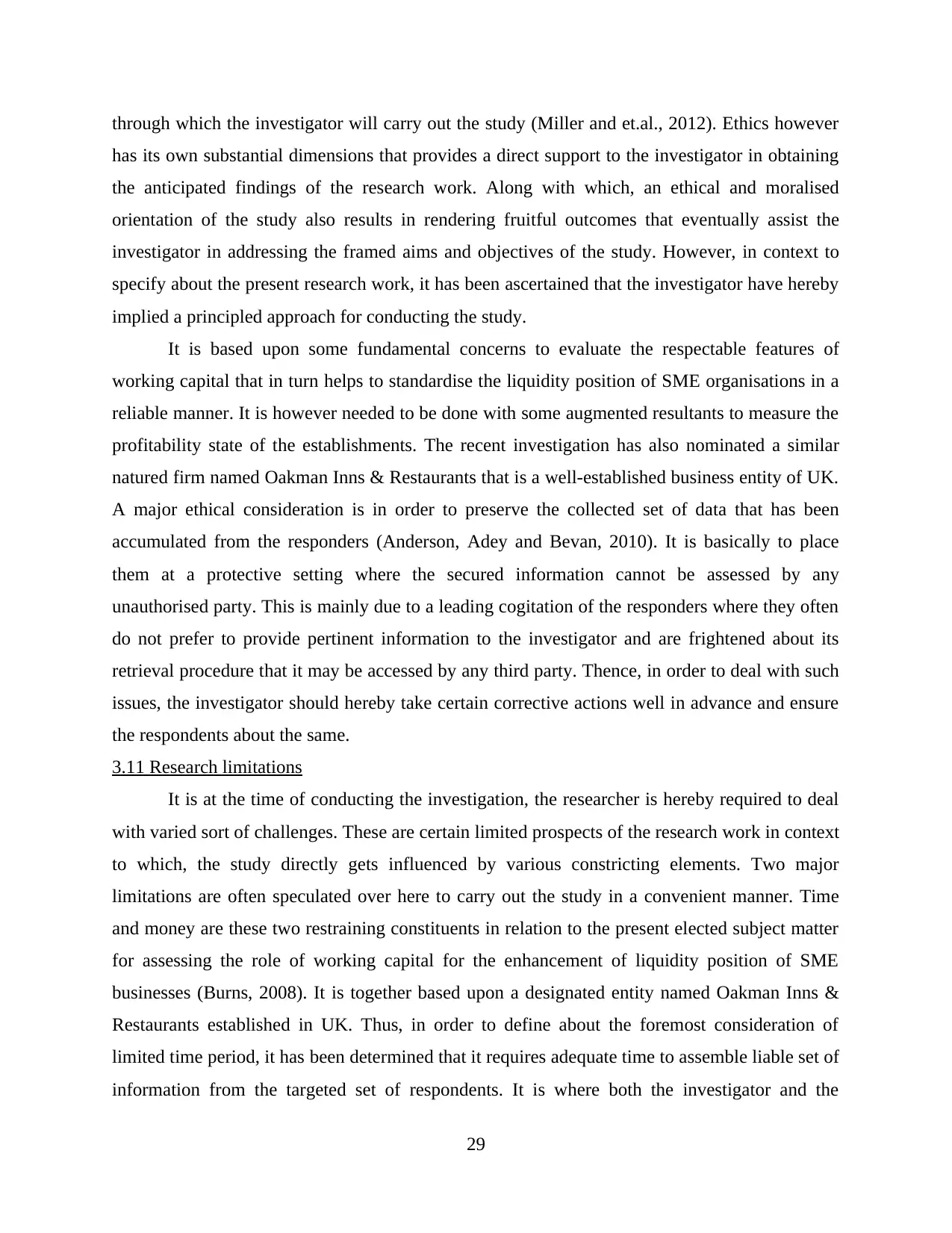
through which the investigator will carry out the study (Miller and et.al., 2012). Ethics however
has its own substantial dimensions that provides a direct support to the investigator in obtaining
the anticipated findings of the research work. Along with which, an ethical and moralised
orientation of the study also results in rendering fruitful outcomes that eventually assist the
investigator in addressing the framed aims and objectives of the study. However, in context to
specify about the present research work, it has been ascertained that the investigator have hereby
implied a principled approach for conducting the study.
It is based upon some fundamental concerns to evaluate the respectable features of
working capital that in turn helps to standardise the liquidity position of SME organisations in a
reliable manner. It is however needed to be done with some augmented resultants to measure the
profitability state of the establishments. The recent investigation has also nominated a similar
natured firm named Oakman Inns & Restaurants that is a well-established business entity of UK.
A major ethical consideration is in order to preserve the collected set of data that has been
accumulated from the responders (Anderson, Adey and Bevan, 2010). It is basically to place
them at a protective setting where the secured information cannot be assessed by any
unauthorised party. This is mainly due to a leading cogitation of the responders where they often
do not prefer to provide pertinent information to the investigator and are frightened about its
retrieval procedure that it may be accessed by any third party. Thence, in order to deal with such
issues, the investigator should hereby take certain corrective actions well in advance and ensure
the respondents about the same.
3.11 Research limitations
It is at the time of conducting the investigation, the researcher is hereby required to deal
with varied sort of challenges. These are certain limited prospects of the research work in context
to which, the study directly gets influenced by various constricting elements. Two major
limitations are often speculated over here to carry out the study in a convenient manner. Time
and money are these two restraining constituents in relation to the present elected subject matter
for assessing the role of working capital for the enhancement of liquidity position of SME
businesses (Burns, 2008). It is together based upon a designated entity named Oakman Inns &
Restaurants established in UK. Thus, in order to define about the foremost consideration of
limited time period, it has been determined that it requires adequate time to assemble liable set of
information from the targeted set of respondents. It is where both the investigator and the
29
has its own substantial dimensions that provides a direct support to the investigator in obtaining
the anticipated findings of the research work. Along with which, an ethical and moralised
orientation of the study also results in rendering fruitful outcomes that eventually assist the
investigator in addressing the framed aims and objectives of the study. However, in context to
specify about the present research work, it has been ascertained that the investigator have hereby
implied a principled approach for conducting the study.
It is based upon some fundamental concerns to evaluate the respectable features of
working capital that in turn helps to standardise the liquidity position of SME organisations in a
reliable manner. It is however needed to be done with some augmented resultants to measure the
profitability state of the establishments. The recent investigation has also nominated a similar
natured firm named Oakman Inns & Restaurants that is a well-established business entity of UK.
A major ethical consideration is in order to preserve the collected set of data that has been
accumulated from the responders (Anderson, Adey and Bevan, 2010). It is basically to place
them at a protective setting where the secured information cannot be assessed by any
unauthorised party. This is mainly due to a leading cogitation of the responders where they often
do not prefer to provide pertinent information to the investigator and are frightened about its
retrieval procedure that it may be accessed by any third party. Thence, in order to deal with such
issues, the investigator should hereby take certain corrective actions well in advance and ensure
the respondents about the same.
3.11 Research limitations
It is at the time of conducting the investigation, the researcher is hereby required to deal
with varied sort of challenges. These are certain limited prospects of the research work in context
to which, the study directly gets influenced by various constricting elements. Two major
limitations are often speculated over here to carry out the study in a convenient manner. Time
and money are these two restraining constituents in relation to the present elected subject matter
for assessing the role of working capital for the enhancement of liquidity position of SME
businesses (Burns, 2008). It is together based upon a designated entity named Oakman Inns &
Restaurants established in UK. Thus, in order to define about the foremost consideration of
limited time period, it has been determined that it requires adequate time to assemble liable set of
information from the targeted set of respondents. It is where both the investigator and the
29
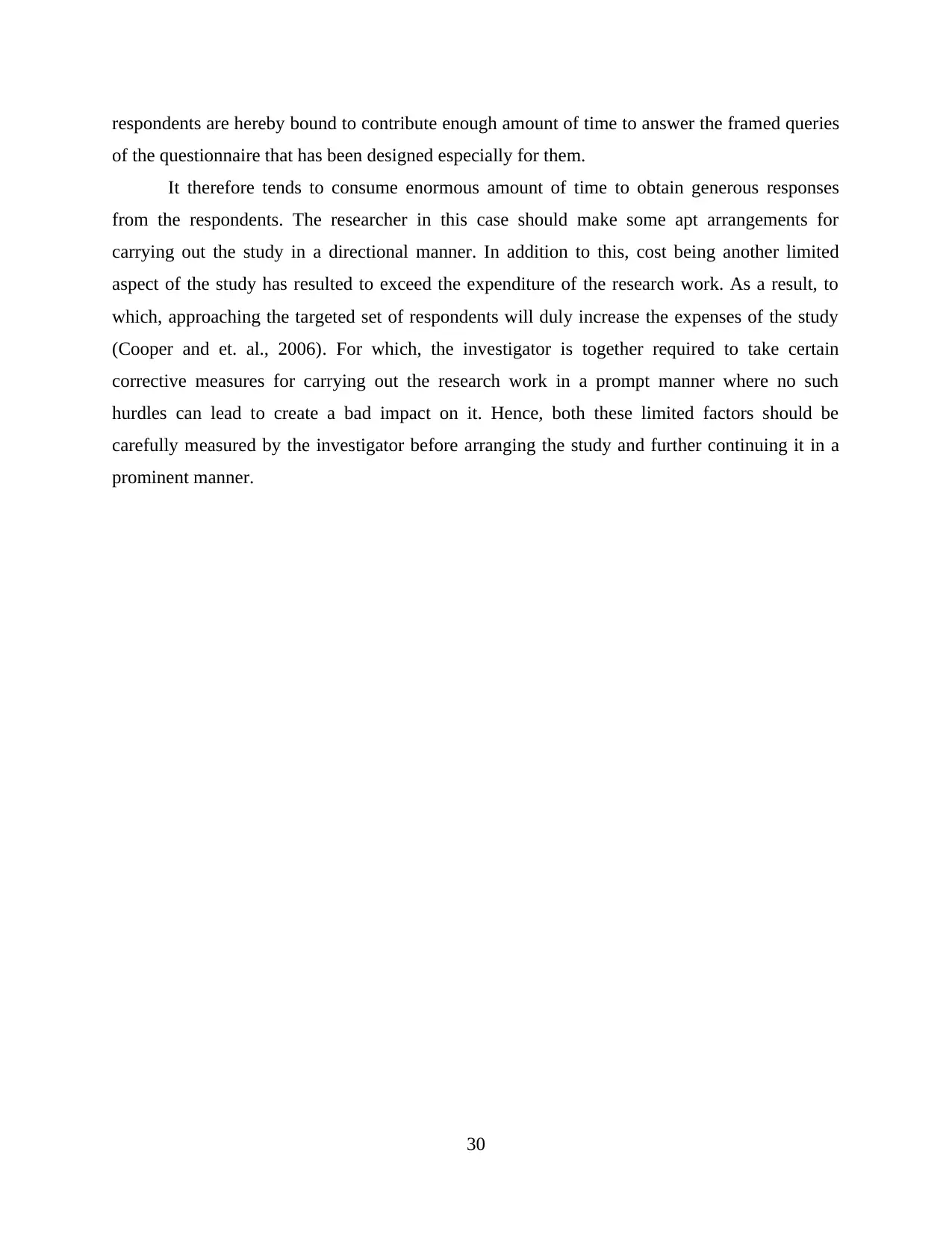
respondents are hereby bound to contribute enough amount of time to answer the framed queries
of the questionnaire that has been designed especially for them.
It therefore tends to consume enormous amount of time to obtain generous responses
from the respondents. The researcher in this case should make some apt arrangements for
carrying out the study in a directional manner. In addition to this, cost being another limited
aspect of the study has resulted to exceed the expenditure of the research work. As a result, to
which, approaching the targeted set of respondents will duly increase the expenses of the study
(Cooper and et. al., 2006). For which, the investigator is together required to take certain
corrective measures for carrying out the research work in a prompt manner where no such
hurdles can lead to create a bad impact on it. Hence, both these limited factors should be
carefully measured by the investigator before arranging the study and further continuing it in a
prominent manner.
30
of the questionnaire that has been designed especially for them.
It therefore tends to consume enormous amount of time to obtain generous responses
from the respondents. The researcher in this case should make some apt arrangements for
carrying out the study in a directional manner. In addition to this, cost being another limited
aspect of the study has resulted to exceed the expenditure of the research work. As a result, to
which, approaching the targeted set of respondents will duly increase the expenses of the study
(Cooper and et. al., 2006). For which, the investigator is together required to take certain
corrective measures for carrying out the research work in a prompt manner where no such
hurdles can lead to create a bad impact on it. Hence, both these limited factors should be
carefully measured by the investigator before arranging the study and further continuing it in a
prominent manner.
30
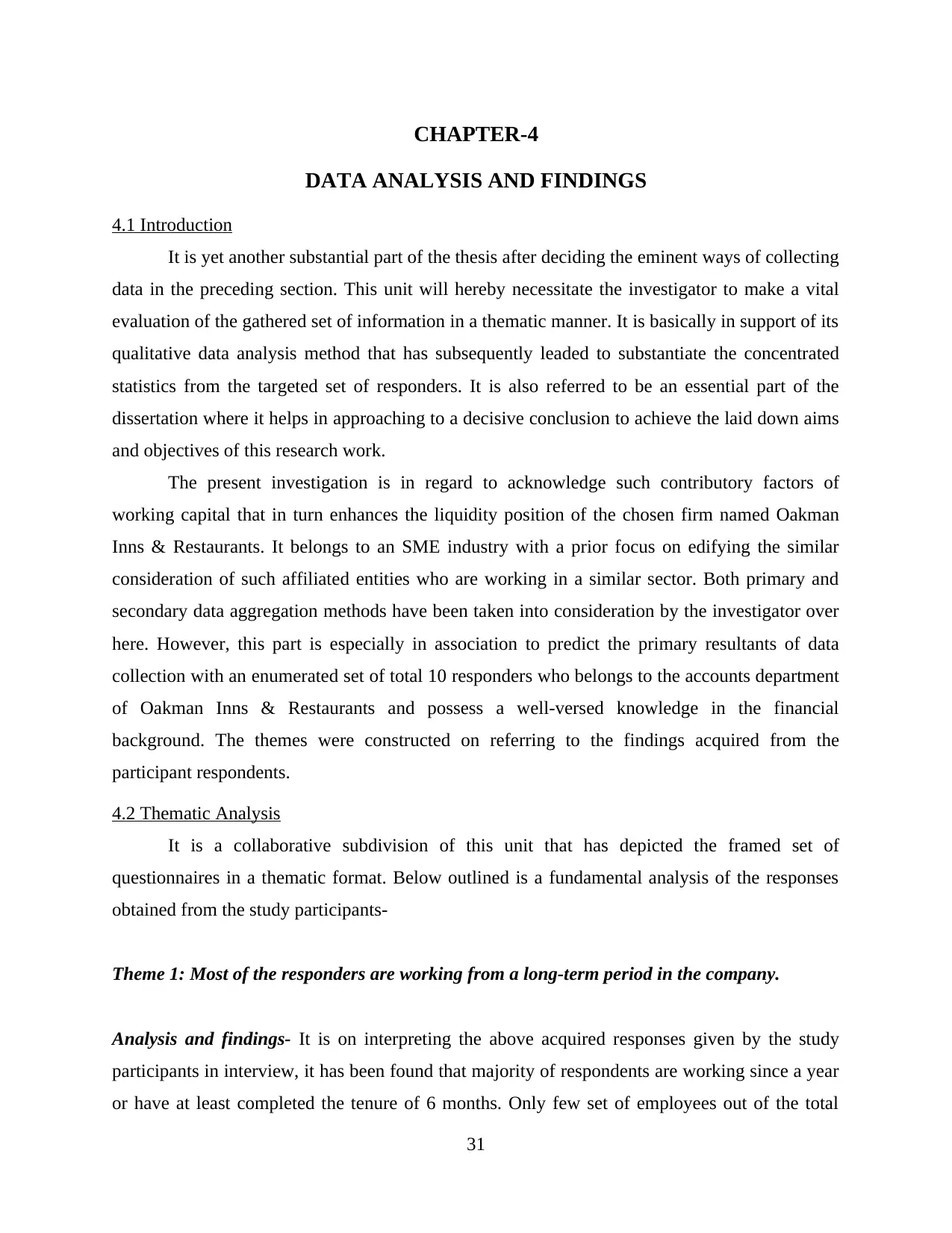
CHAPTER-4
DATA ANALYSIS AND FINDINGS
4.1 Introduction
It is yet another substantial part of the thesis after deciding the eminent ways of collecting
data in the preceding section. This unit will hereby necessitate the investigator to make a vital
evaluation of the gathered set of information in a thematic manner. It is basically in support of its
qualitative data analysis method that has subsequently leaded to substantiate the concentrated
statistics from the targeted set of responders. It is also referred to be an essential part of the
dissertation where it helps in approaching to a decisive conclusion to achieve the laid down aims
and objectives of this research work.
The present investigation is in regard to acknowledge such contributory factors of
working capital that in turn enhances the liquidity position of the chosen firm named Oakman
Inns & Restaurants. It belongs to an SME industry with a prior focus on edifying the similar
consideration of such affiliated entities who are working in a similar sector. Both primary and
secondary data aggregation methods have been taken into consideration by the investigator over
here. However, this part is especially in association to predict the primary resultants of data
collection with an enumerated set of total 10 responders who belongs to the accounts department
of Oakman Inns & Restaurants and possess a well-versed knowledge in the financial
background. The themes were constructed on referring to the findings acquired from the
participant respondents.
4.2 Thematic Analysis
It is a collaborative subdivision of this unit that has depicted the framed set of
questionnaires in a thematic format. Below outlined is a fundamental analysis of the responses
obtained from the study participants-
Theme 1: Most of the responders are working from a long-term period in the company.
Analysis and findings- It is on interpreting the above acquired responses given by the study
participants in interview, it has been found that majority of respondents are working since a year
or have at least completed the tenure of 6 months. Only few set of employees out of the total
31
DATA ANALYSIS AND FINDINGS
4.1 Introduction
It is yet another substantial part of the thesis after deciding the eminent ways of collecting
data in the preceding section. This unit will hereby necessitate the investigator to make a vital
evaluation of the gathered set of information in a thematic manner. It is basically in support of its
qualitative data analysis method that has subsequently leaded to substantiate the concentrated
statistics from the targeted set of responders. It is also referred to be an essential part of the
dissertation where it helps in approaching to a decisive conclusion to achieve the laid down aims
and objectives of this research work.
The present investigation is in regard to acknowledge such contributory factors of
working capital that in turn enhances the liquidity position of the chosen firm named Oakman
Inns & Restaurants. It belongs to an SME industry with a prior focus on edifying the similar
consideration of such affiliated entities who are working in a similar sector. Both primary and
secondary data aggregation methods have been taken into consideration by the investigator over
here. However, this part is especially in association to predict the primary resultants of data
collection with an enumerated set of total 10 responders who belongs to the accounts department
of Oakman Inns & Restaurants and possess a well-versed knowledge in the financial
background. The themes were constructed on referring to the findings acquired from the
participant respondents.
4.2 Thematic Analysis
It is a collaborative subdivision of this unit that has depicted the framed set of
questionnaires in a thematic format. Below outlined is a fundamental analysis of the responses
obtained from the study participants-
Theme 1: Most of the responders are working from a long-term period in the company.
Analysis and findings- It is on interpreting the above acquired responses given by the study
participants in interview, it has been found that majority of respondents are working since a year
or have at least completed the tenure of 6 months. Only few set of employees out of the total
31
Paraphrase This Document
Need a fresh take? Get an instant paraphrase of this document with our AI Paraphraser
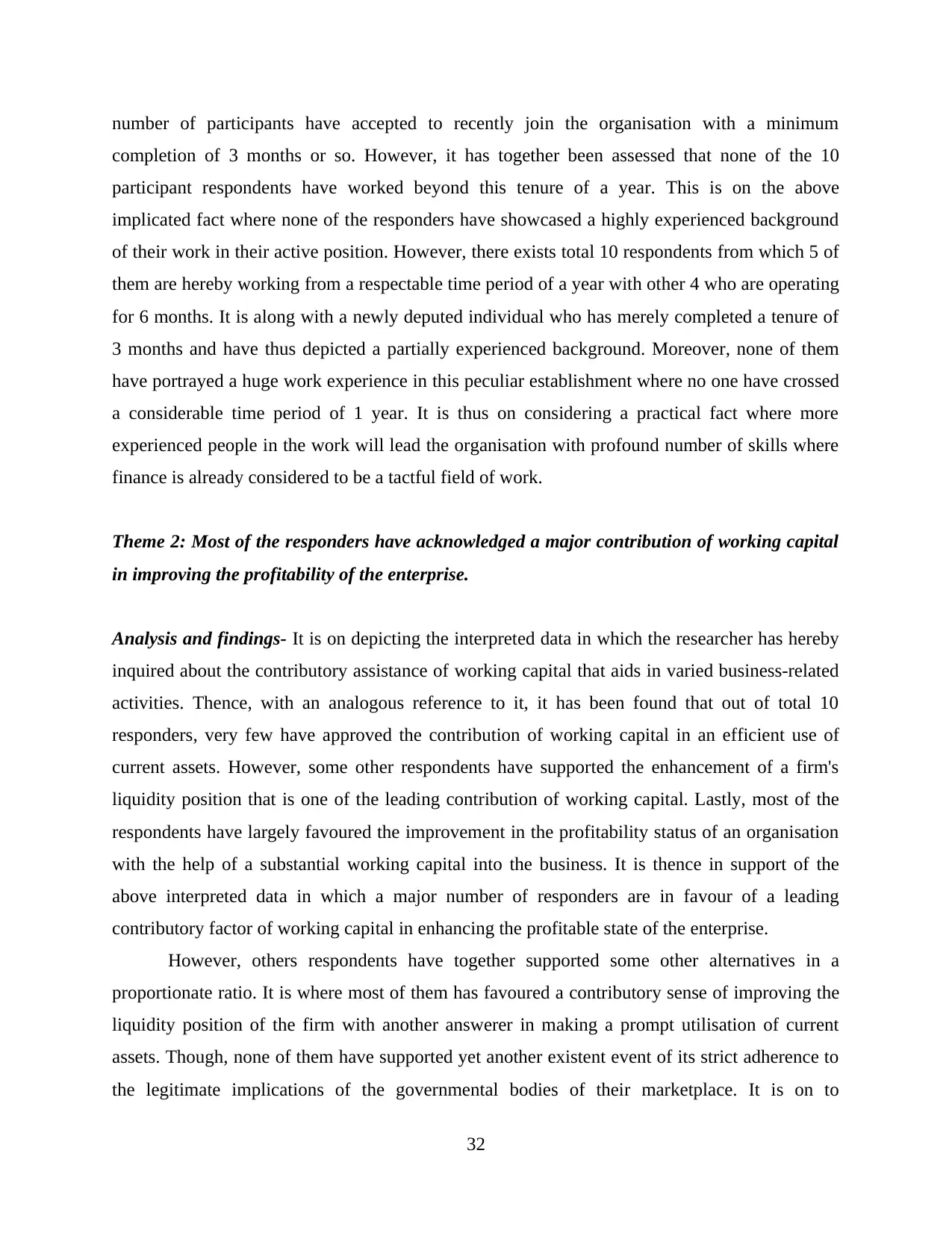
number of participants have accepted to recently join the organisation with a minimum
completion of 3 months or so. However, it has together been assessed that none of the 10
participant respondents have worked beyond this tenure of a year. This is on the above
implicated fact where none of the responders have showcased a highly experienced background
of their work in their active position. However, there exists total 10 respondents from which 5 of
them are hereby working from a respectable time period of a year with other 4 who are operating
for 6 months. It is along with a newly deputed individual who has merely completed a tenure of
3 months and have thus depicted a partially experienced background. Moreover, none of them
have portrayed a huge work experience in this peculiar establishment where no one have crossed
a considerable time period of 1 year. It is thus on considering a practical fact where more
experienced people in the work will lead the organisation with profound number of skills where
finance is already considered to be a tactful field of work.
Theme 2: Most of the responders have acknowledged a major contribution of working capital
in improving the profitability of the enterprise.
Analysis and findings- It is on depicting the interpreted data in which the researcher has hereby
inquired about the contributory assistance of working capital that aids in varied business-related
activities. Thence, with an analogous reference to it, it has been found that out of total 10
responders, very few have approved the contribution of working capital in an efficient use of
current assets. However, some other respondents have supported the enhancement of a firm's
liquidity position that is one of the leading contribution of working capital. Lastly, most of the
respondents have largely favoured the improvement in the profitability status of an organisation
with the help of a substantial working capital into the business. It is thence in support of the
above interpreted data in which a major number of responders are in favour of a leading
contributory factor of working capital in enhancing the profitable state of the enterprise.
However, others respondents have together supported some other alternatives in a
proportionate ratio. It is where most of them has favoured a contributory sense of improving the
liquidity position of the firm with another answerer in making a prompt utilisation of current
assets. Though, none of them have supported yet another existent event of its strict adherence to
the legitimate implications of the governmental bodies of their marketplace. It is on to
32
completion of 3 months or so. However, it has together been assessed that none of the 10
participant respondents have worked beyond this tenure of a year. This is on the above
implicated fact where none of the responders have showcased a highly experienced background
of their work in their active position. However, there exists total 10 respondents from which 5 of
them are hereby working from a respectable time period of a year with other 4 who are operating
for 6 months. It is along with a newly deputed individual who has merely completed a tenure of
3 months and have thus depicted a partially experienced background. Moreover, none of them
have portrayed a huge work experience in this peculiar establishment where no one have crossed
a considerable time period of 1 year. It is thus on considering a practical fact where more
experienced people in the work will lead the organisation with profound number of skills where
finance is already considered to be a tactful field of work.
Theme 2: Most of the responders have acknowledged a major contribution of working capital
in improving the profitability of the enterprise.
Analysis and findings- It is on depicting the interpreted data in which the researcher has hereby
inquired about the contributory assistance of working capital that aids in varied business-related
activities. Thence, with an analogous reference to it, it has been found that out of total 10
responders, very few have approved the contribution of working capital in an efficient use of
current assets. However, some other respondents have supported the enhancement of a firm's
liquidity position that is one of the leading contribution of working capital. Lastly, most of the
respondents have largely favoured the improvement in the profitability status of an organisation
with the help of a substantial working capital into the business. It is thence in support of the
above interpreted data in which a major number of responders are in favour of a leading
contributory factor of working capital in enhancing the profitable state of the enterprise.
However, others respondents have together supported some other alternatives in a
proportionate ratio. It is where most of them has favoured a contributory sense of improving the
liquidity position of the firm with another answerer in making a prompt utilisation of current
assets. Though, none of them have supported yet another existent event of its strict adherence to
the legitimate implications of the governmental bodies of their marketplace. It is on to
32
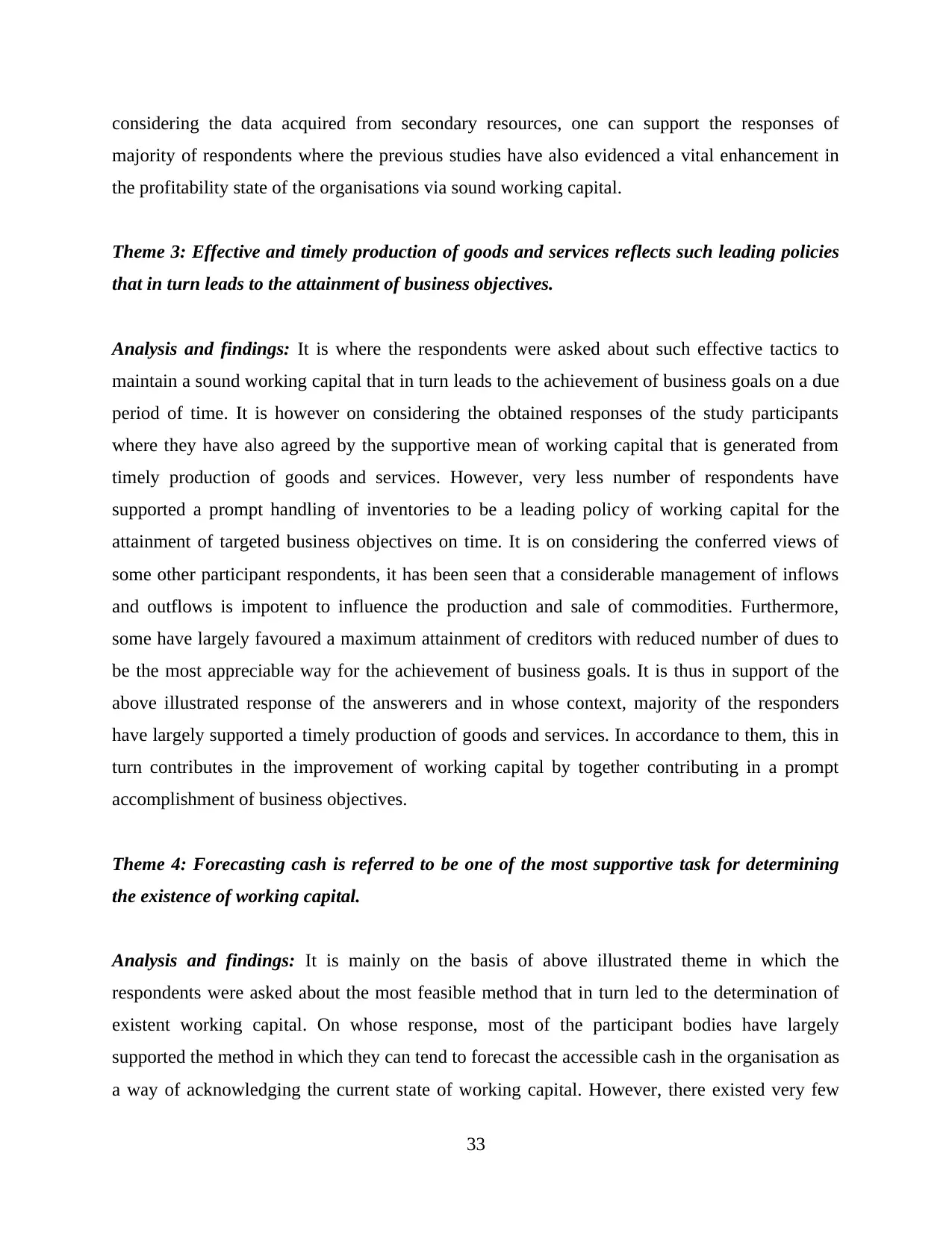
considering the data acquired from secondary resources, one can support the responses of
majority of respondents where the previous studies have also evidenced a vital enhancement in
the profitability state of the organisations via sound working capital.
Theme 3: Effective and timely production of goods and services reflects such leading policies
that in turn leads to the attainment of business objectives.
Analysis and findings: It is where the respondents were asked about such effective tactics to
maintain a sound working capital that in turn leads to the achievement of business goals on a due
period of time. It is however on considering the obtained responses of the study participants
where they have also agreed by the supportive mean of working capital that is generated from
timely production of goods and services. However, very less number of respondents have
supported a prompt handling of inventories to be a leading policy of working capital for the
attainment of targeted business objectives on time. It is on considering the conferred views of
some other participant respondents, it has been seen that a considerable management of inflows
and outflows is impotent to influence the production and sale of commodities. Furthermore,
some have largely favoured a maximum attainment of creditors with reduced number of dues to
be the most appreciable way for the achievement of business goals. It is thus in support of the
above illustrated response of the answerers and in whose context, majority of the responders
have largely supported a timely production of goods and services. In accordance to them, this in
turn contributes in the improvement of working capital by together contributing in a prompt
accomplishment of business objectives.
Theme 4: Forecasting cash is referred to be one of the most supportive task for determining
the existence of working capital.
Analysis and findings: It is mainly on the basis of above illustrated theme in which the
respondents were asked about the most feasible method that in turn led to the determination of
existent working capital. On whose response, most of the participant bodies have largely
supported the method in which they can tend to forecast the accessible cash in the organisation as
a way of acknowledging the current state of working capital. However, there existed very few
33
majority of respondents where the previous studies have also evidenced a vital enhancement in
the profitability state of the organisations via sound working capital.
Theme 3: Effective and timely production of goods and services reflects such leading policies
that in turn leads to the attainment of business objectives.
Analysis and findings: It is where the respondents were asked about such effective tactics to
maintain a sound working capital that in turn leads to the achievement of business goals on a due
period of time. It is however on considering the obtained responses of the study participants
where they have also agreed by the supportive mean of working capital that is generated from
timely production of goods and services. However, very less number of respondents have
supported a prompt handling of inventories to be a leading policy of working capital for the
attainment of targeted business objectives on time. It is on considering the conferred views of
some other participant respondents, it has been seen that a considerable management of inflows
and outflows is impotent to influence the production and sale of commodities. Furthermore,
some have largely favoured a maximum attainment of creditors with reduced number of dues to
be the most appreciable way for the achievement of business goals. It is thus in support of the
above illustrated response of the answerers and in whose context, majority of the responders
have largely supported a timely production of goods and services. In accordance to them, this in
turn contributes in the improvement of working capital by together contributing in a prompt
accomplishment of business objectives.
Theme 4: Forecasting cash is referred to be one of the most supportive task for determining
the existence of working capital.
Analysis and findings: It is mainly on the basis of above illustrated theme in which the
respondents were asked about the most feasible method that in turn led to the determination of
existent working capital. On whose response, most of the participant bodies have largely
supported the method in which they can tend to forecast the accessible cash in the organisation as
a way of acknowledging the current state of working capital. However, there existed very few
33
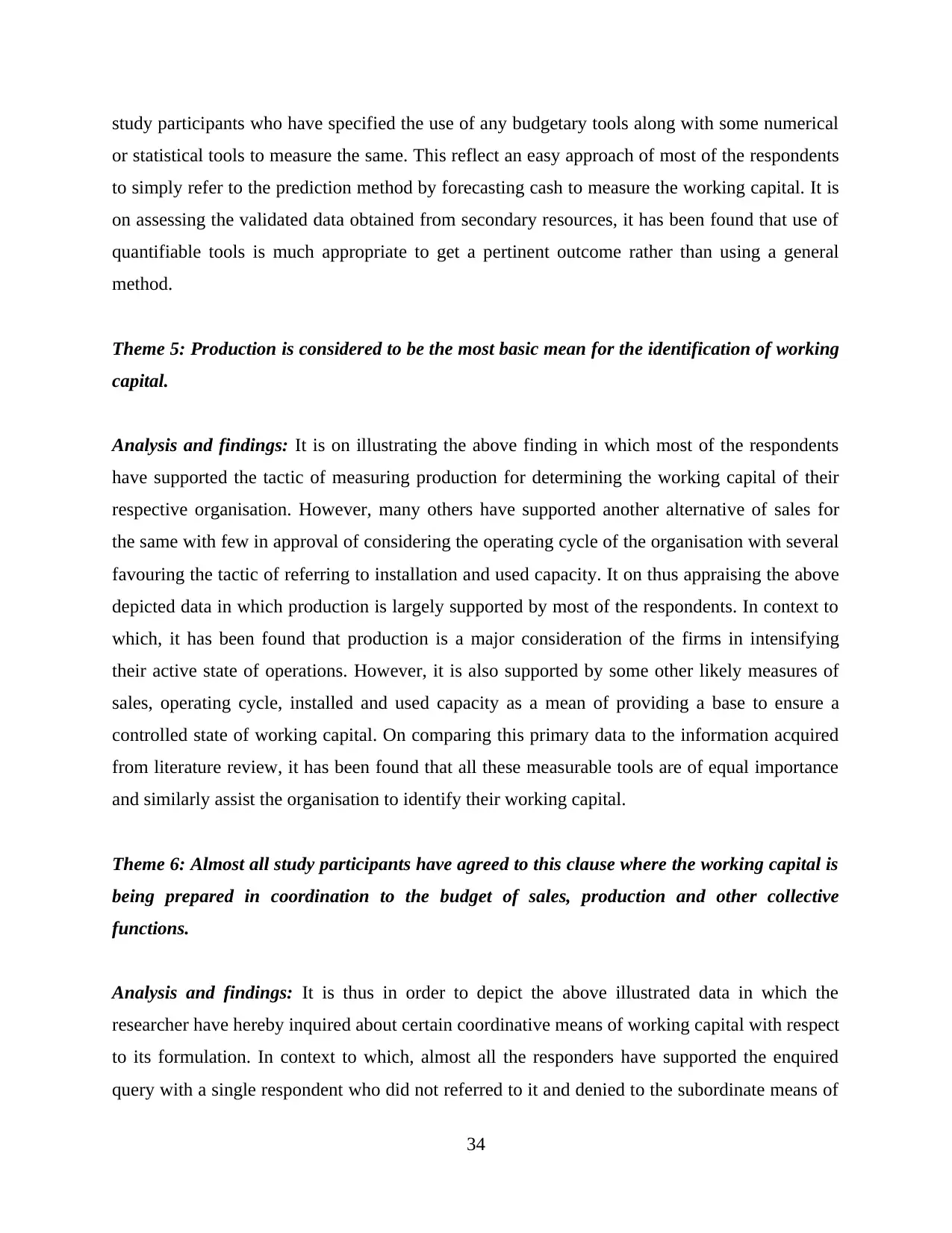
study participants who have specified the use of any budgetary tools along with some numerical
or statistical tools to measure the same. This reflect an easy approach of most of the respondents
to simply refer to the prediction method by forecasting cash to measure the working capital. It is
on assessing the validated data obtained from secondary resources, it has been found that use of
quantifiable tools is much appropriate to get a pertinent outcome rather than using a general
method.
Theme 5: Production is considered to be the most basic mean for the identification of working
capital.
Analysis and findings: It is on illustrating the above finding in which most of the respondents
have supported the tactic of measuring production for determining the working capital of their
respective organisation. However, many others have supported another alternative of sales for
the same with few in approval of considering the operating cycle of the organisation with several
favouring the tactic of referring to installation and used capacity. It on thus appraising the above
depicted data in which production is largely supported by most of the respondents. In context to
which, it has been found that production is a major consideration of the firms in intensifying
their active state of operations. However, it is also supported by some other likely measures of
sales, operating cycle, installed and used capacity as a mean of providing a base to ensure a
controlled state of working capital. On comparing this primary data to the information acquired
from literature review, it has been found that all these measurable tools are of equal importance
and similarly assist the organisation to identify their working capital.
Theme 6: Almost all study participants have agreed to this clause where the working capital is
being prepared in coordination to the budget of sales, production and other collective
functions.
Analysis and findings: It is thus in order to depict the above illustrated data in which the
researcher have hereby inquired about certain coordinative means of working capital with respect
to its formulation. In context to which, almost all the responders have supported the enquired
query with a single respondent who did not referred to it and denied to the subordinate means of
34
or statistical tools to measure the same. This reflect an easy approach of most of the respondents
to simply refer to the prediction method by forecasting cash to measure the working capital. It is
on assessing the validated data obtained from secondary resources, it has been found that use of
quantifiable tools is much appropriate to get a pertinent outcome rather than using a general
method.
Theme 5: Production is considered to be the most basic mean for the identification of working
capital.
Analysis and findings: It is on illustrating the above finding in which most of the respondents
have supported the tactic of measuring production for determining the working capital of their
respective organisation. However, many others have supported another alternative of sales for
the same with few in approval of considering the operating cycle of the organisation with several
favouring the tactic of referring to installation and used capacity. It on thus appraising the above
depicted data in which production is largely supported by most of the respondents. In context to
which, it has been found that production is a major consideration of the firms in intensifying
their active state of operations. However, it is also supported by some other likely measures of
sales, operating cycle, installed and used capacity as a mean of providing a base to ensure a
controlled state of working capital. On comparing this primary data to the information acquired
from literature review, it has been found that all these measurable tools are of equal importance
and similarly assist the organisation to identify their working capital.
Theme 6: Almost all study participants have agreed to this clause where the working capital is
being prepared in coordination to the budget of sales, production and other collective
functions.
Analysis and findings: It is thus in order to depict the above illustrated data in which the
researcher have hereby inquired about certain coordinative means of working capital with respect
to its formulation. In context to which, almost all the responders have supported the enquired
query with a single respondent who did not referred to it and denied to the subordinate means of
34
Secure Best Marks with AI Grader
Need help grading? Try our AI Grader for instant feedback on your assignments.
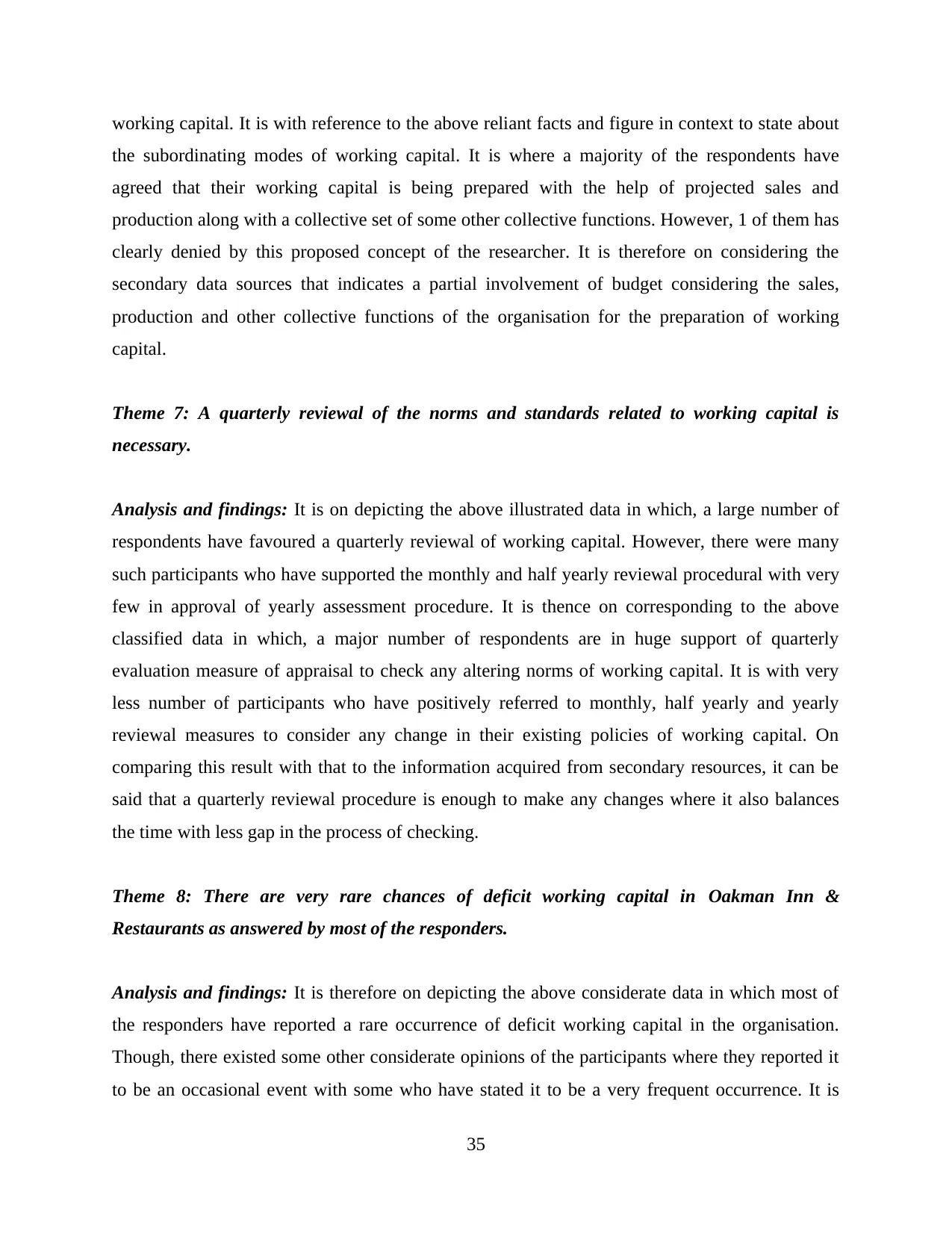
working capital. It is with reference to the above reliant facts and figure in context to state about
the subordinating modes of working capital. It is where a majority of the respondents have
agreed that their working capital is being prepared with the help of projected sales and
production along with a collective set of some other collective functions. However, 1 of them has
clearly denied by this proposed concept of the researcher. It is therefore on considering the
secondary data sources that indicates a partial involvement of budget considering the sales,
production and other collective functions of the organisation for the preparation of working
capital.
Theme 7: A quarterly reviewal of the norms and standards related to working capital is
necessary.
Analysis and findings: It is on depicting the above illustrated data in which, a large number of
respondents have favoured a quarterly reviewal of working capital. However, there were many
such participants who have supported the monthly and half yearly reviewal procedural with very
few in approval of yearly assessment procedure. It is thence on corresponding to the above
classified data in which, a major number of respondents are in huge support of quarterly
evaluation measure of appraisal to check any altering norms of working capital. It is with very
less number of participants who have positively referred to monthly, half yearly and yearly
reviewal measures to consider any change in their existing policies of working capital. On
comparing this result with that to the information acquired from secondary resources, it can be
said that a quarterly reviewal procedure is enough to make any changes where it also balances
the time with less gap in the process of checking.
Theme 8: There are very rare chances of deficit working capital in Oakman Inn &
Restaurants as answered by most of the responders.
Analysis and findings: It is therefore on depicting the above considerate data in which most of
the responders have reported a rare occurrence of deficit working capital in the organisation.
Though, there existed some other considerate opinions of the participants where they reported it
to be an occasional event with some who have stated it to be a very frequent occurrence. It is
35
the subordinating modes of working capital. It is where a majority of the respondents have
agreed that their working capital is being prepared with the help of projected sales and
production along with a collective set of some other collective functions. However, 1 of them has
clearly denied by this proposed concept of the researcher. It is therefore on considering the
secondary data sources that indicates a partial involvement of budget considering the sales,
production and other collective functions of the organisation for the preparation of working
capital.
Theme 7: A quarterly reviewal of the norms and standards related to working capital is
necessary.
Analysis and findings: It is on depicting the above illustrated data in which, a large number of
respondents have favoured a quarterly reviewal of working capital. However, there were many
such participants who have supported the monthly and half yearly reviewal procedural with very
few in approval of yearly assessment procedure. It is thence on corresponding to the above
classified data in which, a major number of respondents are in huge support of quarterly
evaluation measure of appraisal to check any altering norms of working capital. It is with very
less number of participants who have positively referred to monthly, half yearly and yearly
reviewal measures to consider any change in their existing policies of working capital. On
comparing this result with that to the information acquired from secondary resources, it can be
said that a quarterly reviewal procedure is enough to make any changes where it also balances
the time with less gap in the process of checking.
Theme 8: There are very rare chances of deficit working capital in Oakman Inn &
Restaurants as answered by most of the responders.
Analysis and findings: It is therefore on depicting the above considerate data in which most of
the responders have reported a rare occurrence of deficit working capital in the organisation.
Though, there existed some other considerate opinions of the participants where they reported it
to be an occasional event with some who have stated it to be a very frequent occurrence. It is
35

therefore on determining the above outlined clauses with majority in support of such similar
incident leading to inadequate working capital necessitated to consider the company reports of
Oakman Inn and restaurant with some evidential results about such depleting state.
However, it is together referred to be a pathetic situation for the establishment to balance
out such miserable state with less number of operational capital. On ascertaining the above
reported data, it has been found that a major number of respondents have mentioned about a rare
occurrence of inadequate functional capital at their workplace which was similar to the findings
acquired from the secondary resources. Whereas, such discrepancy in reporting is assumptive
due to a distinct level of consideration by each of the participant respondents where they all are
working at different levels and may not be aware of the existent situation.
Theme 9: Price fluctuations have been reported to be a leading reason behind the changing
state of working capital.
Analysis and findings: It is on depicting the above illustrated data in whose accordance, most of
the respondents have supported a foremost possibility of fluctuated pricing that in turn fluctuates
the active state of working capital in an organisation. However, their together existed some other
vital reasons reported by other participant bodies where some of them have specified that holding
payments from clients also negatively impacts upon the working capital. Wherein, some other
respondents are in support of decreased credit period for the purchase of raw materials to be a
leading reason behind it with very few in favour of an excessive credit assistance to the clients.
However, on considering the results gathered from secondary sources, one can clearly
differentiate among all possible answers given by the study participants and can envision a more
considerate role of price fluctuation behind the changing state of working capital. It is therefore
on the basis of above collected set of primary data in which price fluctuation has been addressed
to be a major reason behind an unstable state of working capital. In accordance to which, it can
be stated that such changing state of product price directly tends to affect the production rate of
the establishments by significantly raising their functional and other related costs. This in turn
leads to an ultimate non-stabilisation of company's working capital by simultaneously affecting
its entire functional roles and purposes.
36
incident leading to inadequate working capital necessitated to consider the company reports of
Oakman Inn and restaurant with some evidential results about such depleting state.
However, it is together referred to be a pathetic situation for the establishment to balance
out such miserable state with less number of operational capital. On ascertaining the above
reported data, it has been found that a major number of respondents have mentioned about a rare
occurrence of inadequate functional capital at their workplace which was similar to the findings
acquired from the secondary resources. Whereas, such discrepancy in reporting is assumptive
due to a distinct level of consideration by each of the participant respondents where they all are
working at different levels and may not be aware of the existent situation.
Theme 9: Price fluctuations have been reported to be a leading reason behind the changing
state of working capital.
Analysis and findings: It is on depicting the above illustrated data in whose accordance, most of
the respondents have supported a foremost possibility of fluctuated pricing that in turn fluctuates
the active state of working capital in an organisation. However, their together existed some other
vital reasons reported by other participant bodies where some of them have specified that holding
payments from clients also negatively impacts upon the working capital. Wherein, some other
respondents are in support of decreased credit period for the purchase of raw materials to be a
leading reason behind it with very few in favour of an excessive credit assistance to the clients.
However, on considering the results gathered from secondary sources, one can clearly
differentiate among all possible answers given by the study participants and can envision a more
considerate role of price fluctuation behind the changing state of working capital. It is therefore
on the basis of above collected set of primary data in which price fluctuation has been addressed
to be a major reason behind an unstable state of working capital. In accordance to which, it can
be stated that such changing state of product price directly tends to affect the production rate of
the establishments by significantly raising their functional and other related costs. This in turn
leads to an ultimate non-stabilisation of company's working capital by simultaneously affecting
its entire functional roles and purposes.
36
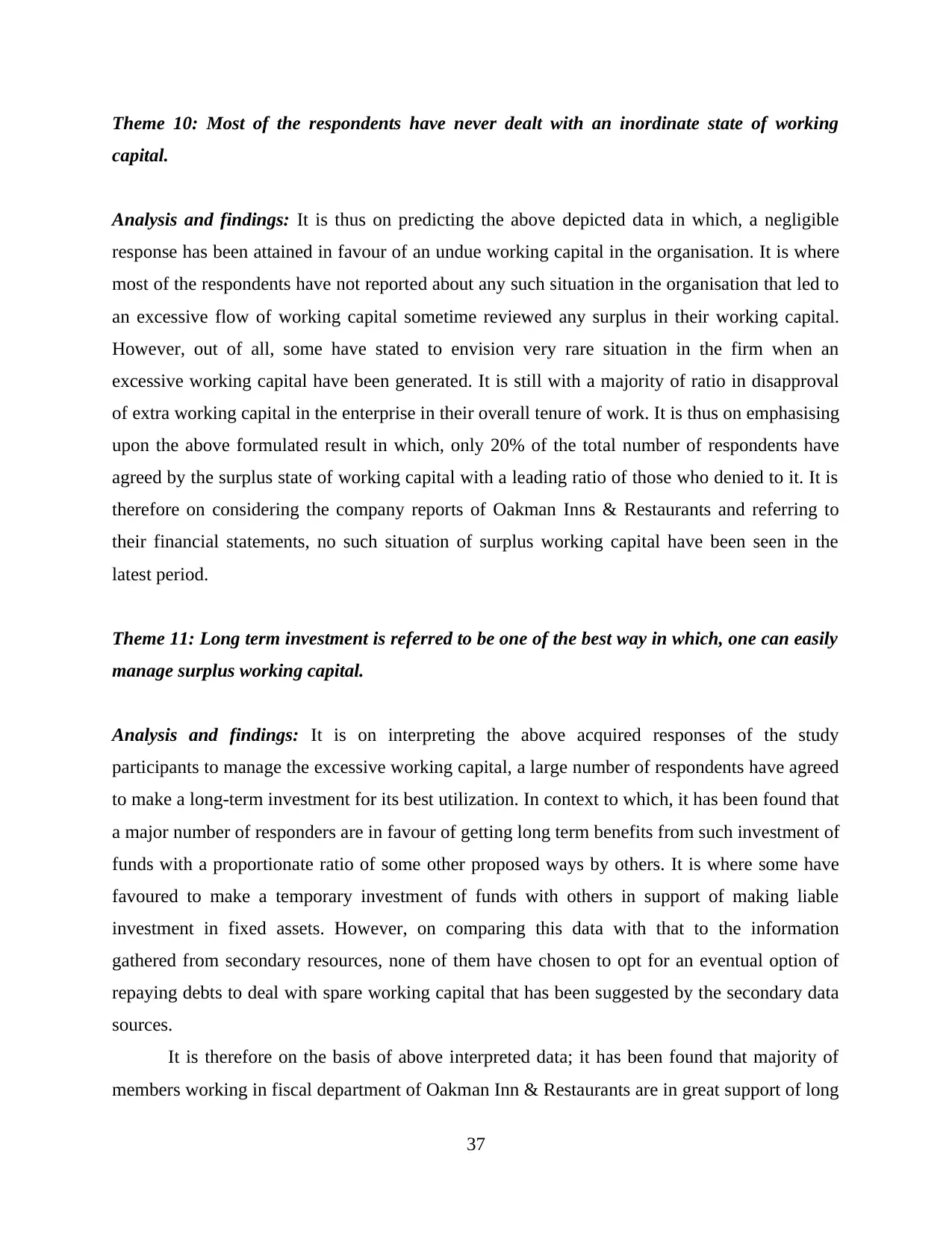
Theme 10: Most of the respondents have never dealt with an inordinate state of working
capital.
Analysis and findings: It is thus on predicting the above depicted data in which, a negligible
response has been attained in favour of an undue working capital in the organisation. It is where
most of the respondents have not reported about any such situation in the organisation that led to
an excessive flow of working capital sometime reviewed any surplus in their working capital.
However, out of all, some have stated to envision very rare situation in the firm when an
excessive working capital have been generated. It is still with a majority of ratio in disapproval
of extra working capital in the enterprise in their overall tenure of work. It is thus on emphasising
upon the above formulated result in which, only 20% of the total number of respondents have
agreed by the surplus state of working capital with a leading ratio of those who denied to it. It is
therefore on considering the company reports of Oakman Inns & Restaurants and referring to
their financial statements, no such situation of surplus working capital have been seen in the
latest period.
Theme 11: Long term investment is referred to be one of the best way in which, one can easily
manage surplus working capital.
Analysis and findings: It is on interpreting the above acquired responses of the study
participants to manage the excessive working capital, a large number of respondents have agreed
to make a long-term investment for its best utilization. In context to which, it has been found that
a major number of responders are in favour of getting long term benefits from such investment of
funds with a proportionate ratio of some other proposed ways by others. It is where some have
favoured to make a temporary investment of funds with others in support of making liable
investment in fixed assets. However, on comparing this data with that to the information
gathered from secondary resources, none of them have chosen to opt for an eventual option of
repaying debts to deal with spare working capital that has been suggested by the secondary data
sources.
It is therefore on the basis of above interpreted data; it has been found that majority of
members working in fiscal department of Oakman Inn & Restaurants are in great support of long
37
capital.
Analysis and findings: It is thus on predicting the above depicted data in which, a negligible
response has been attained in favour of an undue working capital in the organisation. It is where
most of the respondents have not reported about any such situation in the organisation that led to
an excessive flow of working capital sometime reviewed any surplus in their working capital.
However, out of all, some have stated to envision very rare situation in the firm when an
excessive working capital have been generated. It is still with a majority of ratio in disapproval
of extra working capital in the enterprise in their overall tenure of work. It is thus on emphasising
upon the above formulated result in which, only 20% of the total number of respondents have
agreed by the surplus state of working capital with a leading ratio of those who denied to it. It is
therefore on considering the company reports of Oakman Inns & Restaurants and referring to
their financial statements, no such situation of surplus working capital have been seen in the
latest period.
Theme 11: Long term investment is referred to be one of the best way in which, one can easily
manage surplus working capital.
Analysis and findings: It is on interpreting the above acquired responses of the study
participants to manage the excessive working capital, a large number of respondents have agreed
to make a long-term investment for its best utilization. In context to which, it has been found that
a major number of responders are in favour of getting long term benefits from such investment of
funds with a proportionate ratio of some other proposed ways by others. It is where some have
favoured to make a temporary investment of funds with others in support of making liable
investment in fixed assets. However, on comparing this data with that to the information
gathered from secondary resources, none of them have chosen to opt for an eventual option of
repaying debts to deal with spare working capital that has been suggested by the secondary data
sources.
It is therefore on the basis of above interpreted data; it has been found that majority of
members working in fiscal department of Oakman Inn & Restaurants are in great support of long
37
Paraphrase This Document
Need a fresh take? Get an instant paraphrase of this document with our AI Paraphraser

term investment to deal with an inordinate state of working capital. Furthermore, the remaining
have relatively corroborated the other two means of either investing in some temporary purposes
or to invest in fixed assets. Though, none of them have opted for an eventual status of repayment
of debts which is in accordance to the secondary data sources is one of the best possible measure
that in turn assist the firm to get rid of their debts to a great extent.
Theme 12: Inadequate financial information is the main challenge faced while dealing with
working capital management.
Analysis and findings: Collection of primary information has supported in knowing that
different challenges are faced while managing the working capital where most of the participant
bodies are in favour of inadequate financial information that in turn hinders into the process of
managing working capital. However, some other respondents have reported a deficit knowledge
to deter the management of working capital with very few who have favoured both these aspects.
However, to deal with such challenges it is necessary to build a proper plan and have a positive
impact on the overall performance of the company in every possible manner as per the
information obtained from secondary resources. Collection of primary information has supported
in knowing that different issues are faced by the respondents while the management of working
capital. Further, they replied that inadequate financial information is one of the main challenge as
Oakman Inns & Restaurants operates on smaller basis due to which proper financial data is not
present. Apart from this, lack of knowledge in the field of finance also acts as hurdle and due to
this reason working capital is not managed properly. Therefore, in this way, these two
challenges have to be faced while managing the working capital of the business to further
enhance its liquidity position.
Theme 13: Liquidity position of business can be enhanced by selling unproductive assets.
Analysis and findings: The primary data collected has supported in knowing different ways
through which a business can easily enhance its liquidity position. A majority of respondents
have replied that selling unproductive asset is one of the most effective ways, another has
favoured the management of working capital with some in support of trade credit. It is therefore
38
have relatively corroborated the other two means of either investing in some temporary purposes
or to invest in fixed assets. Though, none of them have opted for an eventual status of repayment
of debts which is in accordance to the secondary data sources is one of the best possible measure
that in turn assist the firm to get rid of their debts to a great extent.
Theme 12: Inadequate financial information is the main challenge faced while dealing with
working capital management.
Analysis and findings: Collection of primary information has supported in knowing that
different challenges are faced while managing the working capital where most of the participant
bodies are in favour of inadequate financial information that in turn hinders into the process of
managing working capital. However, some other respondents have reported a deficit knowledge
to deter the management of working capital with very few who have favoured both these aspects.
However, to deal with such challenges it is necessary to build a proper plan and have a positive
impact on the overall performance of the company in every possible manner as per the
information obtained from secondary resources. Collection of primary information has supported
in knowing that different issues are faced by the respondents while the management of working
capital. Further, they replied that inadequate financial information is one of the main challenge as
Oakman Inns & Restaurants operates on smaller basis due to which proper financial data is not
present. Apart from this, lack of knowledge in the field of finance also acts as hurdle and due to
this reason working capital is not managed properly. Therefore, in this way, these two
challenges have to be faced while managing the working capital of the business to further
enhance its liquidity position.
Theme 13: Liquidity position of business can be enhanced by selling unproductive assets.
Analysis and findings: The primary data collected has supported in knowing different ways
through which a business can easily enhance its liquidity position. A majority of respondents
have replied that selling unproductive asset is one of the most effective ways, another has
favoured the management of working capital with some in support of trade credit. It is therefore
38

on comparing the secondary sources of data generated from that to the primary investigation
done by conducting interviews have supported in knowing such effective ways through which
business can enhance its liquidity position. Further, majority of the participants have said that
selling unproductive assets is another method to improve the liquidity position where these funds
are present with the organization in liquidity form that leads to rise their performance level.
Management of working capital is also one of the effective way to boost liquidity position of a
business. Apart from this, trade credit is also referred to be yet another way of improving the
liquidity position of an organisation. Therefore, in this way, these are some of the effective ways
through which Oakman Inns & Restaurants has enough liquidity cash to efficiently carry out all
organisational operations by aiming at an overall enhancement of its business performance.
Theme 14: Effective management of working capital has led to the enhancement of company's
profitability level.
Analysis and findings: Primary information collected has supported in knowing that effective
management of working capital has allowed the business in enhancing its profitability level.
Further, almost all participant bodies are in favour of it. They replied that profit margin has
enhanced where organization can easily save adequate amount of cost. It is on comparing this
information to the data collected from secondary sources, it has been found that effective
management of working capital has boosted the profitability level of Oakman Inns &
Restaurants. Further, they are accessible to enough surplus cash which has been efficiently
employed for investment purpose. Due to this reason, Oakman Inns & Restaurants is able to
expand its operations in effective manner and the overall results obtained are also fruitful.
Moreover, working capital management has enhanced financial strength of the small business
where large number of opportunities prevailing in the market can be grabbed easily and as per
organizational need. Therefore, with the help of this it can be stated that managing working
capital is directly beneficial for business where profitability level can be enhanced easily.
Theme 15: Management of working capital supports in identifying major areas where costs
can be saved easily.
39
done by conducting interviews have supported in knowing such effective ways through which
business can enhance its liquidity position. Further, majority of the participants have said that
selling unproductive assets is another method to improve the liquidity position where these funds
are present with the organization in liquidity form that leads to rise their performance level.
Management of working capital is also one of the effective way to boost liquidity position of a
business. Apart from this, trade credit is also referred to be yet another way of improving the
liquidity position of an organisation. Therefore, in this way, these are some of the effective ways
through which Oakman Inns & Restaurants has enough liquidity cash to efficiently carry out all
organisational operations by aiming at an overall enhancement of its business performance.
Theme 14: Effective management of working capital has led to the enhancement of company's
profitability level.
Analysis and findings: Primary information collected has supported in knowing that effective
management of working capital has allowed the business in enhancing its profitability level.
Further, almost all participant bodies are in favour of it. They replied that profit margin has
enhanced where organization can easily save adequate amount of cost. It is on comparing this
information to the data collected from secondary sources, it has been found that effective
management of working capital has boosted the profitability level of Oakman Inns &
Restaurants. Further, they are accessible to enough surplus cash which has been efficiently
employed for investment purpose. Due to this reason, Oakman Inns & Restaurants is able to
expand its operations in effective manner and the overall results obtained are also fruitful.
Moreover, working capital management has enhanced financial strength of the small business
where large number of opportunities prevailing in the market can be grabbed easily and as per
organizational need. Therefore, with the help of this it can be stated that managing working
capital is directly beneficial for business where profitability level can be enhanced easily.
Theme 15: Management of working capital supports in identifying major areas where costs
can be saved easily.
39

Analysis and findings: Information collected has supported in knowing that Oakman Inns &
Restaurants is able to reduce large amount of costs through working capital management where
mostly the respondents have presented a strongly agreement to this fact. It is however with many
such participants who have given a less agreement towards it. Whereas, on considering the
information collected from secondary resources have specified that Oakman Inns & Restaurants
is positively affected with management of working capital where organization is able to save
major costs. Further, the reduction of cost has allowed in enhancing profitability level and in turn
desired goals of firm have been accomplished efficiently. Further, one of the main challenge
faced by company is management of cost but after undertaking the concept of working capital
management it has become possible for Oakman Inns & Restaurants to focus on its desired goals
and objectives. In short, it has brought favourable results for company in terms of rise in
profitability level and acted as development tool. Apart from this, it is one of the best ways to
reduce level of cost associated with the organization which enhances expenditure level.
Theme 16: Experts and professionals provide advice for the management of working capital.
Analysis and findings: Primary information collected has supported in knowing about the
sources from where financial managers of company take advice regarding working capital
management. In context to which, most of the managers have replied that a prompt advice is
being taken from experts and professionals with very few in support of referring books and
articles. However there together existed a participant who have stated to rely on past experience
for the administration of working capital in the organisation. Primary information obtained has
assisted in acknowledging the fact where most of the financial managers prefers to take advice in
relation with working capital management from experts and professionals. Further, it is well
known fact that experts associated with the field of finance have proper knowledge in relation
with working capital management. So, this is beneficial for the entire organization where
liquidity position can be enhanced so that entire company can be positively benefited through
this. Apart from this, other experts replied that books and articles provides them proper platform
in relation with working capital management. Moreover, past experience also plays major role in
managing working capital. Therefore, in this way working capital management takes place from
different sources present and supports positively entire organization.
40
Restaurants is able to reduce large amount of costs through working capital management where
mostly the respondents have presented a strongly agreement to this fact. It is however with many
such participants who have given a less agreement towards it. Whereas, on considering the
information collected from secondary resources have specified that Oakman Inns & Restaurants
is positively affected with management of working capital where organization is able to save
major costs. Further, the reduction of cost has allowed in enhancing profitability level and in turn
desired goals of firm have been accomplished efficiently. Further, one of the main challenge
faced by company is management of cost but after undertaking the concept of working capital
management it has become possible for Oakman Inns & Restaurants to focus on its desired goals
and objectives. In short, it has brought favourable results for company in terms of rise in
profitability level and acted as development tool. Apart from this, it is one of the best ways to
reduce level of cost associated with the organization which enhances expenditure level.
Theme 16: Experts and professionals provide advice for the management of working capital.
Analysis and findings: Primary information collected has supported in knowing about the
sources from where financial managers of company take advice regarding working capital
management. In context to which, most of the managers have replied that a prompt advice is
being taken from experts and professionals with very few in support of referring books and
articles. However there together existed a participant who have stated to rely on past experience
for the administration of working capital in the organisation. Primary information obtained has
assisted in acknowledging the fact where most of the financial managers prefers to take advice in
relation with working capital management from experts and professionals. Further, it is well
known fact that experts associated with the field of finance have proper knowledge in relation
with working capital management. So, this is beneficial for the entire organization where
liquidity position can be enhanced so that entire company can be positively benefited through
this. Apart from this, other experts replied that books and articles provides them proper platform
in relation with working capital management. Moreover, past experience also plays major role in
managing working capital. Therefore, in this way working capital management takes place from
different sources present and supports positively entire organization.
40
Secure Best Marks with AI Grader
Need help grading? Try our AI Grader for instant feedback on your assignments.
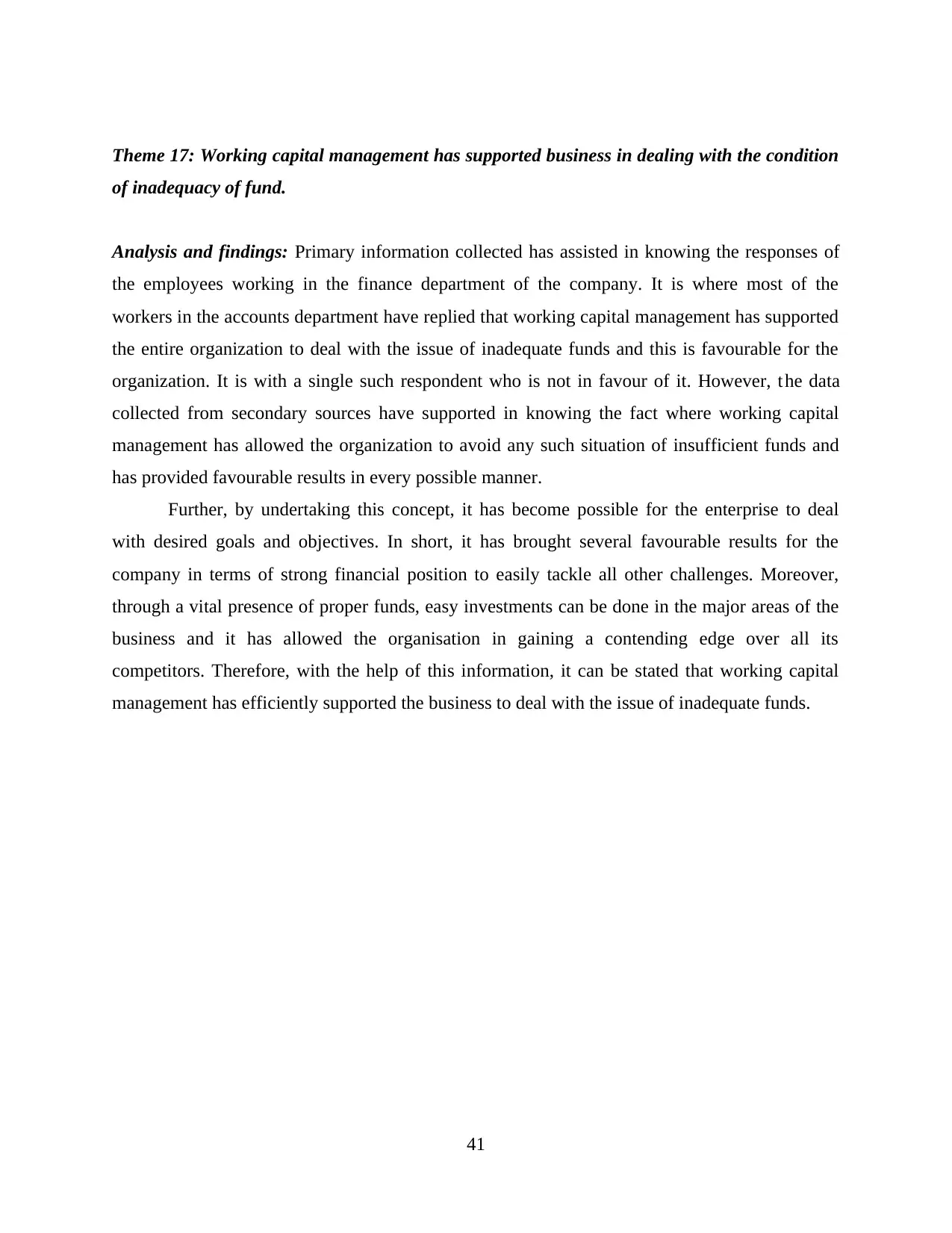
Theme 17: Working capital management has supported business in dealing with the condition
of inadequacy of fund.
Analysis and findings: Primary information collected has assisted in knowing the responses of
the employees working in the finance department of the company. It is where most of the
workers in the accounts department have replied that working capital management has supported
the entire organization to deal with the issue of inadequate funds and this is favourable for the
organization. It is with a single such respondent who is not in favour of it. However, t he data
collected from secondary sources have supported in knowing the fact where working capital
management has allowed the organization to avoid any such situation of insufficient funds and
has provided favourable results in every possible manner.
Further, by undertaking this concept, it has become possible for the enterprise to deal
with desired goals and objectives. In short, it has brought several favourable results for the
company in terms of strong financial position to easily tackle all other challenges. Moreover,
through a vital presence of proper funds, easy investments can be done in the major areas of the
business and it has allowed the organisation in gaining a contending edge over all its
competitors. Therefore, with the help of this information, it can be stated that working capital
management has efficiently supported the business to deal with the issue of inadequate funds.
41
of inadequacy of fund.
Analysis and findings: Primary information collected has assisted in knowing the responses of
the employees working in the finance department of the company. It is where most of the
workers in the accounts department have replied that working capital management has supported
the entire organization to deal with the issue of inadequate funds and this is favourable for the
organization. It is with a single such respondent who is not in favour of it. However, t he data
collected from secondary sources have supported in knowing the fact where working capital
management has allowed the organization to avoid any such situation of insufficient funds and
has provided favourable results in every possible manner.
Further, by undertaking this concept, it has become possible for the enterprise to deal
with desired goals and objectives. In short, it has brought several favourable results for the
company in terms of strong financial position to easily tackle all other challenges. Moreover,
through a vital presence of proper funds, easy investments can be done in the major areas of the
business and it has allowed the organisation in gaining a contending edge over all its
competitors. Therefore, with the help of this information, it can be stated that working capital
management has efficiently supported the business to deal with the issue of inadequate funds.
41

CHAPTER 5: DISCUSSION OF FINDINGS IN RELATION TO
LITERATURE
5.1 Introduction
The chapter of findings and discussion start after the completion of data analysis chapter.
Further it shed light on the findings of the study in which detail discussion is done in the line of
literature review. Furthermore, this chapter make sure the consistency of primary and secondary
in order to meet the aims and objectives in an effective manner.
5.2 Discussion of the findings in relation to literature review
According the data analysis chapter, it was found that effective and timely production of
goods and services reflects such leading policies that in turn leads to the attainment of business
objectives. It has been noticed that considerable management of inflows and outflows is impotent
to influence the production and sale of commodities. This finding is consistent with literature
review because many times internal policies along with the operations of companies are not
flexible and this lead to become a barrier in working capital management. Therefore, corrective
measure is need to be taken to check all the expenses of the business. This could involve
shortening the cycle of converting cash as an effective way to improve the profitability status of
the organisations as suggested by Garcia- Teruel and Martinez- Solano (2007) in their carried
study. On the other hand, research findings show that forecasting cash is known as one of the
most supportive task to determine the existence of working capital Further it is analysed that use
of quantifiable tool is effective in respect to get pertinent outcome instead of using simple
method.
In addition to this, the data collected from secondary research also reveal that inadequate
information regarding the sales prevent from managing the working capital. Along with this if
detailed information related to the inventory is not presented then it became difficult for the
organisation to survive as they face issues and situation related to inadequacy of finance
(Bellouma, 2011). While from the information collected from primary source it reflects that
inadequate financial information is one of the main challenge as Oakman Inns & Restaurants
operates on smaller basis due to which proper financial data is not present. Therefore, collected
primary and secondary are related to each other and both directed towards the same aspect.
42
LITERATURE
5.1 Introduction
The chapter of findings and discussion start after the completion of data analysis chapter.
Further it shed light on the findings of the study in which detail discussion is done in the line of
literature review. Furthermore, this chapter make sure the consistency of primary and secondary
in order to meet the aims and objectives in an effective manner.
5.2 Discussion of the findings in relation to literature review
According the data analysis chapter, it was found that effective and timely production of
goods and services reflects such leading policies that in turn leads to the attainment of business
objectives. It has been noticed that considerable management of inflows and outflows is impotent
to influence the production and sale of commodities. This finding is consistent with literature
review because many times internal policies along with the operations of companies are not
flexible and this lead to become a barrier in working capital management. Therefore, corrective
measure is need to be taken to check all the expenses of the business. This could involve
shortening the cycle of converting cash as an effective way to improve the profitability status of
the organisations as suggested by Garcia- Teruel and Martinez- Solano (2007) in their carried
study. On the other hand, research findings show that forecasting cash is known as one of the
most supportive task to determine the existence of working capital Further it is analysed that use
of quantifiable tool is effective in respect to get pertinent outcome instead of using simple
method.
In addition to this, the data collected from secondary research also reveal that inadequate
information regarding the sales prevent from managing the working capital. Along with this if
detailed information related to the inventory is not presented then it became difficult for the
organisation to survive as they face issues and situation related to inadequacy of finance
(Bellouma, 2011). While from the information collected from primary source it reflects that
inadequate financial information is one of the main challenge as Oakman Inns & Restaurants
operates on smaller basis due to which proper financial data is not present. Therefore, collected
primary and secondary are related to each other and both directed towards the same aspect.
42
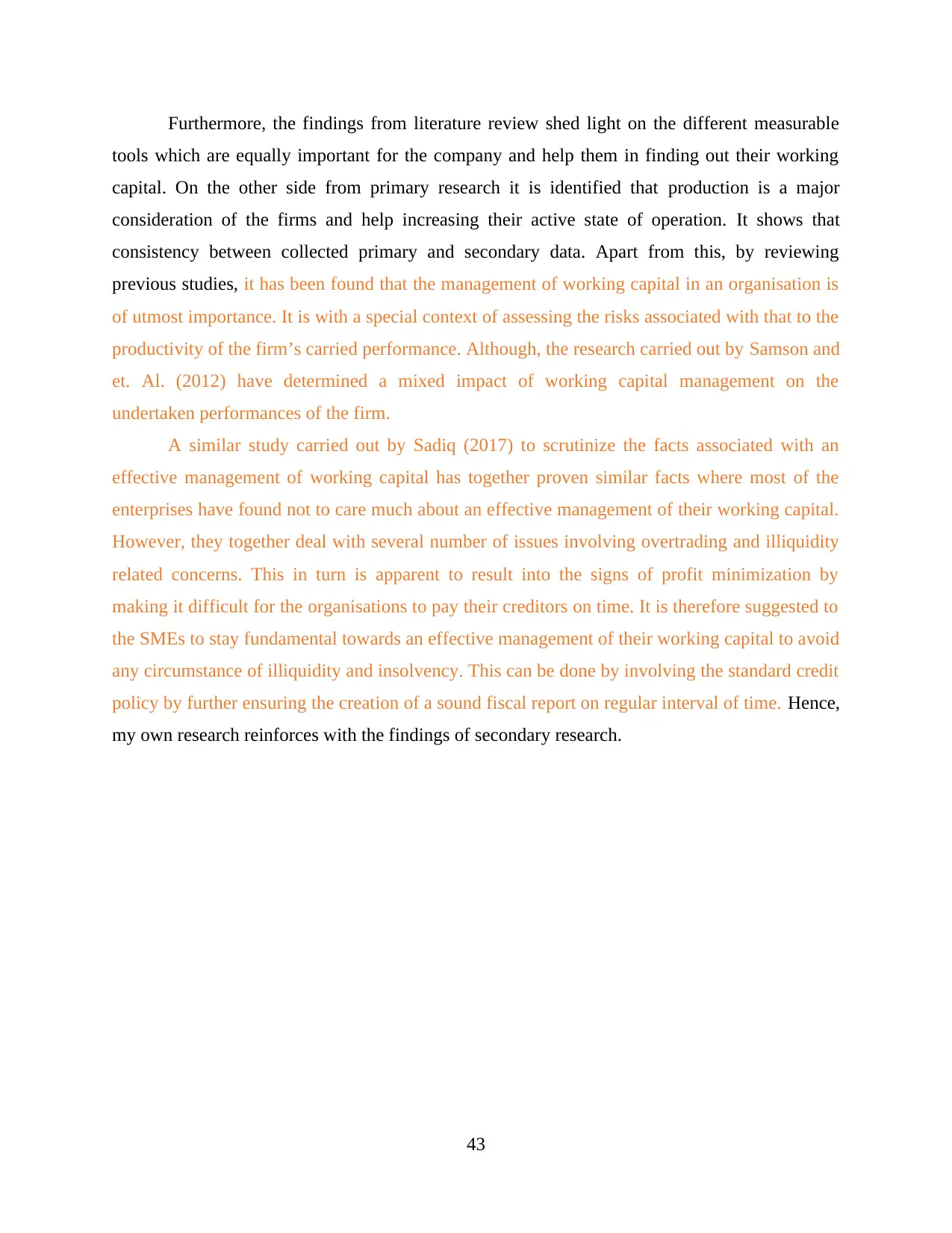
Furthermore, the findings from literature review shed light on the different measurable
tools which are equally important for the company and help them in finding out their working
capital. On the other side from primary research it is identified that production is a major
consideration of the firms and help increasing their active state of operation. It shows that
consistency between collected primary and secondary data. Apart from this, by reviewing
previous studies, it has been found that the management of working capital in an organisation is
of utmost importance. It is with a special context of assessing the risks associated with that to the
productivity of the firm’s carried performance. Although, the research carried out by Samson and
et. Al. (2012) have determined a mixed impact of working capital management on the
undertaken performances of the firm.
A similar study carried out by Sadiq (2017) to scrutinize the facts associated with an
effective management of working capital has together proven similar facts where most of the
enterprises have found not to care much about an effective management of their working capital.
However, they together deal with several number of issues involving overtrading and illiquidity
related concerns. This in turn is apparent to result into the signs of profit minimization by
making it difficult for the organisations to pay their creditors on time. It is therefore suggested to
the SMEs to stay fundamental towards an effective management of their working capital to avoid
any circumstance of illiquidity and insolvency. This can be done by involving the standard credit
policy by further ensuring the creation of a sound fiscal report on regular interval of time. Hence,
my own research reinforces with the findings of secondary research.
43
tools which are equally important for the company and help them in finding out their working
capital. On the other side from primary research it is identified that production is a major
consideration of the firms and help increasing their active state of operation. It shows that
consistency between collected primary and secondary data. Apart from this, by reviewing
previous studies, it has been found that the management of working capital in an organisation is
of utmost importance. It is with a special context of assessing the risks associated with that to the
productivity of the firm’s carried performance. Although, the research carried out by Samson and
et. Al. (2012) have determined a mixed impact of working capital management on the
undertaken performances of the firm.
A similar study carried out by Sadiq (2017) to scrutinize the facts associated with an
effective management of working capital has together proven similar facts where most of the
enterprises have found not to care much about an effective management of their working capital.
However, they together deal with several number of issues involving overtrading and illiquidity
related concerns. This in turn is apparent to result into the signs of profit minimization by
making it difficult for the organisations to pay their creditors on time. It is therefore suggested to
the SMEs to stay fundamental towards an effective management of their working capital to avoid
any circumstance of illiquidity and insolvency. This can be done by involving the standard credit
policy by further ensuring the creation of a sound fiscal report on regular interval of time. Hence,
my own research reinforces with the findings of secondary research.
43
Paraphrase This Document
Need a fresh take? Get an instant paraphrase of this document with our AI Paraphraser
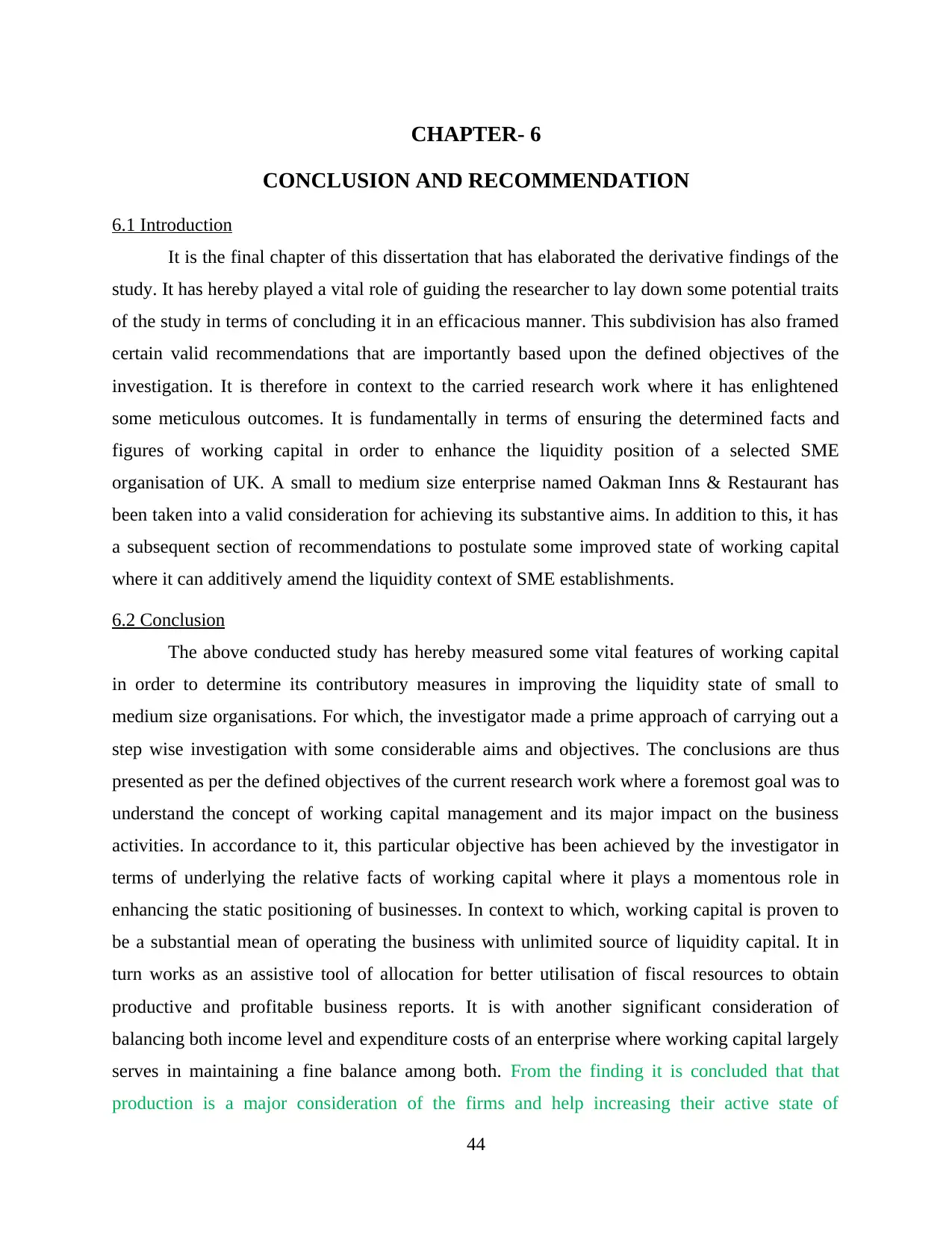
CHAPTER- 6
CONCLUSION AND RECOMMENDATION
6.1 Introduction
It is the final chapter of this dissertation that has elaborated the derivative findings of the
study. It has hereby played a vital role of guiding the researcher to lay down some potential traits
of the study in terms of concluding it in an efficacious manner. This subdivision has also framed
certain valid recommendations that are importantly based upon the defined objectives of the
investigation. It is therefore in context to the carried research work where it has enlightened
some meticulous outcomes. It is fundamentally in terms of ensuring the determined facts and
figures of working capital in order to enhance the liquidity position of a selected SME
organisation of UK. A small to medium size enterprise named Oakman Inns & Restaurant has
been taken into a valid consideration for achieving its substantive aims. In addition to this, it has
a subsequent section of recommendations to postulate some improved state of working capital
where it can additively amend the liquidity context of SME establishments.
6.2 Conclusion
The above conducted study has hereby measured some vital features of working capital
in order to determine its contributory measures in improving the liquidity state of small to
medium size organisations. For which, the investigator made a prime approach of carrying out a
step wise investigation with some considerable aims and objectives. The conclusions are thus
presented as per the defined objectives of the current research work where a foremost goal was to
understand the concept of working capital management and its major impact on the business
activities. In accordance to it, this particular objective has been achieved by the investigator in
terms of underlying the relative facts of working capital where it plays a momentous role in
enhancing the static positioning of businesses. In context to which, working capital is proven to
be a substantial mean of operating the business with unlimited source of liquidity capital. It in
turn works as an assistive tool of allocation for better utilisation of fiscal resources to obtain
productive and profitable business reports. It is with another significant consideration of
balancing both income level and expenditure costs of an enterprise where working capital largely
serves in maintaining a fine balance among both. From the finding it is concluded that that
production is a major consideration of the firms and help increasing their active state of
44
CONCLUSION AND RECOMMENDATION
6.1 Introduction
It is the final chapter of this dissertation that has elaborated the derivative findings of the
study. It has hereby played a vital role of guiding the researcher to lay down some potential traits
of the study in terms of concluding it in an efficacious manner. This subdivision has also framed
certain valid recommendations that are importantly based upon the defined objectives of the
investigation. It is therefore in context to the carried research work where it has enlightened
some meticulous outcomes. It is fundamentally in terms of ensuring the determined facts and
figures of working capital in order to enhance the liquidity position of a selected SME
organisation of UK. A small to medium size enterprise named Oakman Inns & Restaurant has
been taken into a valid consideration for achieving its substantive aims. In addition to this, it has
a subsequent section of recommendations to postulate some improved state of working capital
where it can additively amend the liquidity context of SME establishments.
6.2 Conclusion
The above conducted study has hereby measured some vital features of working capital
in order to determine its contributory measures in improving the liquidity state of small to
medium size organisations. For which, the investigator made a prime approach of carrying out a
step wise investigation with some considerable aims and objectives. The conclusions are thus
presented as per the defined objectives of the current research work where a foremost goal was to
understand the concept of working capital management and its major impact on the business
activities. In accordance to it, this particular objective has been achieved by the investigator in
terms of underlying the relative facts of working capital where it plays a momentous role in
enhancing the static positioning of businesses. In context to which, working capital is proven to
be a substantial mean of operating the business with unlimited source of liquidity capital. It in
turn works as an assistive tool of allocation for better utilisation of fiscal resources to obtain
productive and profitable business reports. It is with another significant consideration of
balancing both income level and expenditure costs of an enterprise where working capital largely
serves in maintaining a fine balance among both. From the finding it is concluded that that
production is a major consideration of the firms and help increasing their active state of
44
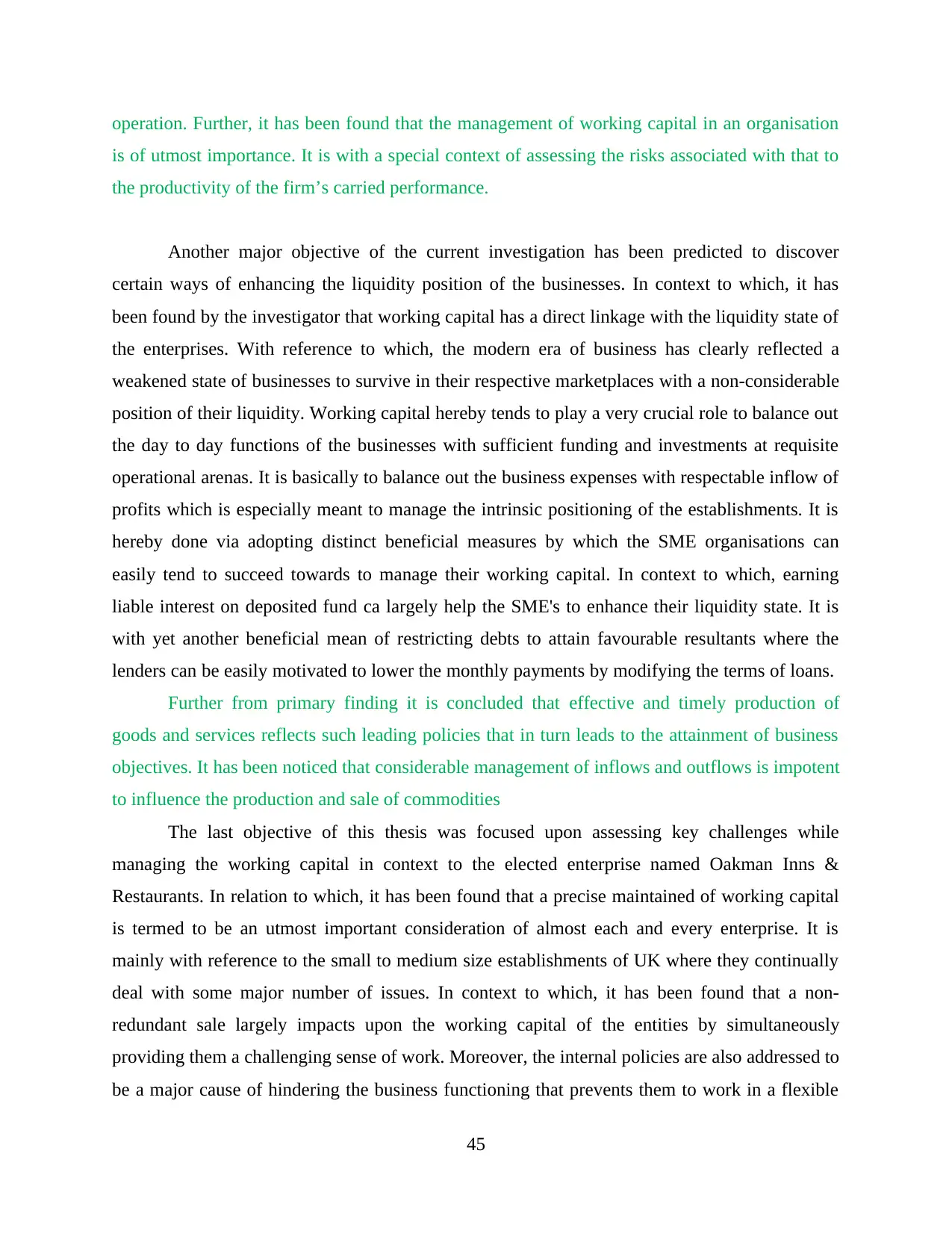
operation. Further, it has been found that the management of working capital in an organisation
is of utmost importance. It is with a special context of assessing the risks associated with that to
the productivity of the firm’s carried performance.
Another major objective of the current investigation has been predicted to discover
certain ways of enhancing the liquidity position of the businesses. In context to which, it has
been found by the investigator that working capital has a direct linkage with the liquidity state of
the enterprises. With reference to which, the modern era of business has clearly reflected a
weakened state of businesses to survive in their respective marketplaces with a non-considerable
position of their liquidity. Working capital hereby tends to play a very crucial role to balance out
the day to day functions of the businesses with sufficient funding and investments at requisite
operational arenas. It is basically to balance out the business expenses with respectable inflow of
profits which is especially meant to manage the intrinsic positioning of the establishments. It is
hereby done via adopting distinct beneficial measures by which the SME organisations can
easily tend to succeed towards to manage their working capital. In context to which, earning
liable interest on deposited fund ca largely help the SME's to enhance their liquidity state. It is
with yet another beneficial mean of restricting debts to attain favourable resultants where the
lenders can be easily motivated to lower the monthly payments by modifying the terms of loans.
Further from primary finding it is concluded that effective and timely production of
goods and services reflects such leading policies that in turn leads to the attainment of business
objectives. It has been noticed that considerable management of inflows and outflows is impotent
to influence the production and sale of commodities
The last objective of this thesis was focused upon assessing key challenges while
managing the working capital in context to the elected enterprise named Oakman Inns &
Restaurants. In relation to which, it has been found that a precise maintained of working capital
is termed to be an utmost important consideration of almost each and every enterprise. It is
mainly with reference to the small to medium size establishments of UK where they continually
deal with some major number of issues. In context to which, it has been found that a non-
redundant sale largely impacts upon the working capital of the entities by simultaneously
providing them a challenging sense of work. Moreover, the internal policies are also addressed to
be a major cause of hindering the business functioning that prevents them to work in a flexible
45
is of utmost importance. It is with a special context of assessing the risks associated with that to
the productivity of the firm’s carried performance.
Another major objective of the current investigation has been predicted to discover
certain ways of enhancing the liquidity position of the businesses. In context to which, it has
been found by the investigator that working capital has a direct linkage with the liquidity state of
the enterprises. With reference to which, the modern era of business has clearly reflected a
weakened state of businesses to survive in their respective marketplaces with a non-considerable
position of their liquidity. Working capital hereby tends to play a very crucial role to balance out
the day to day functions of the businesses with sufficient funding and investments at requisite
operational arenas. It is basically to balance out the business expenses with respectable inflow of
profits which is especially meant to manage the intrinsic positioning of the establishments. It is
hereby done via adopting distinct beneficial measures by which the SME organisations can
easily tend to succeed towards to manage their working capital. In context to which, earning
liable interest on deposited fund ca largely help the SME's to enhance their liquidity state. It is
with yet another beneficial mean of restricting debts to attain favourable resultants where the
lenders can be easily motivated to lower the monthly payments by modifying the terms of loans.
Further from primary finding it is concluded that effective and timely production of
goods and services reflects such leading policies that in turn leads to the attainment of business
objectives. It has been noticed that considerable management of inflows and outflows is impotent
to influence the production and sale of commodities
The last objective of this thesis was focused upon assessing key challenges while
managing the working capital in context to the elected enterprise named Oakman Inns &
Restaurants. In relation to which, it has been found that a precise maintained of working capital
is termed to be an utmost important consideration of almost each and every enterprise. It is
mainly with reference to the small to medium size establishments of UK where they continually
deal with some major number of issues. In context to which, it has been found that a non-
redundant sale largely impacts upon the working capital of the entities by simultaneously
providing them a challenging sense of work. Moreover, the internal policies are also addressed to
be a major cause of hindering the business functioning that prevents them to work in a flexible
45
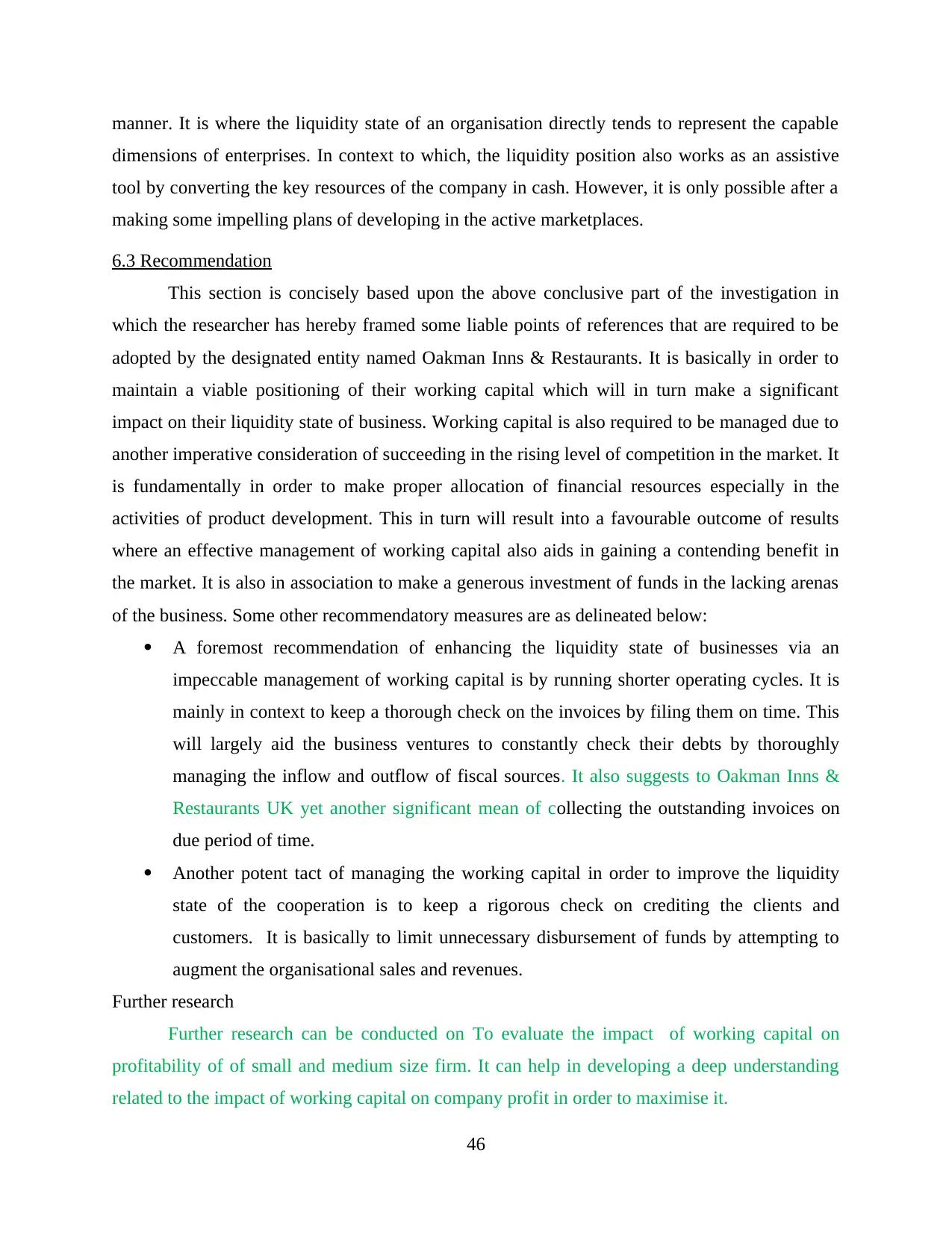
manner. It is where the liquidity state of an organisation directly tends to represent the capable
dimensions of enterprises. In context to which, the liquidity position also works as an assistive
tool by converting the key resources of the company in cash. However, it is only possible after a
making some impelling plans of developing in the active marketplaces.
6.3 Recommendation
This section is concisely based upon the above conclusive part of the investigation in
which the researcher has hereby framed some liable points of references that are required to be
adopted by the designated entity named Oakman Inns & Restaurants. It is basically in order to
maintain a viable positioning of their working capital which will in turn make a significant
impact on their liquidity state of business. Working capital is also required to be managed due to
another imperative consideration of succeeding in the rising level of competition in the market. It
is fundamentally in order to make proper allocation of financial resources especially in the
activities of product development. This in turn will result into a favourable outcome of results
where an effective management of working capital also aids in gaining a contending benefit in
the market. It is also in association to make a generous investment of funds in the lacking arenas
of the business. Some other recommendatory measures are as delineated below:
A foremost recommendation of enhancing the liquidity state of businesses via an
impeccable management of working capital is by running shorter operating cycles. It is
mainly in context to keep a thorough check on the invoices by filing them on time. This
will largely aid the business ventures to constantly check their debts by thoroughly
managing the inflow and outflow of fiscal sources. It also suggests to Oakman Inns &
Restaurants UK yet another significant mean of collecting the outstanding invoices on
due period of time.
Another potent tact of managing the working capital in order to improve the liquidity
state of the cooperation is to keep a rigorous check on crediting the clients and
customers. It is basically to limit unnecessary disbursement of funds by attempting to
augment the organisational sales and revenues.
Further research
Further research can be conducted on To evaluate the impact of working capital on
profitability of of small and medium size firm. It can help in developing a deep understanding
related to the impact of working capital on company profit in order to maximise it.
46
dimensions of enterprises. In context to which, the liquidity position also works as an assistive
tool by converting the key resources of the company in cash. However, it is only possible after a
making some impelling plans of developing in the active marketplaces.
6.3 Recommendation
This section is concisely based upon the above conclusive part of the investigation in
which the researcher has hereby framed some liable points of references that are required to be
adopted by the designated entity named Oakman Inns & Restaurants. It is basically in order to
maintain a viable positioning of their working capital which will in turn make a significant
impact on their liquidity state of business. Working capital is also required to be managed due to
another imperative consideration of succeeding in the rising level of competition in the market. It
is fundamentally in order to make proper allocation of financial resources especially in the
activities of product development. This in turn will result into a favourable outcome of results
where an effective management of working capital also aids in gaining a contending benefit in
the market. It is also in association to make a generous investment of funds in the lacking arenas
of the business. Some other recommendatory measures are as delineated below:
A foremost recommendation of enhancing the liquidity state of businesses via an
impeccable management of working capital is by running shorter operating cycles. It is
mainly in context to keep a thorough check on the invoices by filing them on time. This
will largely aid the business ventures to constantly check their debts by thoroughly
managing the inflow and outflow of fiscal sources. It also suggests to Oakman Inns &
Restaurants UK yet another significant mean of collecting the outstanding invoices on
due period of time.
Another potent tact of managing the working capital in order to improve the liquidity
state of the cooperation is to keep a rigorous check on crediting the clients and
customers. It is basically to limit unnecessary disbursement of funds by attempting to
augment the organisational sales and revenues.
Further research
Further research can be conducted on To evaluate the impact of working capital on
profitability of of small and medium size firm. It can help in developing a deep understanding
related to the impact of working capital on company profit in order to maximise it.
46
Secure Best Marks with AI Grader
Need help grading? Try our AI Grader for instant feedback on your assignments.
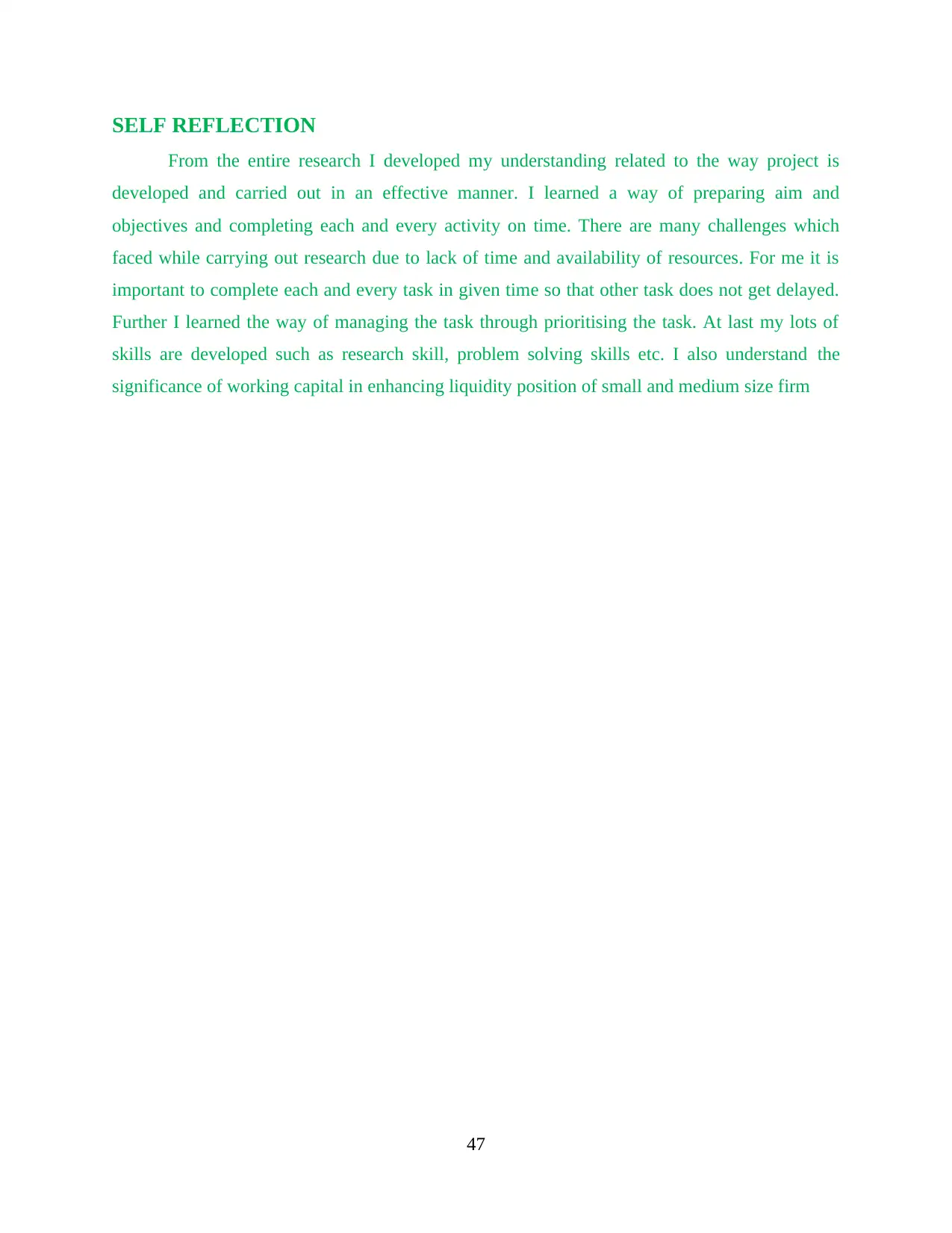
SELF REFLECTION
From the entire research I developed my understanding related to the way project is
developed and carried out in an effective manner. I learned a way of preparing aim and
objectives and completing each and every activity on time. There are many challenges which
faced while carrying out research due to lack of time and availability of resources. For me it is
important to complete each and every task in given time so that other task does not get delayed.
Further I learned the way of managing the task through prioritising the task. At last my lots of
skills are developed such as research skill, problem solving skills etc. I also understand the
significance of working capital in enhancing liquidity position of small and medium size firm
47
From the entire research I developed my understanding related to the way project is
developed and carried out in an effective manner. I learned a way of preparing aim and
objectives and completing each and every activity on time. There are many challenges which
faced while carrying out research due to lack of time and availability of resources. For me it is
important to complete each and every task in given time so that other task does not get delayed.
Further I learned the way of managing the task through prioritising the task. At last my lots of
skills are developed such as research skill, problem solving skills etc. I also understand the
significance of working capital in enhancing liquidity position of small and medium size firm
47
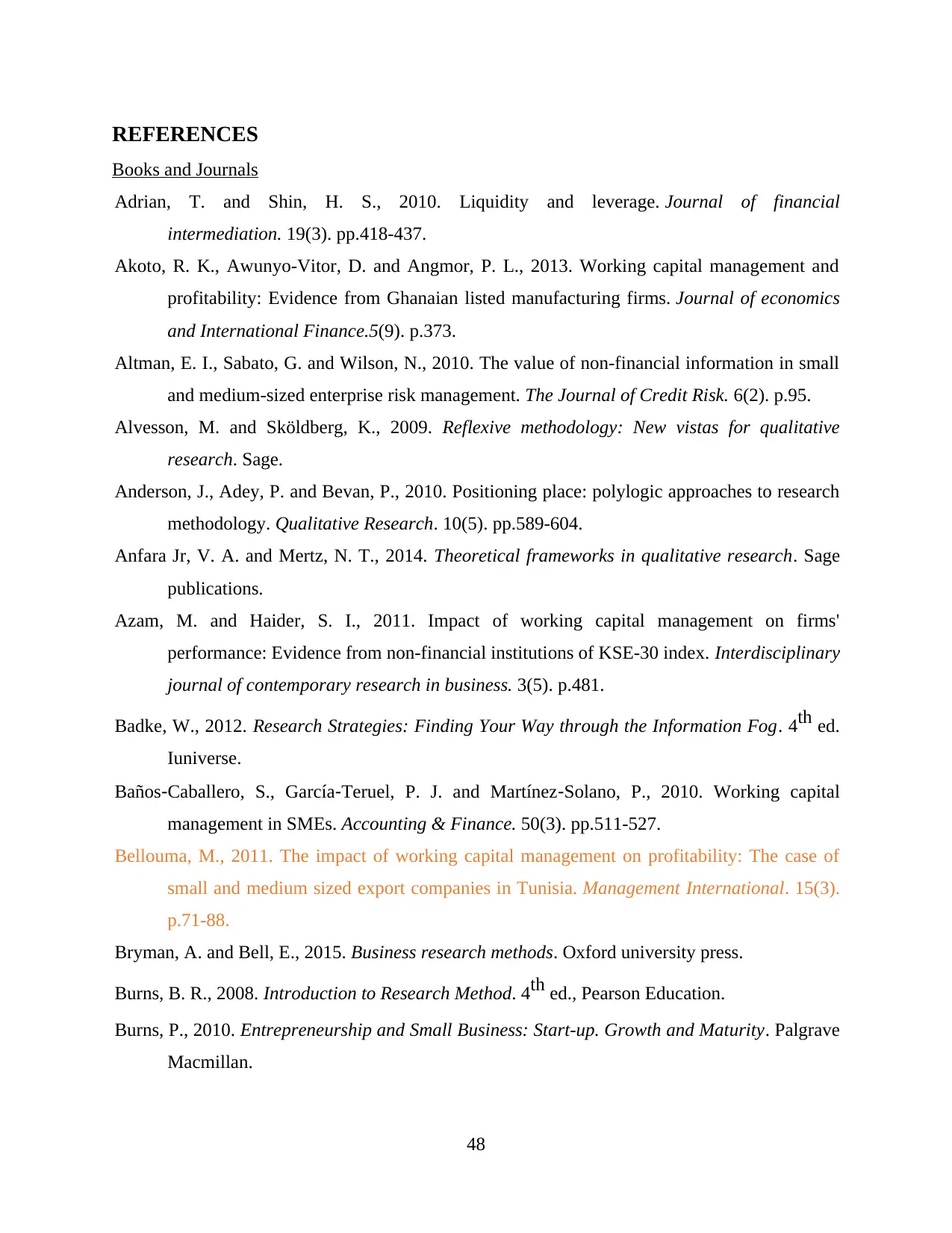
REFERENCES
Books and Journals
Adrian, T. and Shin, H. S., 2010. Liquidity and leverage. Journal of financial
intermediation. 19(3). pp.418-437.
Akoto, R. K., Awunyo-Vitor, D. and Angmor, P. L., 2013. Working capital management and
profitability: Evidence from Ghanaian listed manufacturing firms. Journal of economics
and International Finance.5(9). p.373.
Altman, E. I., Sabato, G. and Wilson, N., 2010. The value of non-financial information in small
and medium-sized enterprise risk management. The Journal of Credit Risk. 6(2). p.95.
Alvesson, M. and Sköldberg, K., 2009. Reflexive methodology: New vistas for qualitative
research. Sage.
Anderson, J., Adey, P. and Bevan, P., 2010. Positioning place: polylogic approaches to research
methodology. Qualitative Research. 10(5). pp.589-604.
Anfara Jr, V. A. and Mertz, N. T., 2014. Theoretical frameworks in qualitative research. Sage
publications.
Azam, M. and Haider, S. I., 2011. Impact of working capital management on firms'
performance: Evidence from non-financial institutions of KSE-30 index. Interdisciplinary
journal of contemporary research in business. 3(5). p.481.
Badke, W., 2012. Research Strategies: Finding Your Way through the Information Fog. 4th ed.
Iuniverse.
Baños‐Caballero, S., García‐Teruel, P. J. and Martínez‐Solano, P., 2010. Working capital
management in SMEs. Accounting & Finance. 50(3). pp.511-527.
Bellouma, M., 2011. The impact of working capital management on profitability: The case of
small and medium sized export companies in Tunisia. Management International. 15(3).
p.71-88.
Bryman, A. and Bell, E., 2015. Business research methods. Oxford university press.
Burns, B. R., 2008. Introduction to Research Method. 4th ed., Pearson Education.
Burns, P., 2010. Entrepreneurship and Small Business: Start-up. Growth and Maturity. Palgrave
Macmillan.
48
Books and Journals
Adrian, T. and Shin, H. S., 2010. Liquidity and leverage. Journal of financial
intermediation. 19(3). pp.418-437.
Akoto, R. K., Awunyo-Vitor, D. and Angmor, P. L., 2013. Working capital management and
profitability: Evidence from Ghanaian listed manufacturing firms. Journal of economics
and International Finance.5(9). p.373.
Altman, E. I., Sabato, G. and Wilson, N., 2010. The value of non-financial information in small
and medium-sized enterprise risk management. The Journal of Credit Risk. 6(2). p.95.
Alvesson, M. and Sköldberg, K., 2009. Reflexive methodology: New vistas for qualitative
research. Sage.
Anderson, J., Adey, P. and Bevan, P., 2010. Positioning place: polylogic approaches to research
methodology. Qualitative Research. 10(5). pp.589-604.
Anfara Jr, V. A. and Mertz, N. T., 2014. Theoretical frameworks in qualitative research. Sage
publications.
Azam, M. and Haider, S. I., 2011. Impact of working capital management on firms'
performance: Evidence from non-financial institutions of KSE-30 index. Interdisciplinary
journal of contemporary research in business. 3(5). p.481.
Badke, W., 2012. Research Strategies: Finding Your Way through the Information Fog. 4th ed.
Iuniverse.
Baños‐Caballero, S., García‐Teruel, P. J. and Martínez‐Solano, P., 2010. Working capital
management in SMEs. Accounting & Finance. 50(3). pp.511-527.
Bellouma, M., 2011. The impact of working capital management on profitability: The case of
small and medium sized export companies in Tunisia. Management International. 15(3).
p.71-88.
Bryman, A. and Bell, E., 2015. Business research methods. Oxford university press.
Burns, B. R., 2008. Introduction to Research Method. 4th ed., Pearson Education.
Burns, P., 2010. Entrepreneurship and Small Business: Start-up. Growth and Maturity. Palgrave
Macmillan.
48

Charitou, M. S., Elfani, M. and Lois, P., 2010. The Effect Of Working Capital Management On
Firms Profitability: Empirical Evidence From An Emerging Market. Journal of Business
& Economics Research (JBER).8(12).
Cooper, D. R. and et. al., 2006. Business research methods. Sage.
Corelli, A., 2016. Analytical Corporate Finance. Springer International Publishing.
Czarnitzki, D. and Hottenrott, H., 2011. R&D investment and financing constraints of small and
medium-sized firms. Small Business Economics. 36(1). pp.65-83.
Dane, F. C., 2010. Evaluating research: Methodology for people who need to read research.
Sage.
De Visscher, F. M., Mendoza, D. S. and Ward, J. L., 2011. Financing transitions: Managing
capital and liquidity in the family business. Macmillan.
Dong, H. and Su, J. T., 2010. The relationship between working capital management and
profitability: a Vietnam case.
Ebben, J. J. and Johnson, A. C., 2011. Cash conversion cycle management in small firms:
Relationships with liquidity, invested capital, and firm performance. Journal of Small
Business & Entrepreneurship. 24(3). pp.381-396.
Ekanem, I., 2010. Liquidity management in small firms: a learning perspective. Journal of Small
Business and Enterprise Development. 17(1). pp.123-138.
Flick, U., 2015. Introducing research methodology: A beginner's guide to doing a research
project. Sage.
Friese, S., 2012. ‘Qualitative Data Analysis with ATLAS’. SAGE.
Garcia- Teruel, P. J. and Martinez- Solano, P., 2007. Effects of Working Capital Management on
SME Profitability. International Journal of Managerial Finance. 3(2). 164-177.
Garner, R. and Scott, G. M., 2013. Doing qualitative research: designs, methods, and
techniques. Pearson Education.
Gast, D.L. and Ledford, J.R., 2014. Single case research methodology: Applications in special
education and behavioral sciences. Routledge.
Gill, A., Biger, N. and Mathur, N., 2010. The relationship between working capital management
and profitability: Evidence from the United States.Business and Economics
Journal.10(1). pp.1-9.
49
Firms Profitability: Empirical Evidence From An Emerging Market. Journal of Business
& Economics Research (JBER).8(12).
Cooper, D. R. and et. al., 2006. Business research methods. Sage.
Corelli, A., 2016. Analytical Corporate Finance. Springer International Publishing.
Czarnitzki, D. and Hottenrott, H., 2011. R&D investment and financing constraints of small and
medium-sized firms. Small Business Economics. 36(1). pp.65-83.
Dane, F. C., 2010. Evaluating research: Methodology for people who need to read research.
Sage.
De Visscher, F. M., Mendoza, D. S. and Ward, J. L., 2011. Financing transitions: Managing
capital and liquidity in the family business. Macmillan.
Dong, H. and Su, J. T., 2010. The relationship between working capital management and
profitability: a Vietnam case.
Ebben, J. J. and Johnson, A. C., 2011. Cash conversion cycle management in small firms:
Relationships with liquidity, invested capital, and firm performance. Journal of Small
Business & Entrepreneurship. 24(3). pp.381-396.
Ekanem, I., 2010. Liquidity management in small firms: a learning perspective. Journal of Small
Business and Enterprise Development. 17(1). pp.123-138.
Flick, U., 2015. Introducing research methodology: A beginner's guide to doing a research
project. Sage.
Friese, S., 2012. ‘Qualitative Data Analysis with ATLAS’. SAGE.
Garcia- Teruel, P. J. and Martinez- Solano, P., 2007. Effects of Working Capital Management on
SME Profitability. International Journal of Managerial Finance. 3(2). 164-177.
Garner, R. and Scott, G. M., 2013. Doing qualitative research: designs, methods, and
techniques. Pearson Education.
Gast, D.L. and Ledford, J.R., 2014. Single case research methodology: Applications in special
education and behavioral sciences. Routledge.
Gill, A., Biger, N. and Mathur, N., 2010. The relationship between working capital management
and profitability: Evidence from the United States.Business and Economics
Journal.10(1). pp.1-9.
49
Paraphrase This Document
Need a fresh take? Get an instant paraphrase of this document with our AI Paraphraser
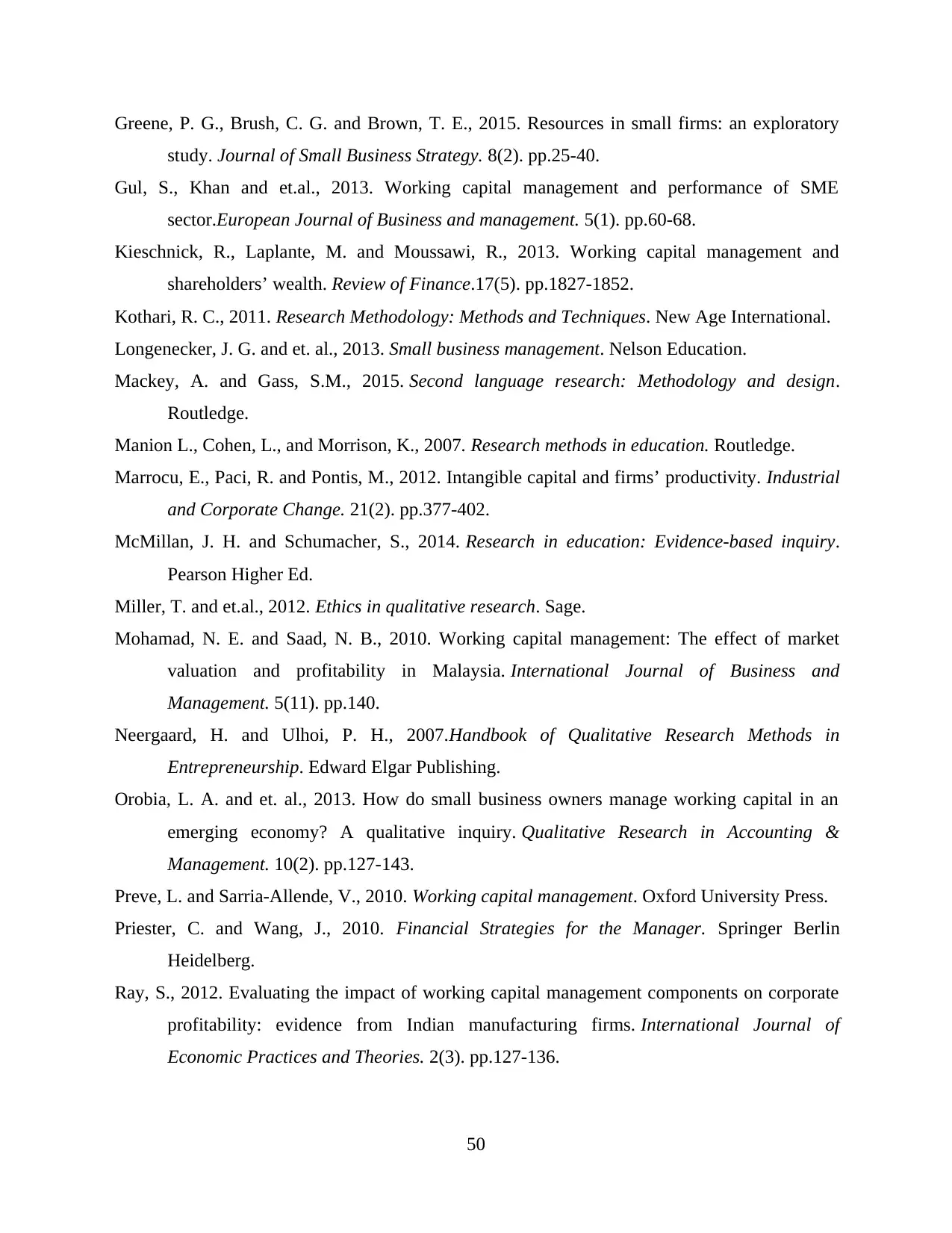
Greene, P. G., Brush, C. G. and Brown, T. E., 2015. Resources in small firms: an exploratory
study. Journal of Small Business Strategy. 8(2). pp.25-40.
Gul, S., Khan and et.al., 2013. Working capital management and performance of SME
sector.European Journal of Business and management. 5(1). pp.60-68.
Kieschnick, R., Laplante, M. and Moussawi, R., 2013. Working capital management and
shareholders’ wealth. Review of Finance.17(5). pp.1827-1852.
Kothari, R. C., 2011. Research Methodology: Methods and Techniques. New Age International.
Longenecker, J. G. and et. al., 2013. Small business management. Nelson Education.
Mackey, A. and Gass, S.M., 2015. Second language research: Methodology and design.
Routledge.
Manion L., Cohen, L., and Morrison, K., 2007. Research methods in education. Routledge.
Marrocu, E., Paci, R. and Pontis, M., 2012. Intangible capital and firms’ productivity. Industrial
and Corporate Change. 21(2). pp.377-402.
McMillan, J. H. and Schumacher, S., 2014. Research in education: Evidence-based inquiry.
Pearson Higher Ed.
Miller, T. and et.al., 2012. Ethics in qualitative research. Sage.
Mohamad, N. E. and Saad, N. B., 2010. Working capital management: The effect of market
valuation and profitability in Malaysia. International Journal of Business and
Management. 5(11). pp.140.
Neergaard, H. and Ulhoi, P. H., 2007.Handbook of Qualitative Research Methods in
Entrepreneurship. Edward Elgar Publishing.
Orobia, L. A. and et. al., 2013. How do small business owners manage working capital in an
emerging economy? A qualitative inquiry. Qualitative Research in Accounting &
Management. 10(2). pp.127-143.
Preve, L. and Sarria-Allende, V., 2010. Working capital management. Oxford University Press.
Priester, C. and Wang, J., 2010. Financial Strategies for the Manager. Springer Berlin
Heidelberg.
Ray, S., 2012. Evaluating the impact of working capital management components on corporate
profitability: evidence from Indian manufacturing firms. International Journal of
Economic Practices and Theories. 2(3). pp.127-136.
50
study. Journal of Small Business Strategy. 8(2). pp.25-40.
Gul, S., Khan and et.al., 2013. Working capital management and performance of SME
sector.European Journal of Business and management. 5(1). pp.60-68.
Kieschnick, R., Laplante, M. and Moussawi, R., 2013. Working capital management and
shareholders’ wealth. Review of Finance.17(5). pp.1827-1852.
Kothari, R. C., 2011. Research Methodology: Methods and Techniques. New Age International.
Longenecker, J. G. and et. al., 2013. Small business management. Nelson Education.
Mackey, A. and Gass, S.M., 2015. Second language research: Methodology and design.
Routledge.
Manion L., Cohen, L., and Morrison, K., 2007. Research methods in education. Routledge.
Marrocu, E., Paci, R. and Pontis, M., 2012. Intangible capital and firms’ productivity. Industrial
and Corporate Change. 21(2). pp.377-402.
McMillan, J. H. and Schumacher, S., 2014. Research in education: Evidence-based inquiry.
Pearson Higher Ed.
Miller, T. and et.al., 2012. Ethics in qualitative research. Sage.
Mohamad, N. E. and Saad, N. B., 2010. Working capital management: The effect of market
valuation and profitability in Malaysia. International Journal of Business and
Management. 5(11). pp.140.
Neergaard, H. and Ulhoi, P. H., 2007.Handbook of Qualitative Research Methods in
Entrepreneurship. Edward Elgar Publishing.
Orobia, L. A. and et. al., 2013. How do small business owners manage working capital in an
emerging economy? A qualitative inquiry. Qualitative Research in Accounting &
Management. 10(2). pp.127-143.
Preve, L. and Sarria-Allende, V., 2010. Working capital management. Oxford University Press.
Priester, C. and Wang, J., 2010. Financial Strategies for the Manager. Springer Berlin
Heidelberg.
Ray, S., 2012. Evaluating the impact of working capital management components on corporate
profitability: evidence from Indian manufacturing firms. International Journal of
Economic Practices and Theories. 2(3). pp.127-136.
50
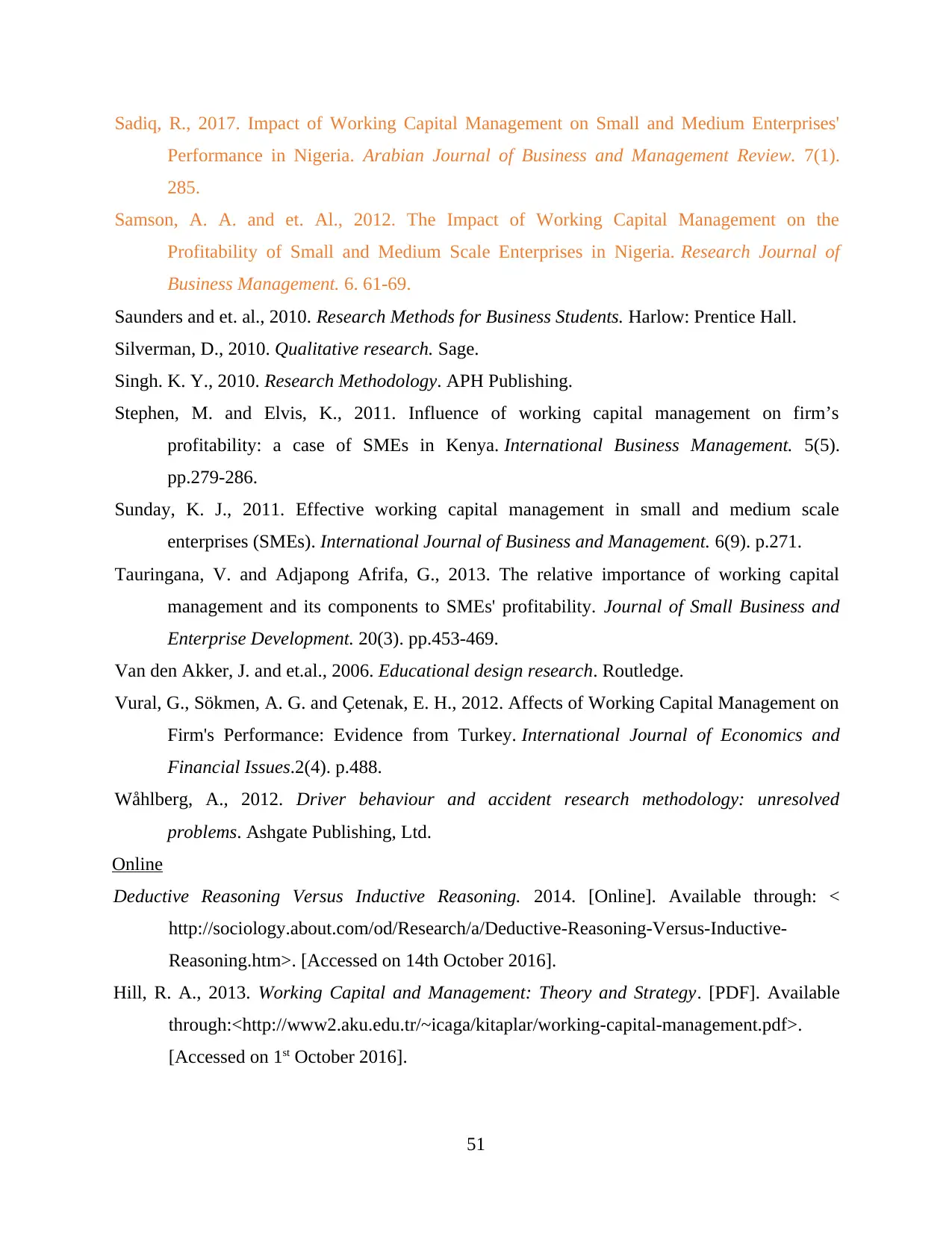
Sadiq, R., 2017. Impact of Working Capital Management on Small and Medium Enterprises'
Performance in Nigeria. Arabian Journal of Business and Management Review. 7(1).
285.
Samson, A. A. and et. Al., 2012. The Impact of Working Capital Management on the
Profitability of Small and Medium Scale Enterprises in Nigeria. Research Journal of
Business Management. 6. 61-69.
Saunders and et. al., 2010. Research Methods for Business Students. Harlow: Prentice Hall.
Silverman, D., 2010. Qualitative research. Sage.
Singh. K. Y., 2010. Research Methodology. APH Publishing.
Stephen, M. and Elvis, K., 2011. Influence of working capital management on firm’s
profitability: a case of SMEs in Kenya. International Business Management. 5(5).
pp.279-286.
Sunday, K. J., 2011. Effective working capital management in small and medium scale
enterprises (SMEs). International Journal of Business and Management. 6(9). p.271.
Tauringana, V. and Adjapong Afrifa, G., 2013. The relative importance of working capital
management and its components to SMEs' profitability. Journal of Small Business and
Enterprise Development. 20(3). pp.453-469.
Van den Akker, J. and et.al., 2006. Educational design research. Routledge.
Vural, G., Sökmen, A. G. and Çetenak, E. H., 2012. Affects of Working Capital Management on
Firm's Performance: Evidence from Turkey. International Journal of Economics and
Financial Issues.2(4). p.488.
Wåhlberg, A., 2012. Driver behaviour and accident research methodology: unresolved
problems. Ashgate Publishing, Ltd.
Online
Deductive Reasoning Versus Inductive Reasoning. 2014. [Online]. Available through: <
http://sociology.about.com/od/Research/a/Deductive-Reasoning-Versus-Inductive-
Reasoning.htm>. [Accessed on 14th October 2016].
Hill, R. A., 2013. Working Capital and Management: Theory and Strategy. [PDF]. Available
through:<http://www2.aku.edu.tr/~icaga/kitaplar/working-capital-management.pdf>.
[Accessed on 1st October 2016].
51
Performance in Nigeria. Arabian Journal of Business and Management Review. 7(1).
285.
Samson, A. A. and et. Al., 2012. The Impact of Working Capital Management on the
Profitability of Small and Medium Scale Enterprises in Nigeria. Research Journal of
Business Management. 6. 61-69.
Saunders and et. al., 2010. Research Methods for Business Students. Harlow: Prentice Hall.
Silverman, D., 2010. Qualitative research. Sage.
Singh. K. Y., 2010. Research Methodology. APH Publishing.
Stephen, M. and Elvis, K., 2011. Influence of working capital management on firm’s
profitability: a case of SMEs in Kenya. International Business Management. 5(5).
pp.279-286.
Sunday, K. J., 2011. Effective working capital management in small and medium scale
enterprises (SMEs). International Journal of Business and Management. 6(9). p.271.
Tauringana, V. and Adjapong Afrifa, G., 2013. The relative importance of working capital
management and its components to SMEs' profitability. Journal of Small Business and
Enterprise Development. 20(3). pp.453-469.
Van den Akker, J. and et.al., 2006. Educational design research. Routledge.
Vural, G., Sökmen, A. G. and Çetenak, E. H., 2012. Affects of Working Capital Management on
Firm's Performance: Evidence from Turkey. International Journal of Economics and
Financial Issues.2(4). p.488.
Wåhlberg, A., 2012. Driver behaviour and accident research methodology: unresolved
problems. Ashgate Publishing, Ltd.
Online
Deductive Reasoning Versus Inductive Reasoning. 2014. [Online]. Available through: <
http://sociology.about.com/od/Research/a/Deductive-Reasoning-Versus-Inductive-
Reasoning.htm>. [Accessed on 14th October 2016].
Hill, R. A., 2013. Working Capital and Management: Theory and Strategy. [PDF]. Available
through:<http://www2.aku.edu.tr/~icaga/kitaplar/working-capital-management.pdf>.
[Accessed on 1st October 2016].
51

Research design. 2009. [PDF]. Available through:
<http://www.sagepub.com/upm-data/28285_02_Boeije_Ch_02.pdf>. [Accessed on 21st
October 2016].
Saleem, H., 2008. INDUCTIVE & DEDUCTIVE RESEARCH APPROACH. [pdf]. Available
through: <http://www.drburney.net/INDUCTIVE%20&%20DEDUCTIVE
%20RESEARCH%20APPROACH%2006032008.pdf> [Accessed on 21st October 2016].
52
<http://www.sagepub.com/upm-data/28285_02_Boeije_Ch_02.pdf>. [Accessed on 21st
October 2016].
Saleem, H., 2008. INDUCTIVE & DEDUCTIVE RESEARCH APPROACH. [pdf]. Available
through: <http://www.drburney.net/INDUCTIVE%20&%20DEDUCTIVE
%20RESEARCH%20APPROACH%2006032008.pdf> [Accessed on 21st October 2016].
52
Secure Best Marks with AI Grader
Need help grading? Try our AI Grader for instant feedback on your assignments.
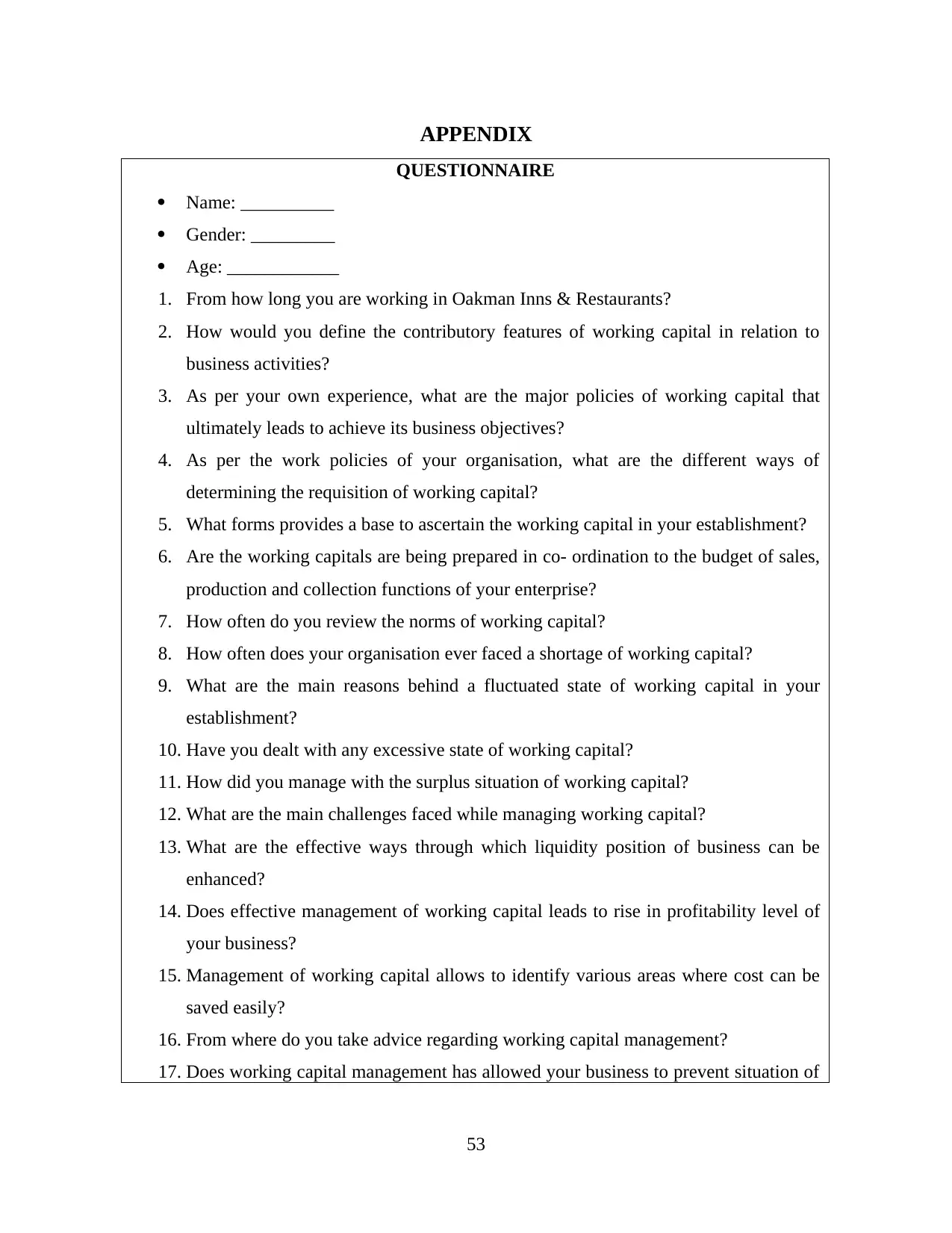
APPENDIX
QUESTIONNAIRE
Name: __________
Gender: _________
Age: ____________
1. From how long you are working in Oakman Inns & Restaurants?
2. How would you define the contributory features of working capital in relation to
business activities?
3. As per your own experience, what are the major policies of working capital that
ultimately leads to achieve its business objectives?
4. As per the work policies of your organisation, what are the different ways of
determining the requisition of working capital?
5. What forms provides a base to ascertain the working capital in your establishment?
6. Are the working capitals are being prepared in co- ordination to the budget of sales,
production and collection functions of your enterprise?
7. How often do you review the norms of working capital?
8. How often does your organisation ever faced a shortage of working capital?
9. What are the main reasons behind a fluctuated state of working capital in your
establishment?
10. Have you dealt with any excessive state of working capital?
11. How did you manage with the surplus situation of working capital?
12. What are the main challenges faced while managing working capital?
13. What are the effective ways through which liquidity position of business can be
enhanced?
14. Does effective management of working capital leads to rise in profitability level of
your business?
15. Management of working capital allows to identify various areas where cost can be
saved easily?
16. From where do you take advice regarding working capital management?
17. Does working capital management has allowed your business to prevent situation of
53
QUESTIONNAIRE
Name: __________
Gender: _________
Age: ____________
1. From how long you are working in Oakman Inns & Restaurants?
2. How would you define the contributory features of working capital in relation to
business activities?
3. As per your own experience, what are the major policies of working capital that
ultimately leads to achieve its business objectives?
4. As per the work policies of your organisation, what are the different ways of
determining the requisition of working capital?
5. What forms provides a base to ascertain the working capital in your establishment?
6. Are the working capitals are being prepared in co- ordination to the budget of sales,
production and collection functions of your enterprise?
7. How often do you review the norms of working capital?
8. How often does your organisation ever faced a shortage of working capital?
9. What are the main reasons behind a fluctuated state of working capital in your
establishment?
10. Have you dealt with any excessive state of working capital?
11. How did you manage with the surplus situation of working capital?
12. What are the main challenges faced while managing working capital?
13. What are the effective ways through which liquidity position of business can be
enhanced?
14. Does effective management of working capital leads to rise in profitability level of
your business?
15. Management of working capital allows to identify various areas where cost can be
saved easily?
16. From where do you take advice regarding working capital management?
17. Does working capital management has allowed your business to prevent situation of
53
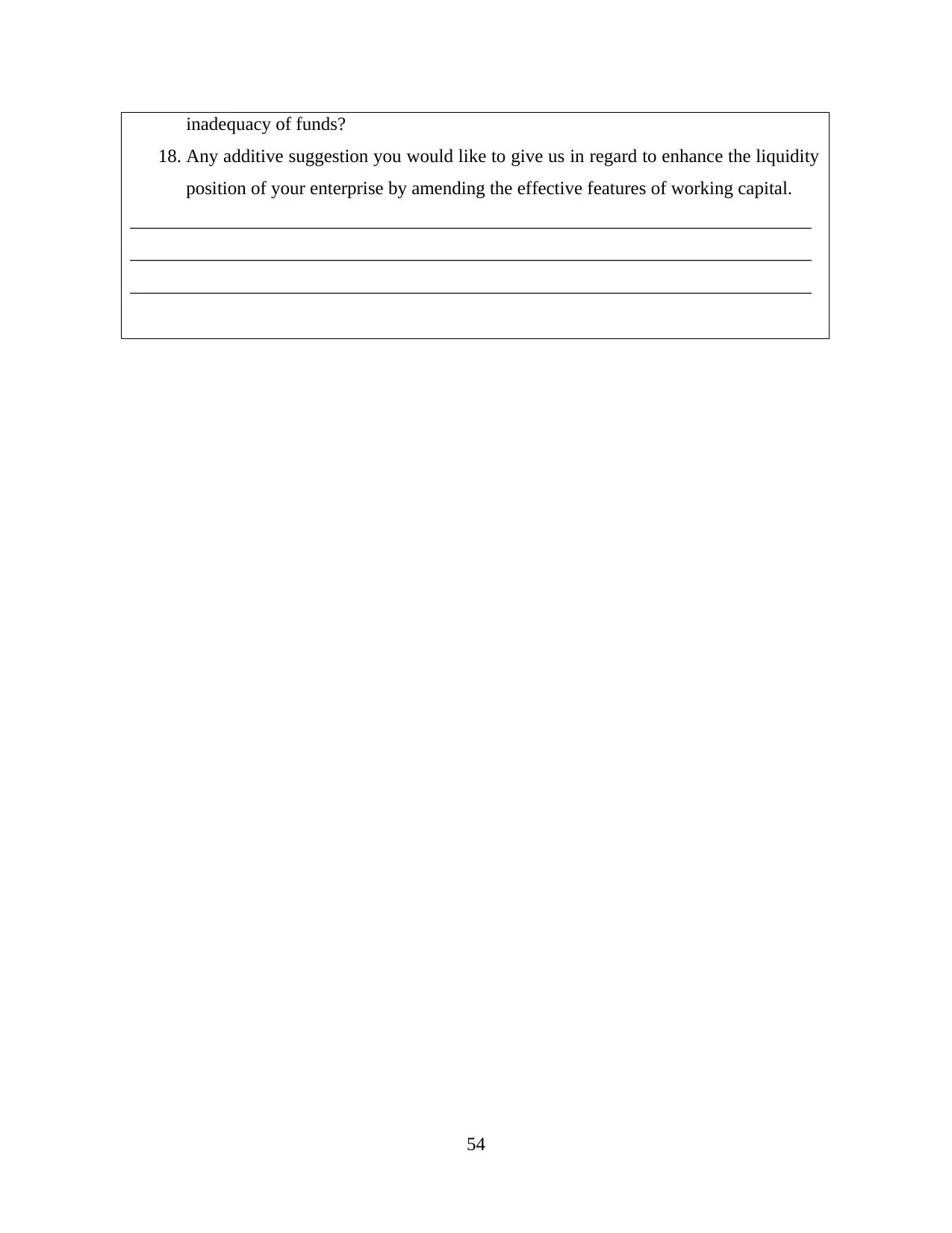
inadequacy of funds?
18. Any additive suggestion you would like to give us in regard to enhance the liquidity
position of your enterprise by amending the effective features of working capital.
_________________________________________________________________________
_________________________________________________________________________
_________________________________________________________________________
54
18. Any additive suggestion you would like to give us in regard to enhance the liquidity
position of your enterprise by amending the effective features of working capital.
_________________________________________________________________________
_________________________________________________________________________
_________________________________________________________________________
54
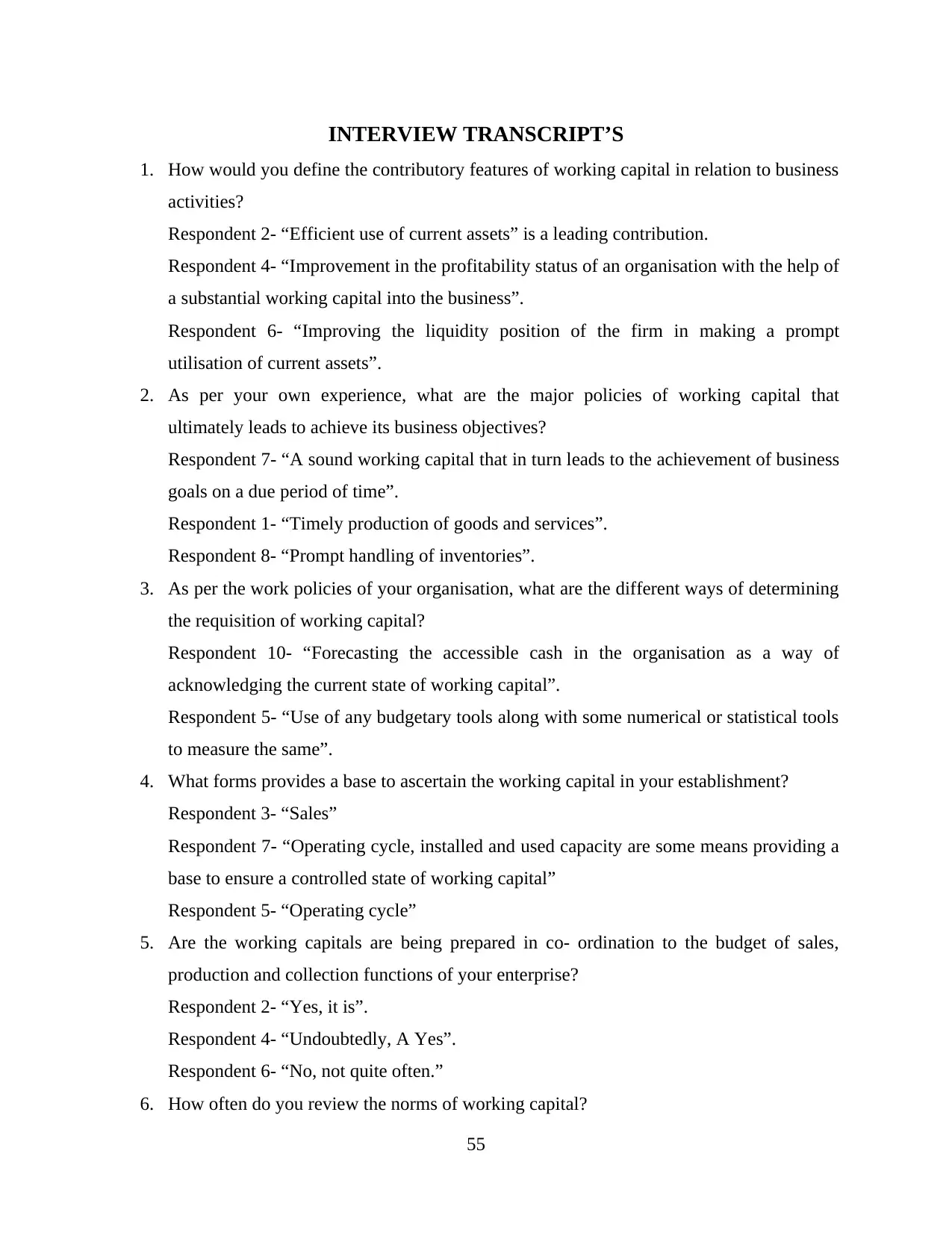
INTERVIEW TRANSCRIPT’S
1. How would you define the contributory features of working capital in relation to business
activities?
Respondent 2- “Efficient use of current assets” is a leading contribution.
Respondent 4- “Improvement in the profitability status of an organisation with the help of
a substantial working capital into the business”.
Respondent 6- “Improving the liquidity position of the firm in making a prompt
utilisation of current assets”.
2. As per your own experience, what are the major policies of working capital that
ultimately leads to achieve its business objectives?
Respondent 7- “A sound working capital that in turn leads to the achievement of business
goals on a due period of time”.
Respondent 1- “Timely production of goods and services”.
Respondent 8- “Prompt handling of inventories”.
3. As per the work policies of your organisation, what are the different ways of determining
the requisition of working capital?
Respondent 10- “Forecasting the accessible cash in the organisation as a way of
acknowledging the current state of working capital”.
Respondent 5- “Use of any budgetary tools along with some numerical or statistical tools
to measure the same”.
4. What forms provides a base to ascertain the working capital in your establishment?
Respondent 3- “Sales”
Respondent 7- “Operating cycle, installed and used capacity are some means providing a
base to ensure a controlled state of working capital”
Respondent 5- “Operating cycle”
5. Are the working capitals are being prepared in co- ordination to the budget of sales,
production and collection functions of your enterprise?
Respondent 2- “Yes, it is”.
Respondent 4- “Undoubtedly, A Yes”.
Respondent 6- “No, not quite often.”
6. How often do you review the norms of working capital?
55
1. How would you define the contributory features of working capital in relation to business
activities?
Respondent 2- “Efficient use of current assets” is a leading contribution.
Respondent 4- “Improvement in the profitability status of an organisation with the help of
a substantial working capital into the business”.
Respondent 6- “Improving the liquidity position of the firm in making a prompt
utilisation of current assets”.
2. As per your own experience, what are the major policies of working capital that
ultimately leads to achieve its business objectives?
Respondent 7- “A sound working capital that in turn leads to the achievement of business
goals on a due period of time”.
Respondent 1- “Timely production of goods and services”.
Respondent 8- “Prompt handling of inventories”.
3. As per the work policies of your organisation, what are the different ways of determining
the requisition of working capital?
Respondent 10- “Forecasting the accessible cash in the organisation as a way of
acknowledging the current state of working capital”.
Respondent 5- “Use of any budgetary tools along with some numerical or statistical tools
to measure the same”.
4. What forms provides a base to ascertain the working capital in your establishment?
Respondent 3- “Sales”
Respondent 7- “Operating cycle, installed and used capacity are some means providing a
base to ensure a controlled state of working capital”
Respondent 5- “Operating cycle”
5. Are the working capitals are being prepared in co- ordination to the budget of sales,
production and collection functions of your enterprise?
Respondent 2- “Yes, it is”.
Respondent 4- “Undoubtedly, A Yes”.
Respondent 6- “No, not quite often.”
6. How often do you review the norms of working capital?
55
Paraphrase This Document
Need a fresh take? Get an instant paraphrase of this document with our AI Paraphraser
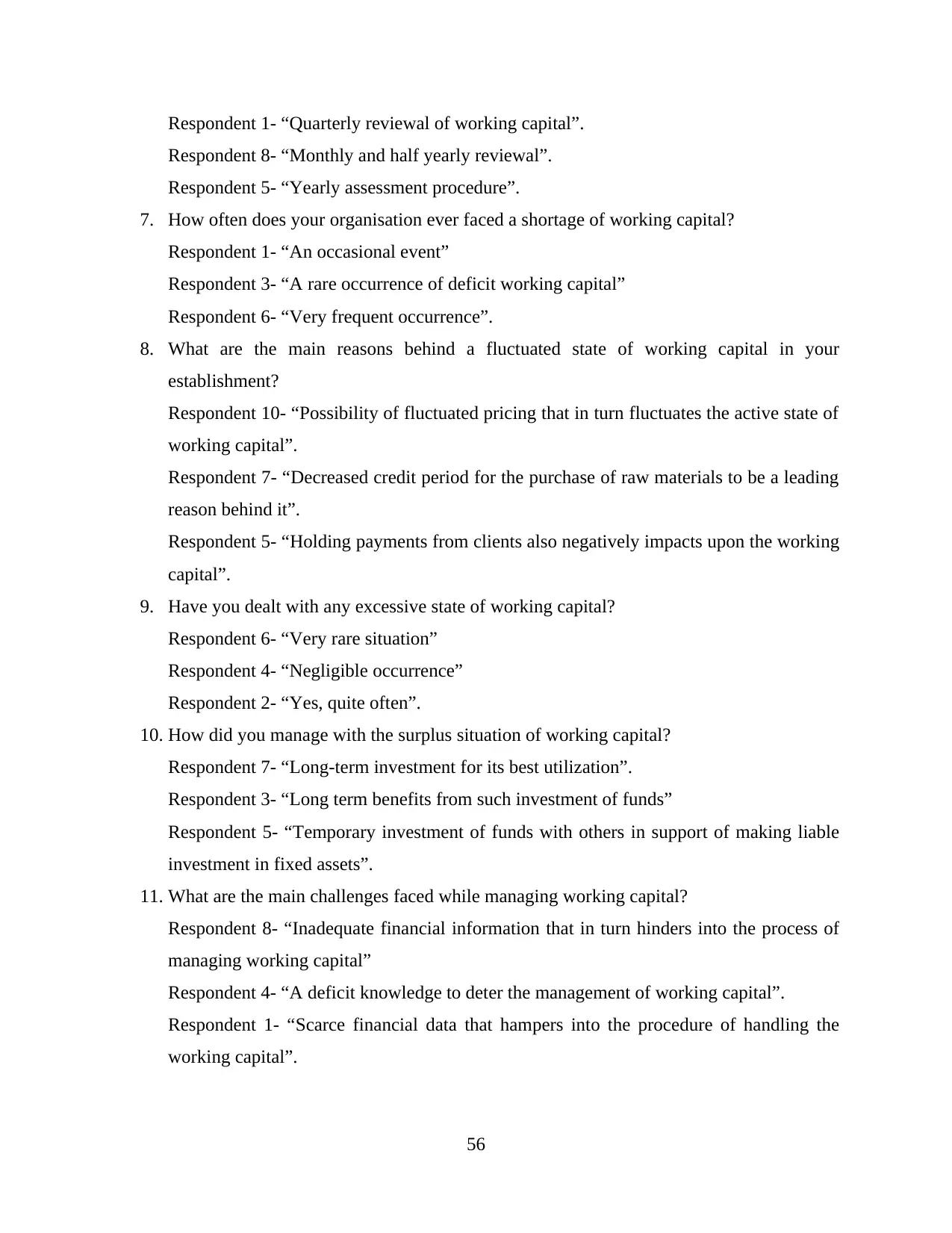
Respondent 1- “Quarterly reviewal of working capital”.
Respondent 8- “Monthly and half yearly reviewal”.
Respondent 5- “Yearly assessment procedure”.
7. How often does your organisation ever faced a shortage of working capital?
Respondent 1- “An occasional event”
Respondent 3- “A rare occurrence of deficit working capital”
Respondent 6- “Very frequent occurrence”.
8. What are the main reasons behind a fluctuated state of working capital in your
establishment?
Respondent 10- “Possibility of fluctuated pricing that in turn fluctuates the active state of
working capital”.
Respondent 7- “Decreased credit period for the purchase of raw materials to be a leading
reason behind it”.
Respondent 5- “Holding payments from clients also negatively impacts upon the working
capital”.
9. Have you dealt with any excessive state of working capital?
Respondent 6- “Very rare situation”
Respondent 4- “Negligible occurrence”
Respondent 2- “Yes, quite often”.
10. How did you manage with the surplus situation of working capital?
Respondent 7- “Long-term investment for its best utilization”.
Respondent 3- “Long term benefits from such investment of funds”
Respondent 5- “Temporary investment of funds with others in support of making liable
investment in fixed assets”.
11. What are the main challenges faced while managing working capital?
Respondent 8- “Inadequate financial information that in turn hinders into the process of
managing working capital”
Respondent 4- “A deficit knowledge to deter the management of working capital”.
Respondent 1- “Scarce financial data that hampers into the procedure of handling the
working capital”.
56
Respondent 8- “Monthly and half yearly reviewal”.
Respondent 5- “Yearly assessment procedure”.
7. How often does your organisation ever faced a shortage of working capital?
Respondent 1- “An occasional event”
Respondent 3- “A rare occurrence of deficit working capital”
Respondent 6- “Very frequent occurrence”.
8. What are the main reasons behind a fluctuated state of working capital in your
establishment?
Respondent 10- “Possibility of fluctuated pricing that in turn fluctuates the active state of
working capital”.
Respondent 7- “Decreased credit period for the purchase of raw materials to be a leading
reason behind it”.
Respondent 5- “Holding payments from clients also negatively impacts upon the working
capital”.
9. Have you dealt with any excessive state of working capital?
Respondent 6- “Very rare situation”
Respondent 4- “Negligible occurrence”
Respondent 2- “Yes, quite often”.
10. How did you manage with the surplus situation of working capital?
Respondent 7- “Long-term investment for its best utilization”.
Respondent 3- “Long term benefits from such investment of funds”
Respondent 5- “Temporary investment of funds with others in support of making liable
investment in fixed assets”.
11. What are the main challenges faced while managing working capital?
Respondent 8- “Inadequate financial information that in turn hinders into the process of
managing working capital”
Respondent 4- “A deficit knowledge to deter the management of working capital”.
Respondent 1- “Scarce financial data that hampers into the procedure of handling the
working capital”.
56
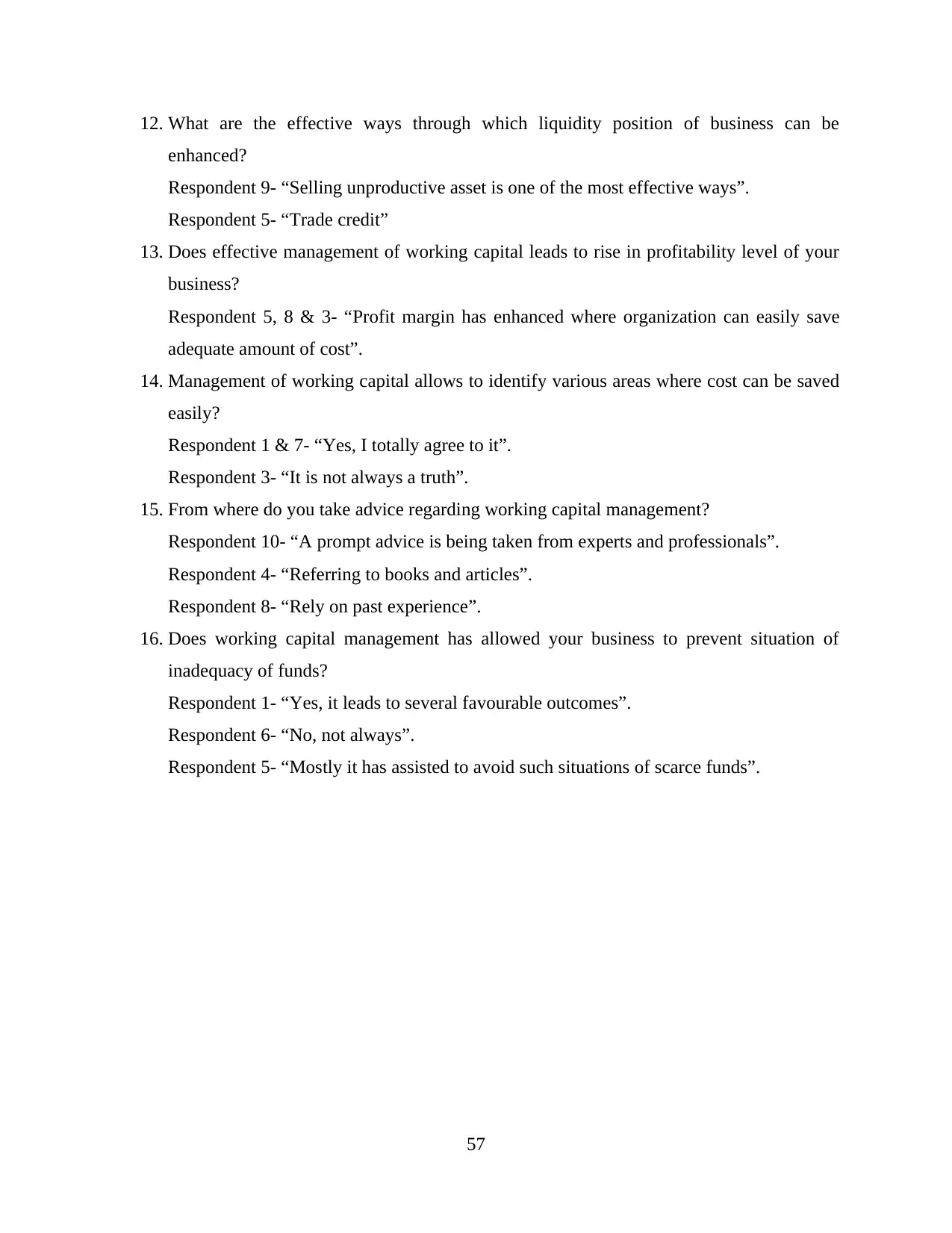
12. What are the effective ways through which liquidity position of business can be
enhanced?
Respondent 9- “Selling unproductive asset is one of the most effective ways”.
Respondent 5- “Trade credit”
13. Does effective management of working capital leads to rise in profitability level of your
business?
Respondent 5, 8 & 3- “Profit margin has enhanced where organization can easily save
adequate amount of cost”.
14. Management of working capital allows to identify various areas where cost can be saved
easily?
Respondent 1 & 7- “Yes, I totally agree to it”.
Respondent 3- “It is not always a truth”.
15. From where do you take advice regarding working capital management?
Respondent 10- “A prompt advice is being taken from experts and professionals”.
Respondent 4- “Referring to books and articles”.
Respondent 8- “Rely on past experience”.
16. Does working capital management has allowed your business to prevent situation of
inadequacy of funds?
Respondent 1- “Yes, it leads to several favourable outcomes”.
Respondent 6- “No, not always”.
Respondent 5- “Mostly it has assisted to avoid such situations of scarce funds”.
57
enhanced?
Respondent 9- “Selling unproductive asset is one of the most effective ways”.
Respondent 5- “Trade credit”
13. Does effective management of working capital leads to rise in profitability level of your
business?
Respondent 5, 8 & 3- “Profit margin has enhanced where organization can easily save
adequate amount of cost”.
14. Management of working capital allows to identify various areas where cost can be saved
easily?
Respondent 1 & 7- “Yes, I totally agree to it”.
Respondent 3- “It is not always a truth”.
15. From where do you take advice regarding working capital management?
Respondent 10- “A prompt advice is being taken from experts and professionals”.
Respondent 4- “Referring to books and articles”.
Respondent 8- “Rely on past experience”.
16. Does working capital management has allowed your business to prevent situation of
inadequacy of funds?
Respondent 1- “Yes, it leads to several favourable outcomes”.
Respondent 6- “No, not always”.
Respondent 5- “Mostly it has assisted to avoid such situations of scarce funds”.
57
1 out of 57
Related Documents
Your All-in-One AI-Powered Toolkit for Academic Success.
+13062052269
info@desklib.com
Available 24*7 on WhatsApp / Email
![[object Object]](/_next/static/media/star-bottom.7253800d.svg)
Unlock your academic potential
© 2024 | Zucol Services PVT LTD | All rights reserved.





